Cracking the New SAT with 4 Practice Tests, 2016 Edition (2015)
Part VII. Practice Tests
Chapter 20. Practice Test 1
Click here to download a PDF for Practice Test 1.

Reading Test
65 MINUTES, 52 QUESTIONS
Turn to Section 1 of your answer sheet to answer the questions in this section.
DIRECTIONS
Each passage or pair of passages below is followed by a number of questions. After reading each passage or pair, choose the best answer to each question based on what is stated or implied in the passage or passages and in any accompanying graphics (such as a table or graph).
Questions 1-10 are based on the following passage.
The passage that follows is adapted from an 1859 novel that follows the lives of both English and French characters during the French Revolution.
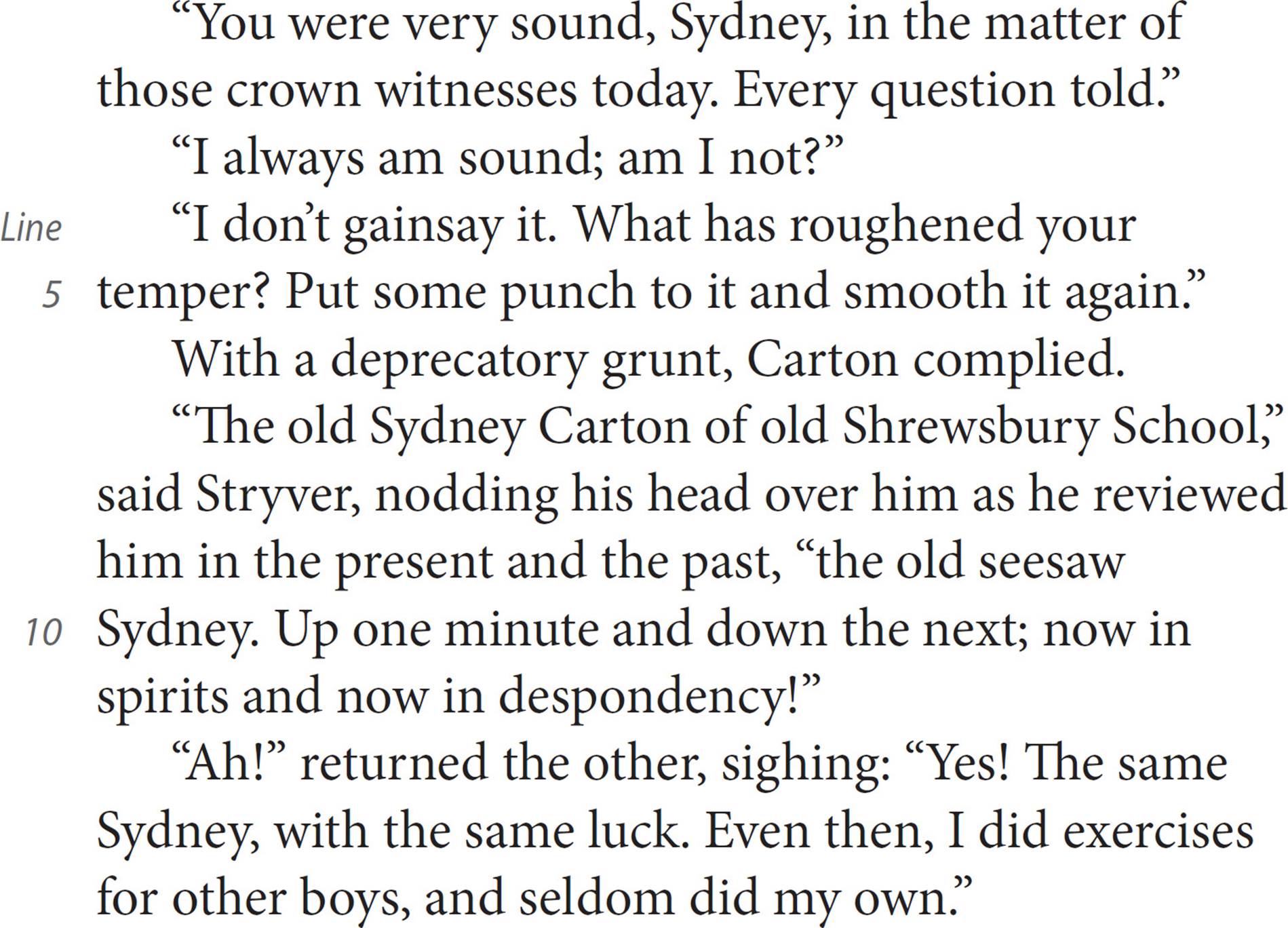
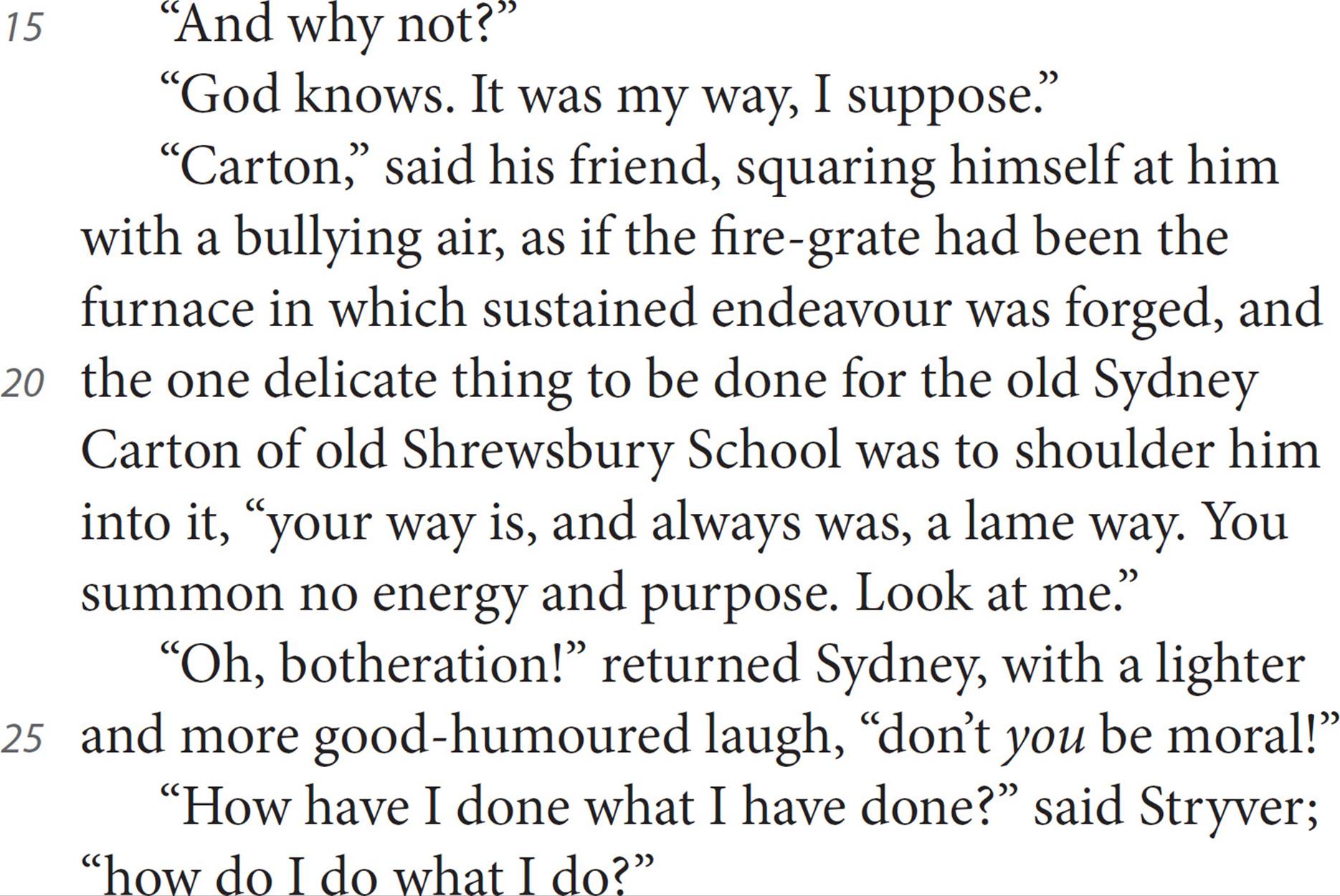
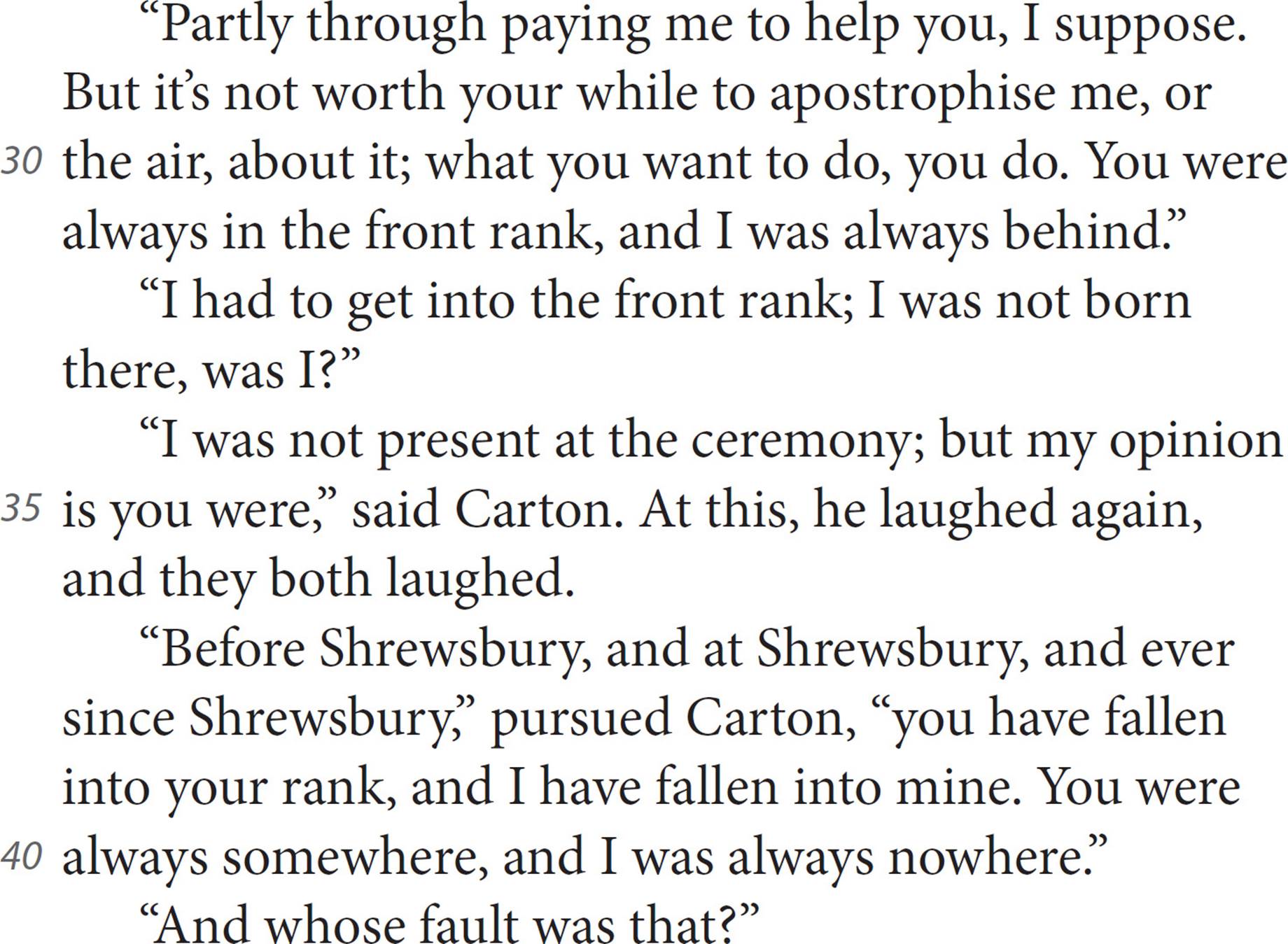
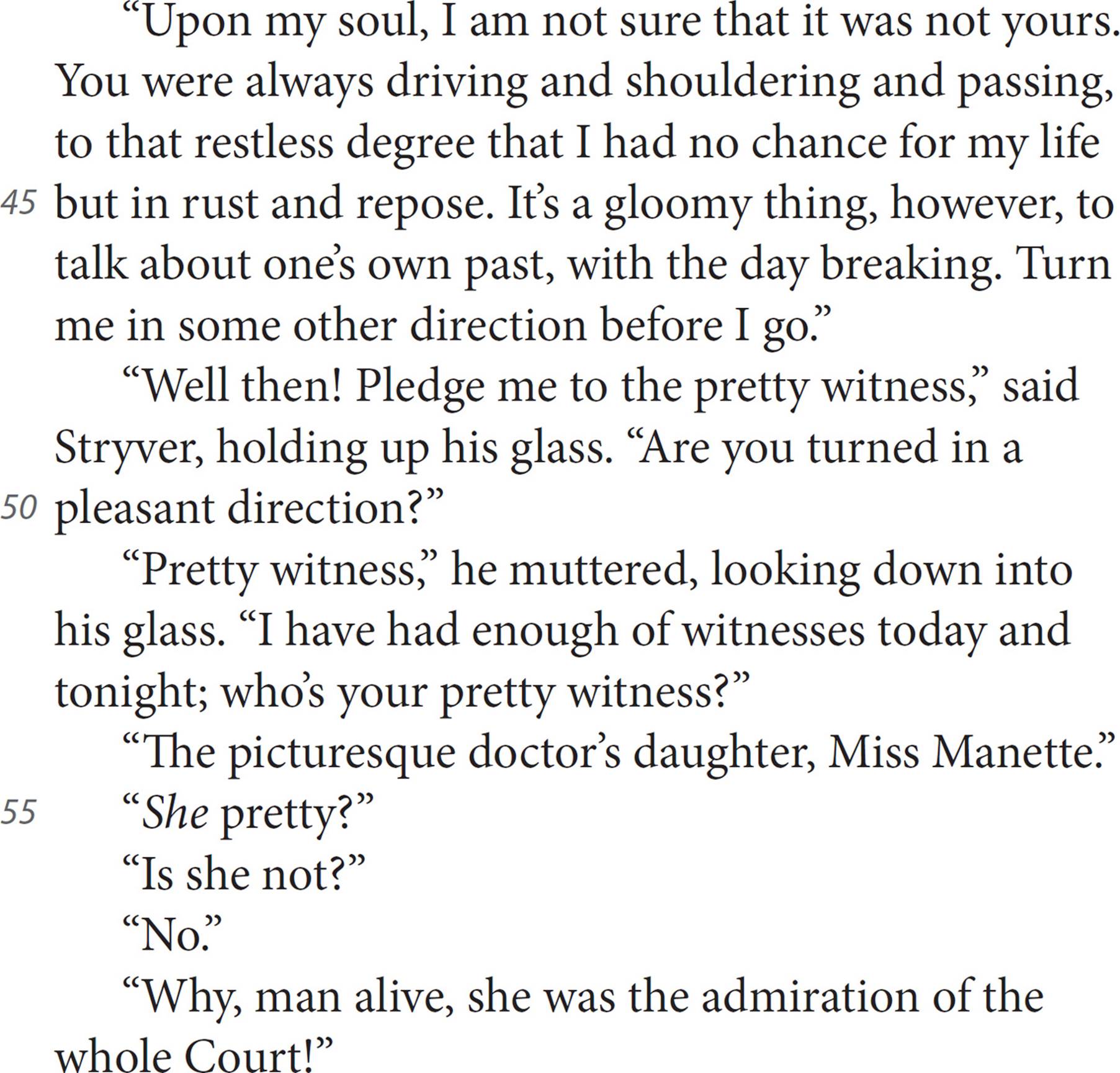
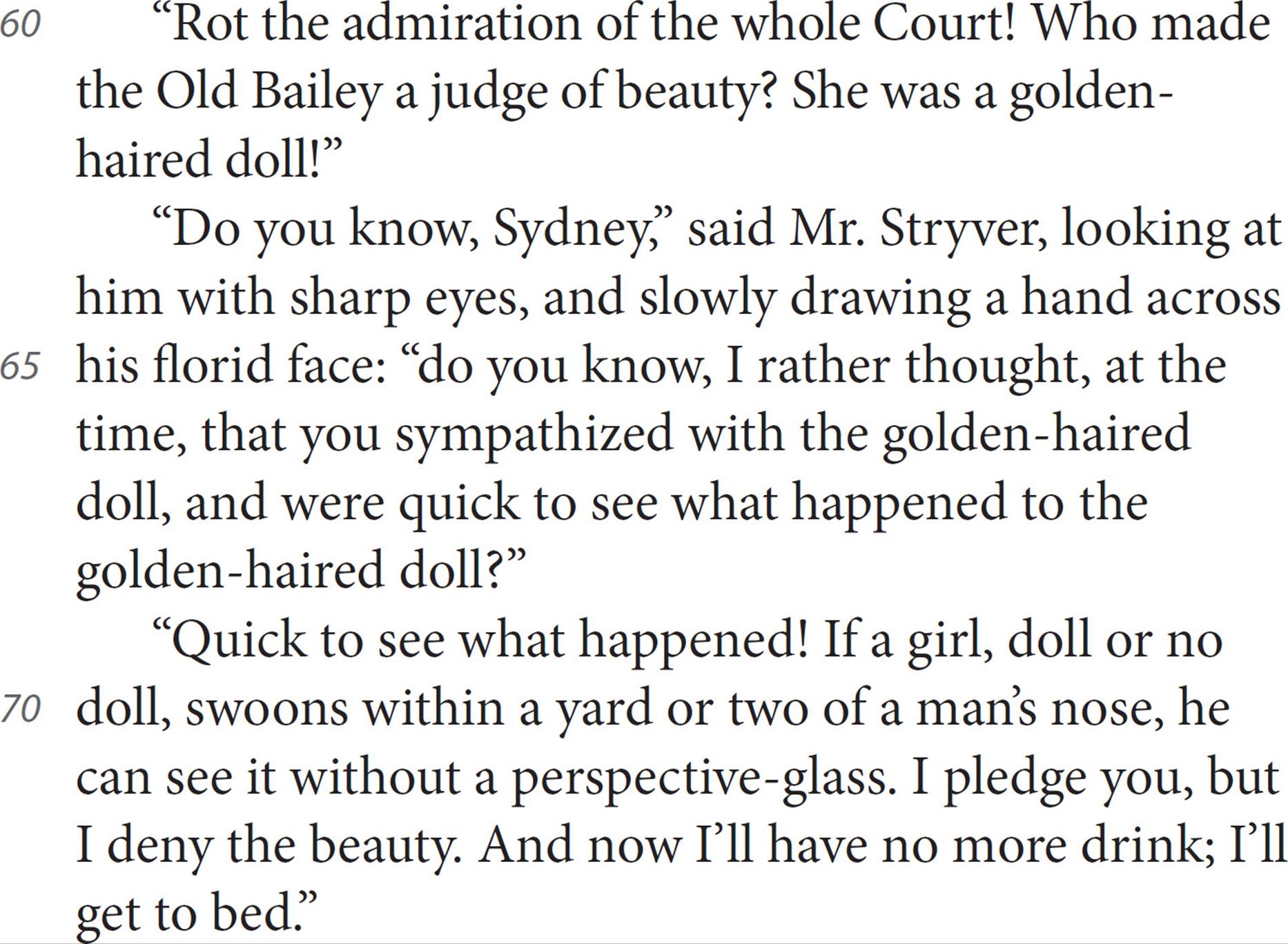
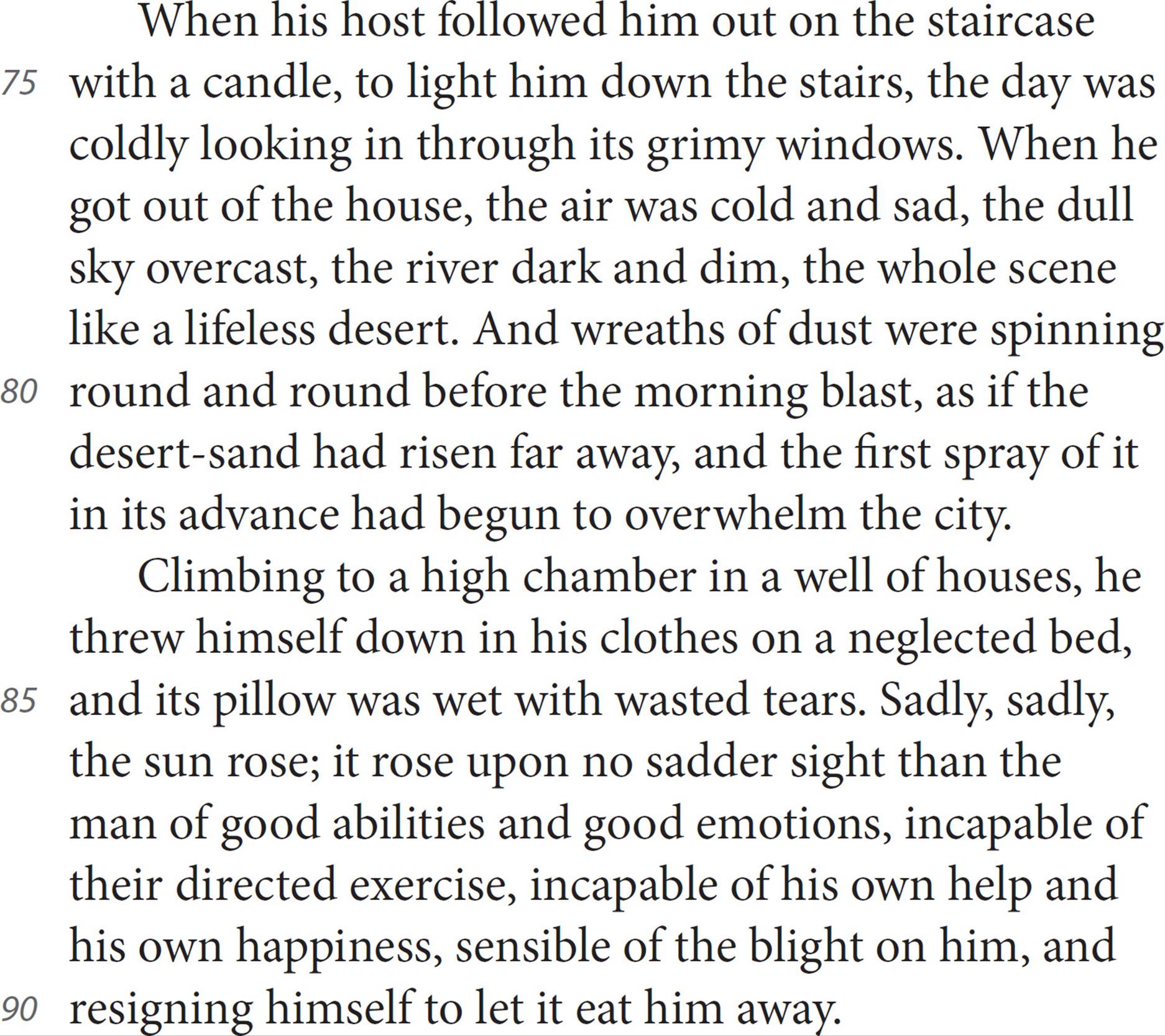
1.The primary purpose of the passage as a whole is to
A)describe the history between Carton and Stryver.
B)characterize life at the Shrewsbury School.
C)reveal Carton’s character.
D)show that Stryver has been exploiting Carton.
2.Based on the information in the passage, Carton is best characterized as
A)unsound.
B)mercurial.
C)unlucky.
D)imperceptive.
3.Which choice provides the best evidence for the answer to the previous question?
A)Lines 10-11 (“Up…despondency”)
B)Lines 13-14 (“Even…own”)
C)Lines 35-36 (“At this…laughed”)
D)Lines 45-46 (“It’s a…breaking”)
4.As used in line 11, “spirits” most nearly means
A)soul.
B)liquor.
C)essence.
D)jubilation.
5.Based on lines 17-22 (“squaring himself….shoulder him into it”), it can be reasonably inferred that
A)Stryver is frustrated with Carton’s behavior.
B)Stryver is planning to push Carton into the fireplace.
C)Stryver believes Carton to be comparatively older.
D)Stryver wishes to bully Carton as he did at Shrewsbury.
6.The use of italics in line 55 primarily serves to emphasize Carton’s
A)incredulity.
B)confusion.
C)annoyance.
D)affection.
7.The passage suggests which of the following about Stryver?
A)He is in love with Miss Manette.
B)He believes that Carton lacks the intelligence required to be successful.
C)He does not believe that Carton finds Miss Manette unattractive.
D)He was born into a wealthy family.
8.Which choice provides the best evidence for the answer to the previous question?
A)Lines 32-33 (“I had…was I”)
B)Line 41 (“And whose…that”)
C)Lines 58-59 (“Why…Court”)
D)Lines 63-68 (“Do you…doll”)
9.In context, “desert” in line 79 refers to
A)Styver’s cold demeanor.
B)London’s landscape.
C)Carton’s windows.
D)sunlit dunes.
10.The “tears” referred to in line 85 are “wasted” because
A)Miss Manette will never love Carton.
B)Carton is unlikely to change his ways.
C)Carton’s home is one of squalor.
D)Stryver will continue to exploit Carton’s labor.
Questions 11-21 are based on the following passage.
This passage is adapted from Priit Vesilind, The Singing Revolution. © 2008 by Sky Films Incorporated.
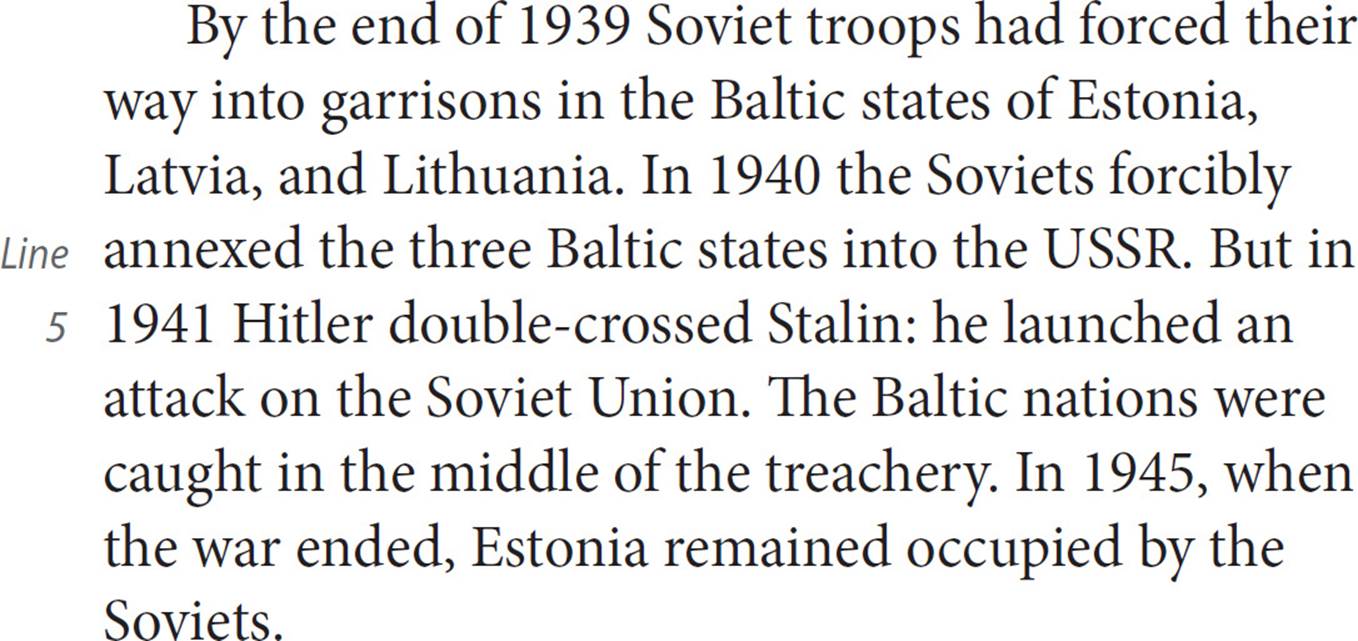

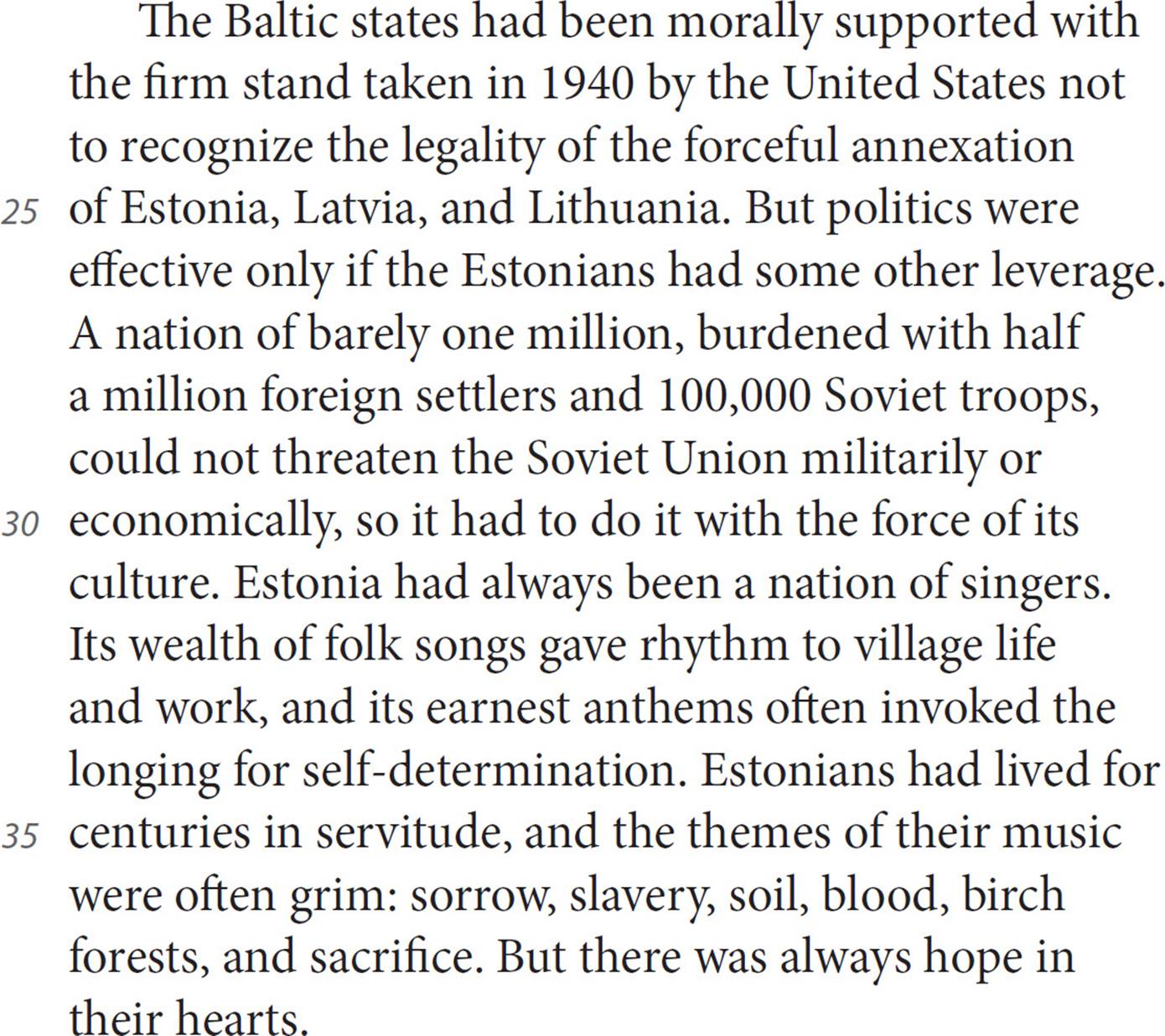

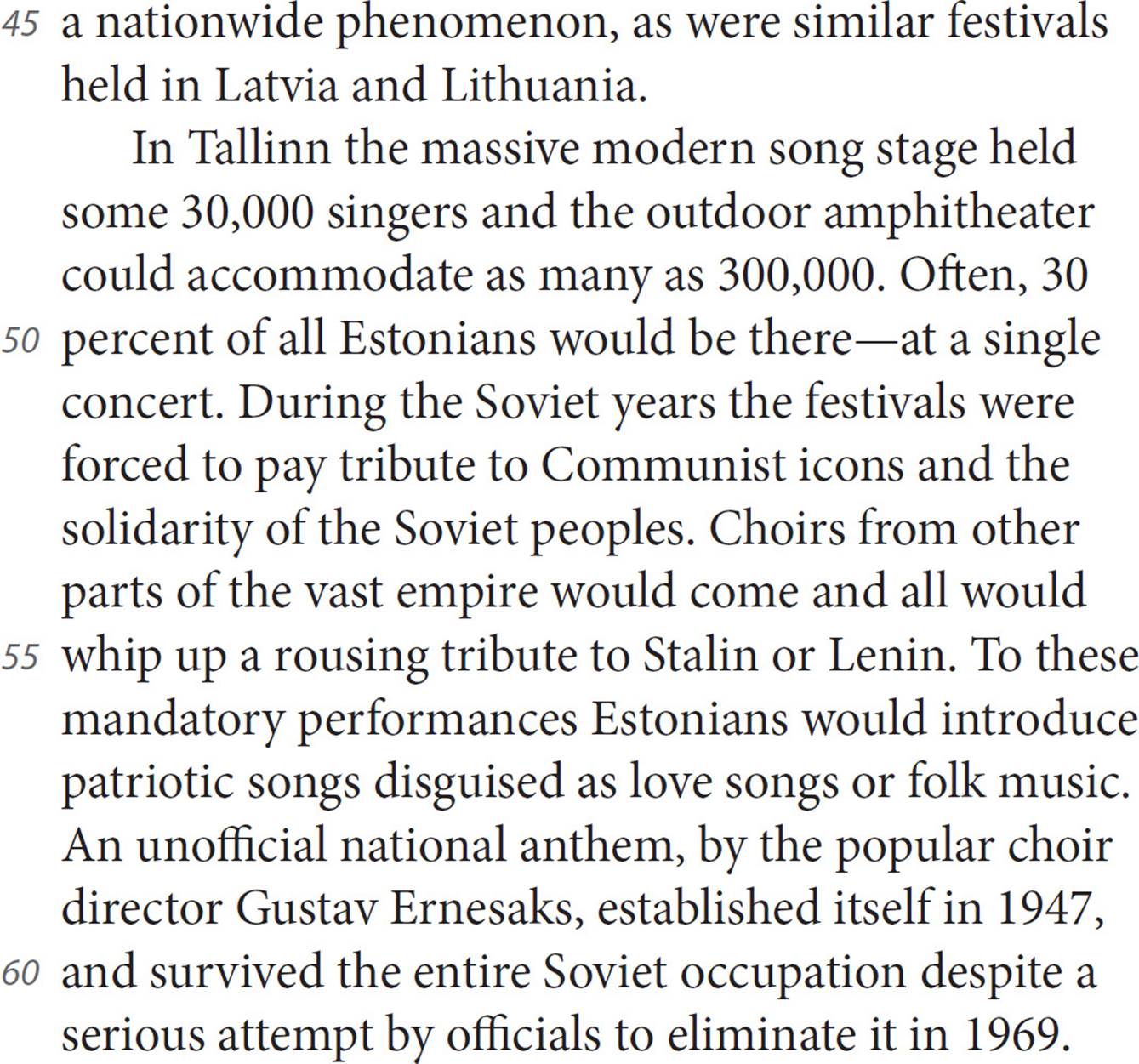
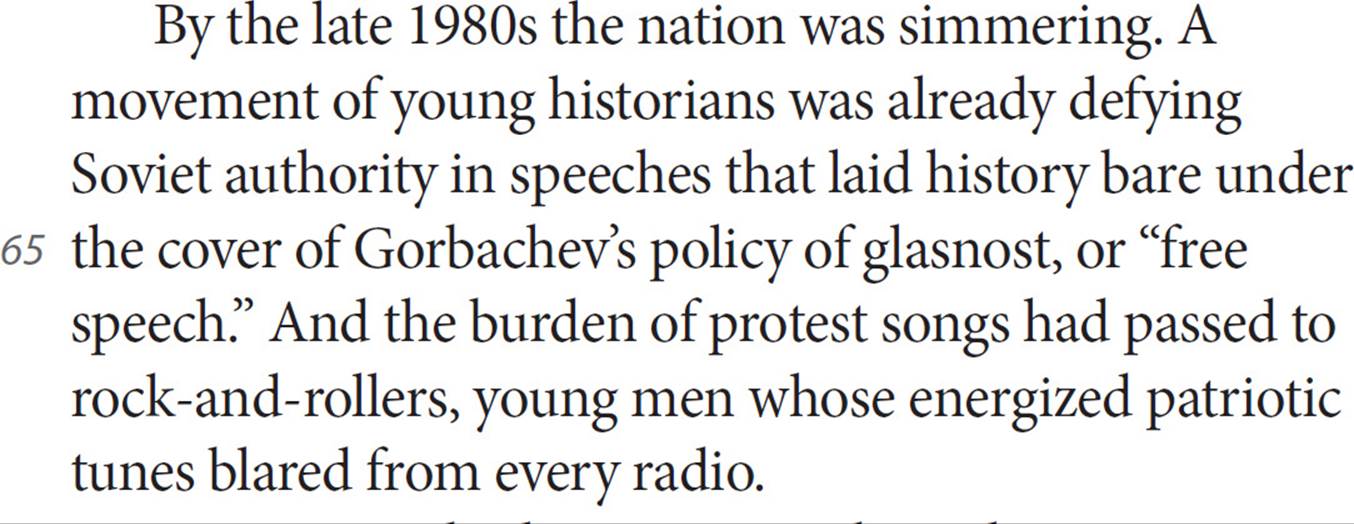
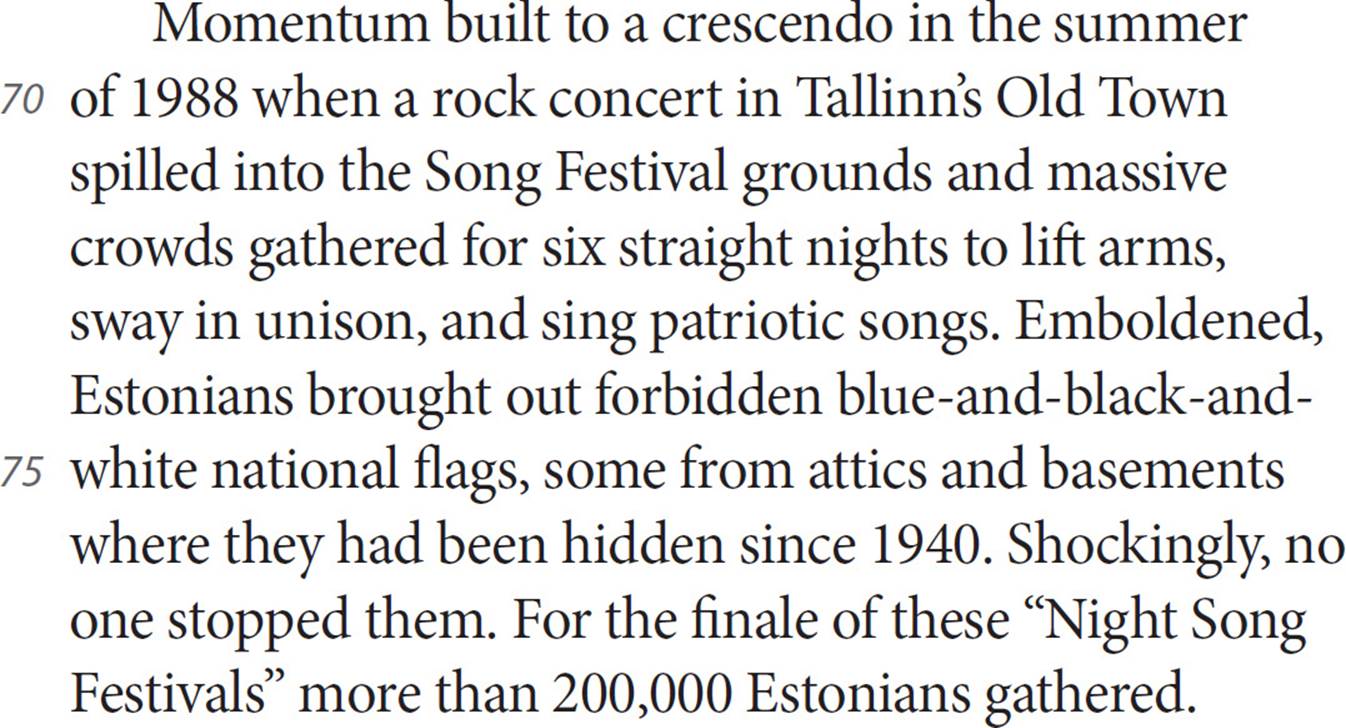

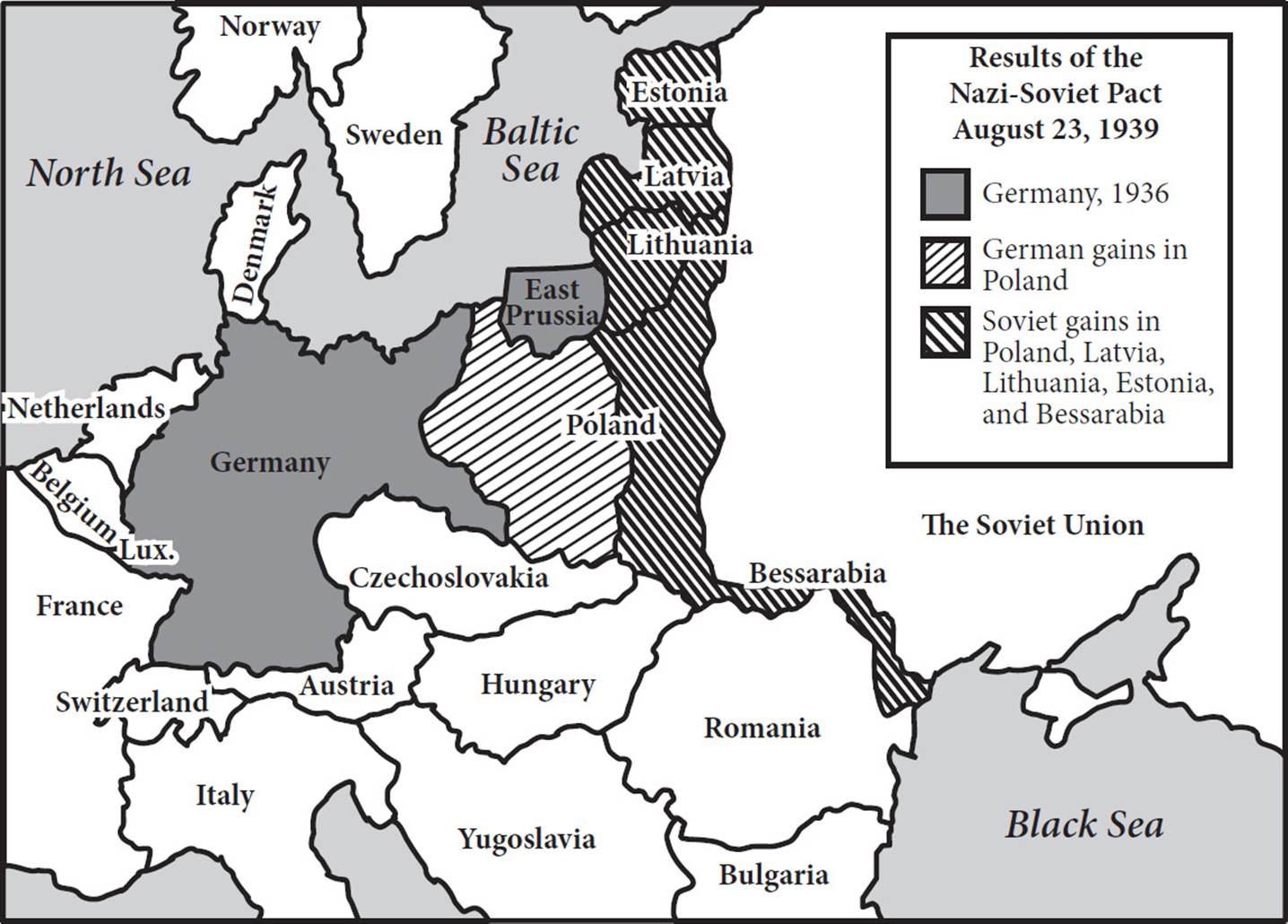
Diagram of Europe following the Nazi-Soviet Pact of 1939, also known as the Molotov-Ribbentrop Pact. Image adapted from CQ Researcher.
11.The point of view from which the passage is written is best described as
A)condemnatory of the Soviet Union’s treacherous actions.
B)sympathetic to the Baltic states’ struggle for freedom.
C)dismissive of the idea of non-violent revolution.
D)conflicted about the underlying cause of the revolution.
12.As used in line 18, “collusion” most nearly means
A)conspiracy.
B)impact.
C)separation.
D)danger.
13.In lines 33-36, the author draws a distinction between
A)the tone of Estonian songs and the people’s true feelings.
B)the themes of Estonian folk songs and anthems.
C)the military strength of Estonia and that of the Soviet Union.
D)song festivals in Estonia and those in Latvia and Lithuania.
14.In the context of the passage, the phrase “their reluctance to be absorbed” suggests that Estonians
A)refused to speak Russian with the many foreigners settlers in Estonia.
B)wanted to have an independent nation.
C)worked to ensure their culture stayed distinct from those of the other Baltic states.
D)were unwilling to devote the amount of concentration to song festivals that the Soviets demanded.
15.The author includes statistics about the size of the song stage in Tallinn (lines 47-49) primarily to
A)provide a sense of how large the amphitheater is.
B)indicate the popularity of the tributes to Stalin and Lenin.
C)compare the size to that of similar stages in Latvia and Lithuania.
D)illustrate the wide appeal of the mass song festivals in Estonia.
16.As used in line 66, “burden” most nearly means
A)weight.
B)travail.
C)responsibility.
D)need.
17.The primary rhetorical effect of the last sentence of the passage is to
A)convey the sense of dread that hung over Estonia at the height of the Singing Revolution.
B)indicate the depth of disagreement between violent and non-violent revolutionaries.
C)show how crucial music and poetry were to Estonia’s fight for independence.
D)communicate the sense of optimistic tension that Estonians felt after the Night Song Festivals.
18.Which of the following does the passage suggest about Estonia’s relation to the Soviet Union?
A)Estonia had a richer cultural tradition of singing than the Soviet Union had.
B)Estonia had the political leverage necessary to free itself from the Soviet Union.
C)Estonia was smaller and weaker than the Soviet Union, making violent revolution impractical.
D)Estonia held song festivals during the Soviet occupation primarily to pay tribute to Communist icons.
19.The author implies which of the following about Estonian song festivals?
A)They afforded Estonians a medium through which national and cultural pride could be expressed.
B)They were started during the Soviet occupation to preserve Estonian culture and language.
C)They were unique in size and format to the country where they were founded.
D)They provided an opportunity to sing songs that were more uplifting than those sung while working.
20.Which choice provides the best evidence for the answer to the previous question?
A)Lines 19-21 (“So…‘divorce’”)
B)Lines 44-46 (“The festivals…Lithuania”)
C)Line 62 (“By the late…simmering”)
D)Lines 79-82 (“This…music”)
21.Which of the following claims is supported by the diagram?
A)In the 1939 pact, Germany gained the entirety of Poland.
B)The Soviet Union doubled in size after the pact.
C)Lithuania and Estonia are contiguous countries.
D)The Soviet Union’s gains stretched from the Baltic Sea to the Black Sea.
Questions 22-31 are based on the following passage.
This passage is an excerpt adapted from a speech given in 1917 by American Senator Robert LaFollette. In the speech, LaFollette explains the special importance of free speech during times of war and the relation between free speech and democratic governance.

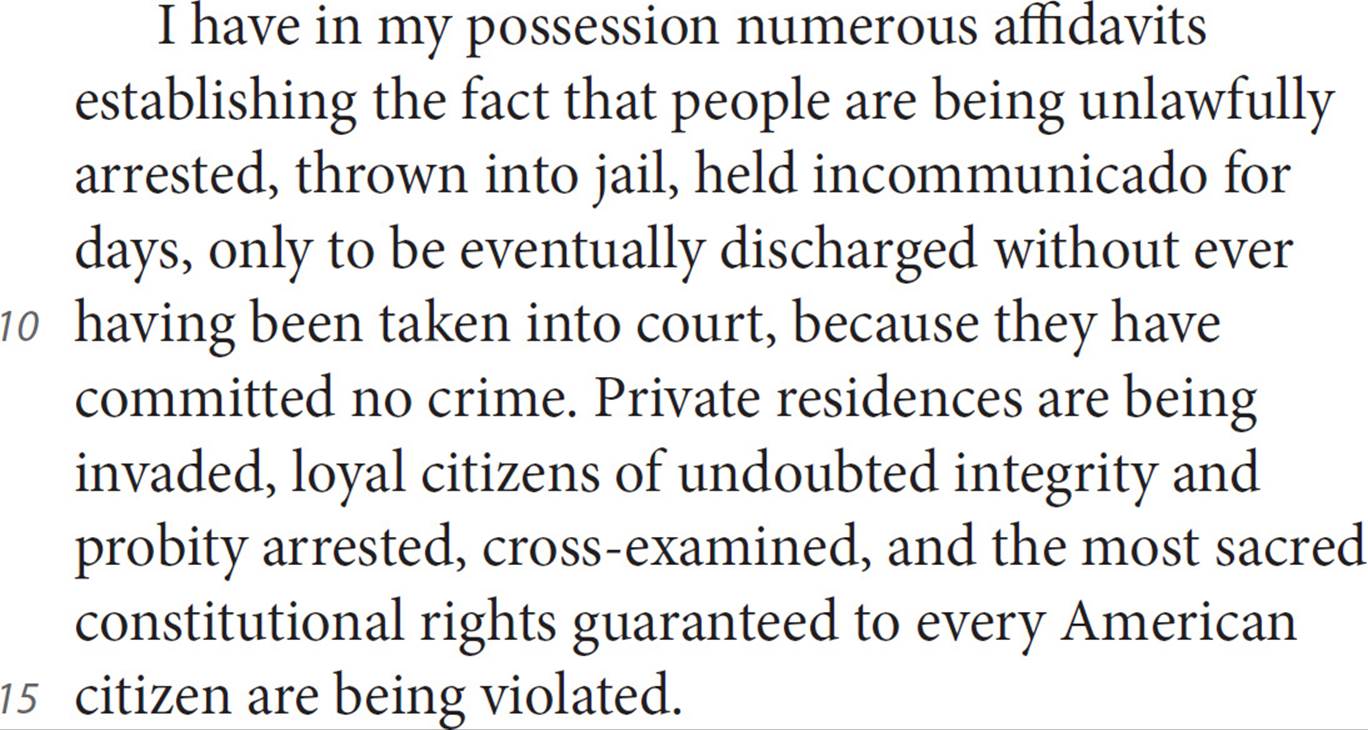
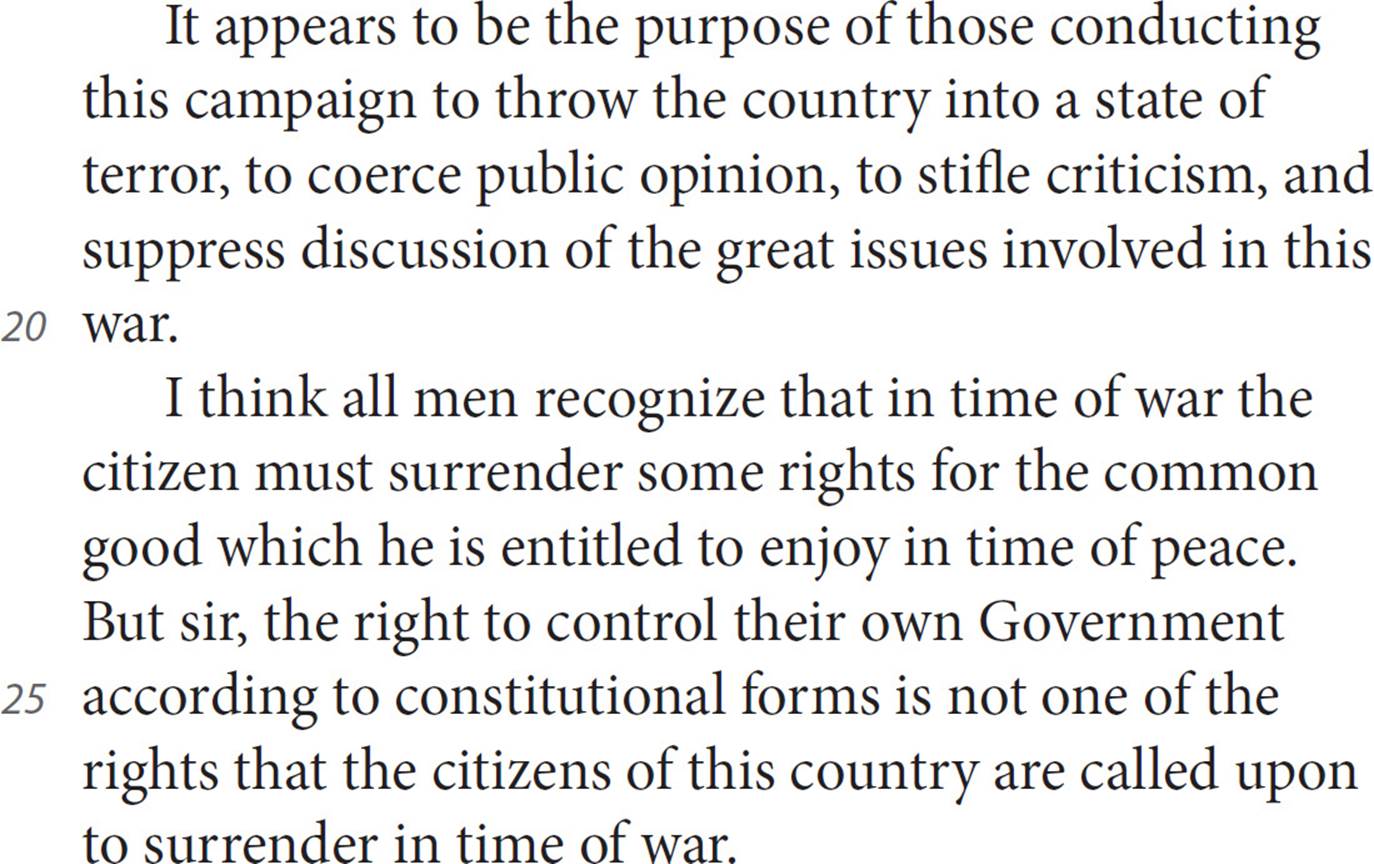
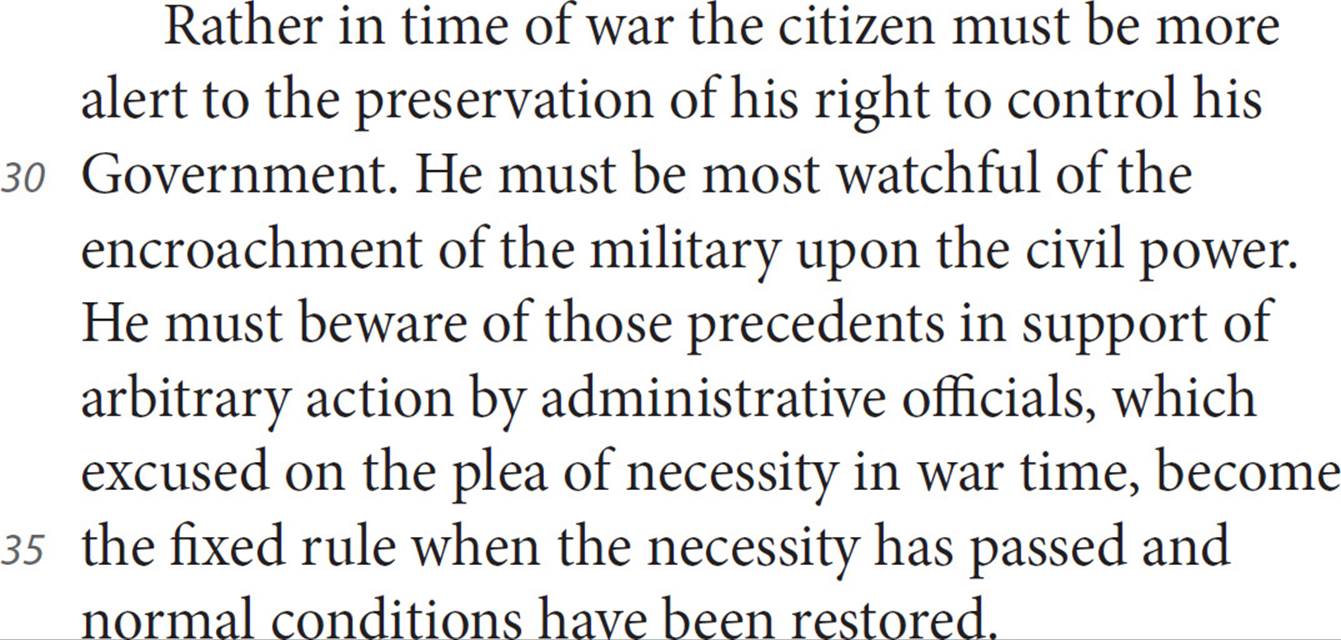
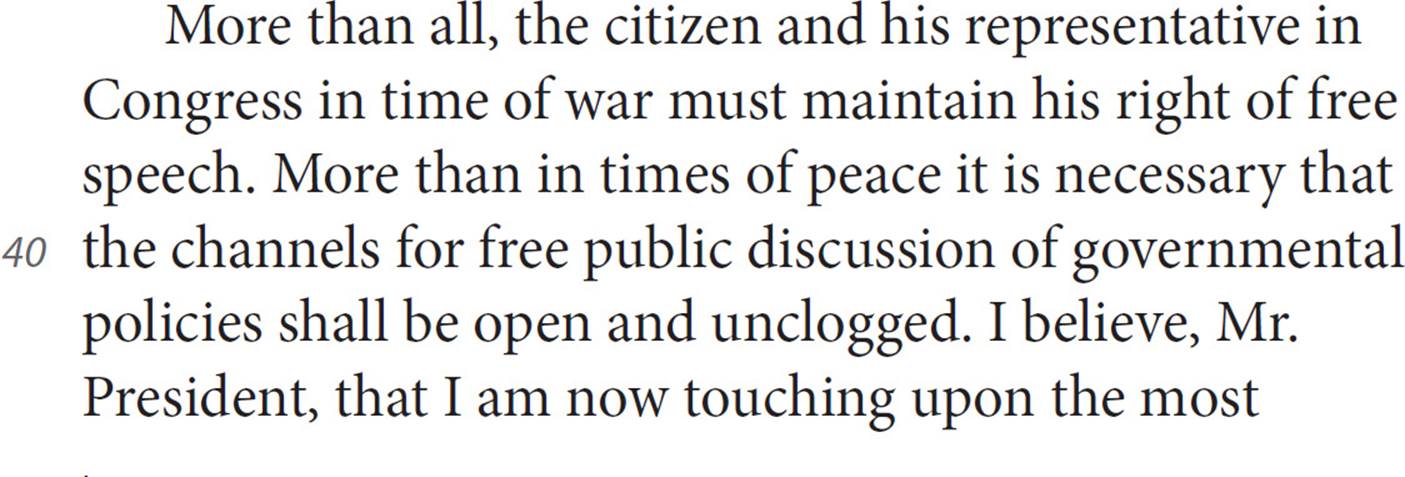
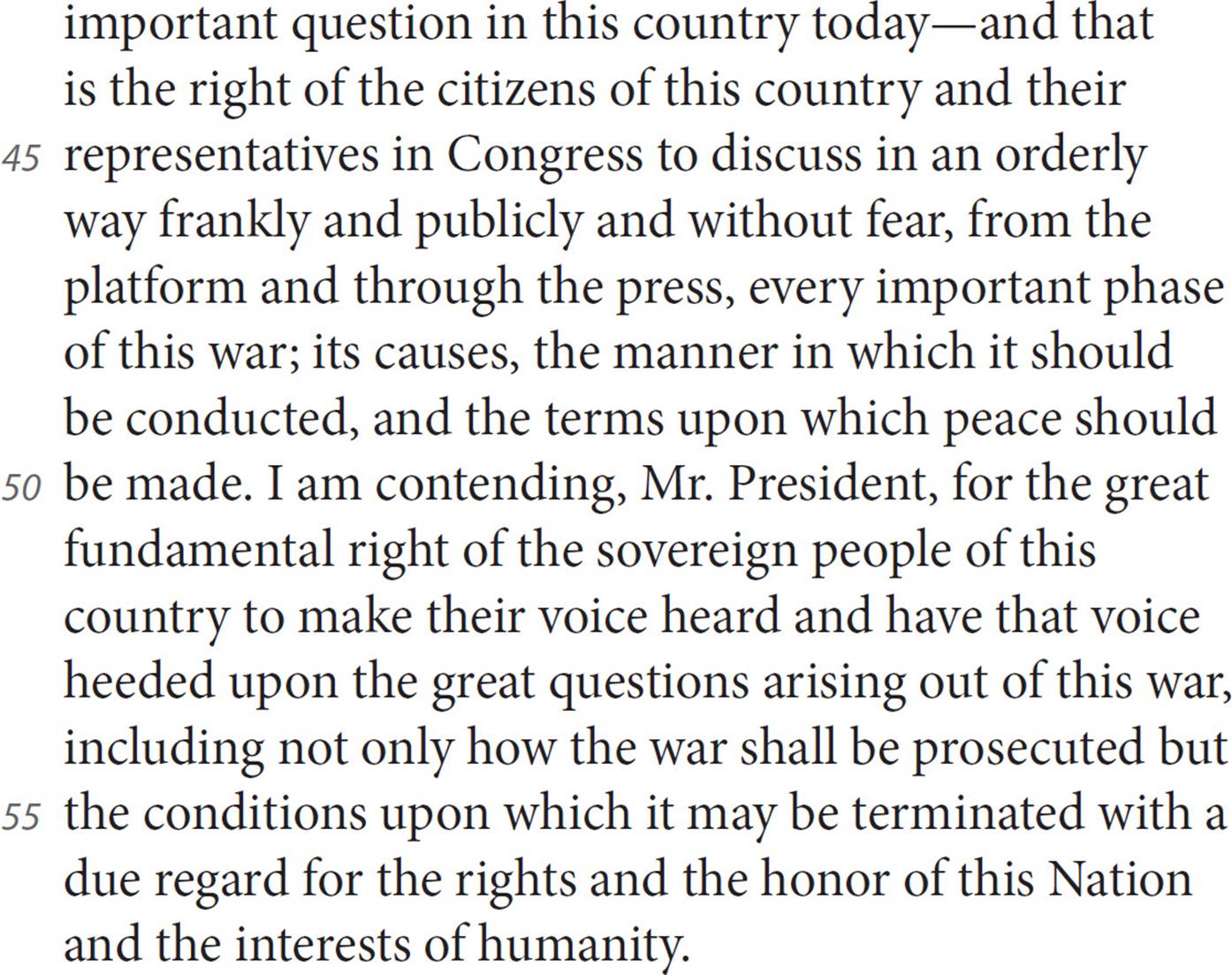

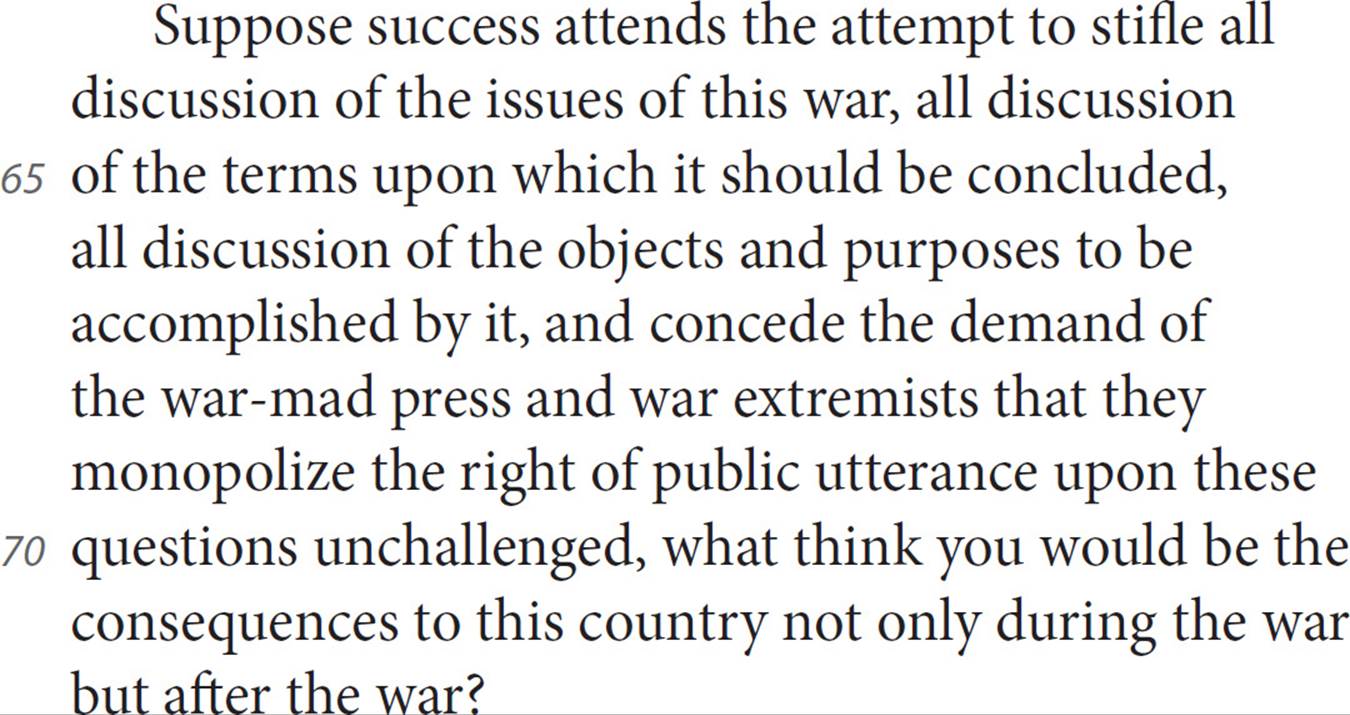
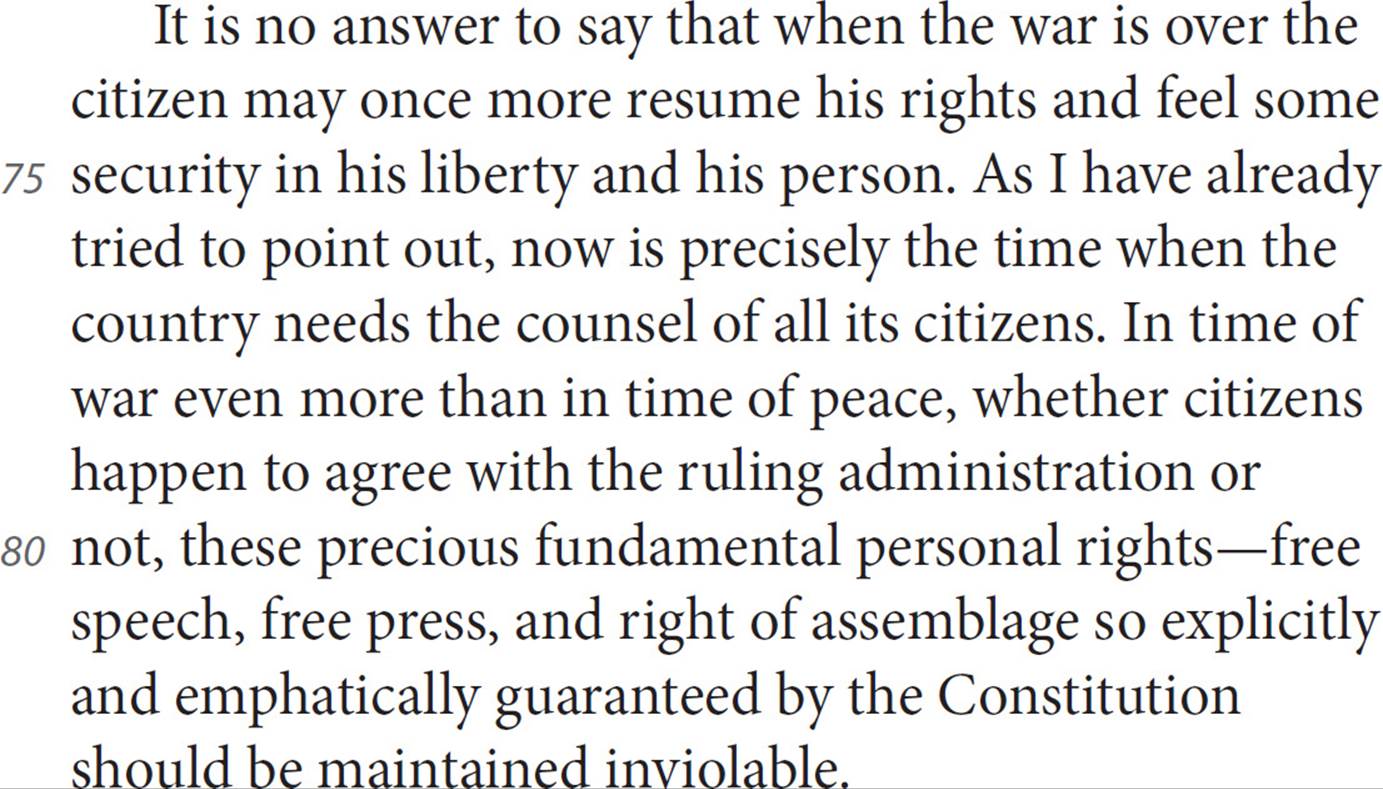
22.The position that LaFollette takes is best described as
A)a law-maker suggesting a new piece of legislation.
B)an impartial observer arbitrating a legal issue.
C)a dissenter arguing for a cause.
D)a pacifist arguing against international conflicts.
23.In the passage, LaFollette draws a distinction between
A)rights that are appropriately and inappropriately sacrificed during war.
B)moments when free speech is and is not necessary.
C)just wars and wars sought for economic interest.
D)the interests of the Nation and the interests of humanity.
24.Which choice provides the best evidence for the answer to the previous question?
A)Lines 6-11 (“I have…crime”)
B)Lines 21-27 (“I think…war”)
C)Lines 30-31 (“He must…power”)
D)Lines 50-57 (“I am…humanity”)
25.As used in line 8, “incommunicado” most nearly means
A)justified.
B)sequestered.
C)luxuriously.
D)available.
26.Lines 32-36 suggest that
A)some rights are necessarily given up during war time.
B)restrictions on civil powers are always arbitrary.
C)the Government must be watchful of the military.
D)temporary restrictions may become permanent.
27.Based on the information in the passage, citizen governance is necessary in all of the following situations EXCEPT
A)electing legislators and executives.
B)negotiating a peace treaty.
C)declarations of war.
D)decisions about military strategy.
28.The principal rhetorical effect of the phrase in lines 48-50, (“its causes…peace should be made”) is to
A)argue against granting free speech during war by emphasizing the difficulties faced by the military and the President.
B)suggest the numerous points at which citizens should exercise their free speech during times of war.
C)discuss three reasons why members of the press are currently unable to speak frankly without fear.
D)show that LaFollette believes that the citizens understand the dynamics of war far better than the President.
29.Which choice provides the best evidence for the answer to the previous question?
A)Lines 11-15 (“Private…violated”)
B)Lines 16-20 (“It appears…war”)
C)Lines 30-36 (“He must…restored”)
D)Lines 37-41 (“More than…unclogged”)
30.The author’s attitude toward “the attempt to stifle” (line 63) can be described as
A)sympathetic.
B)apathetic.
C)frustrated.
D)morose.
31.As used in line 83, “inviolable” most nearly means
A)secretly.
B)freely.
C)unbreakable.
D)personally.
Questions 32-41 are based on the following passage.
The following is from a passage about continental drift and plate tectonics from Science World.
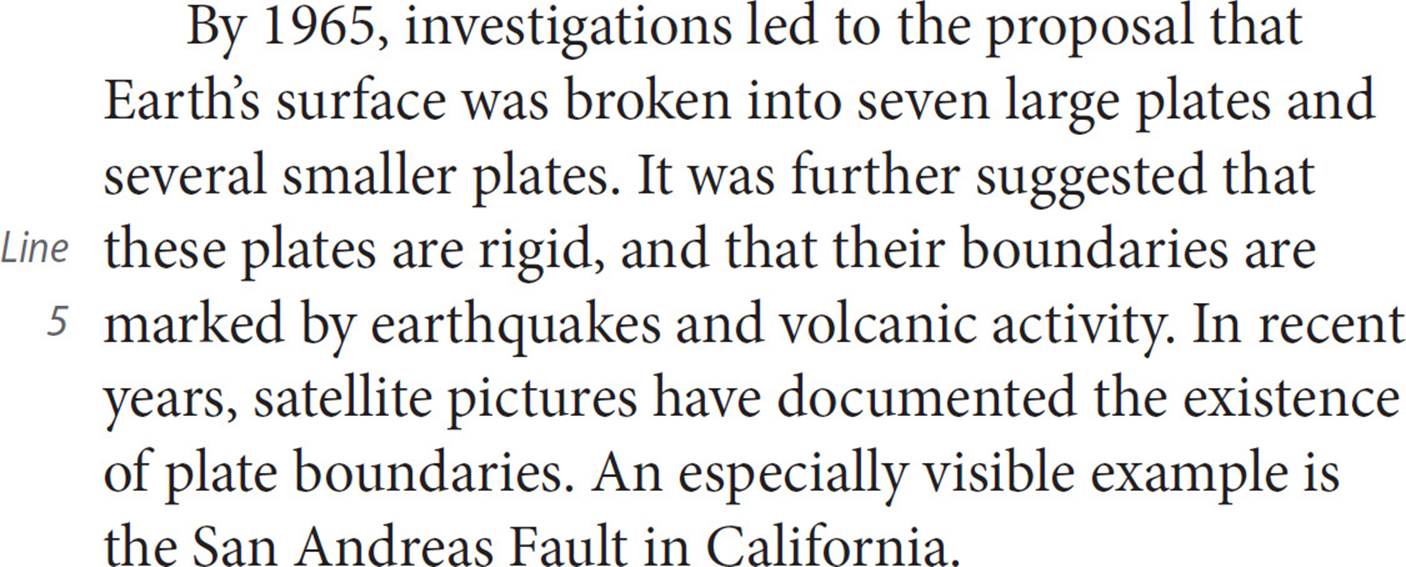


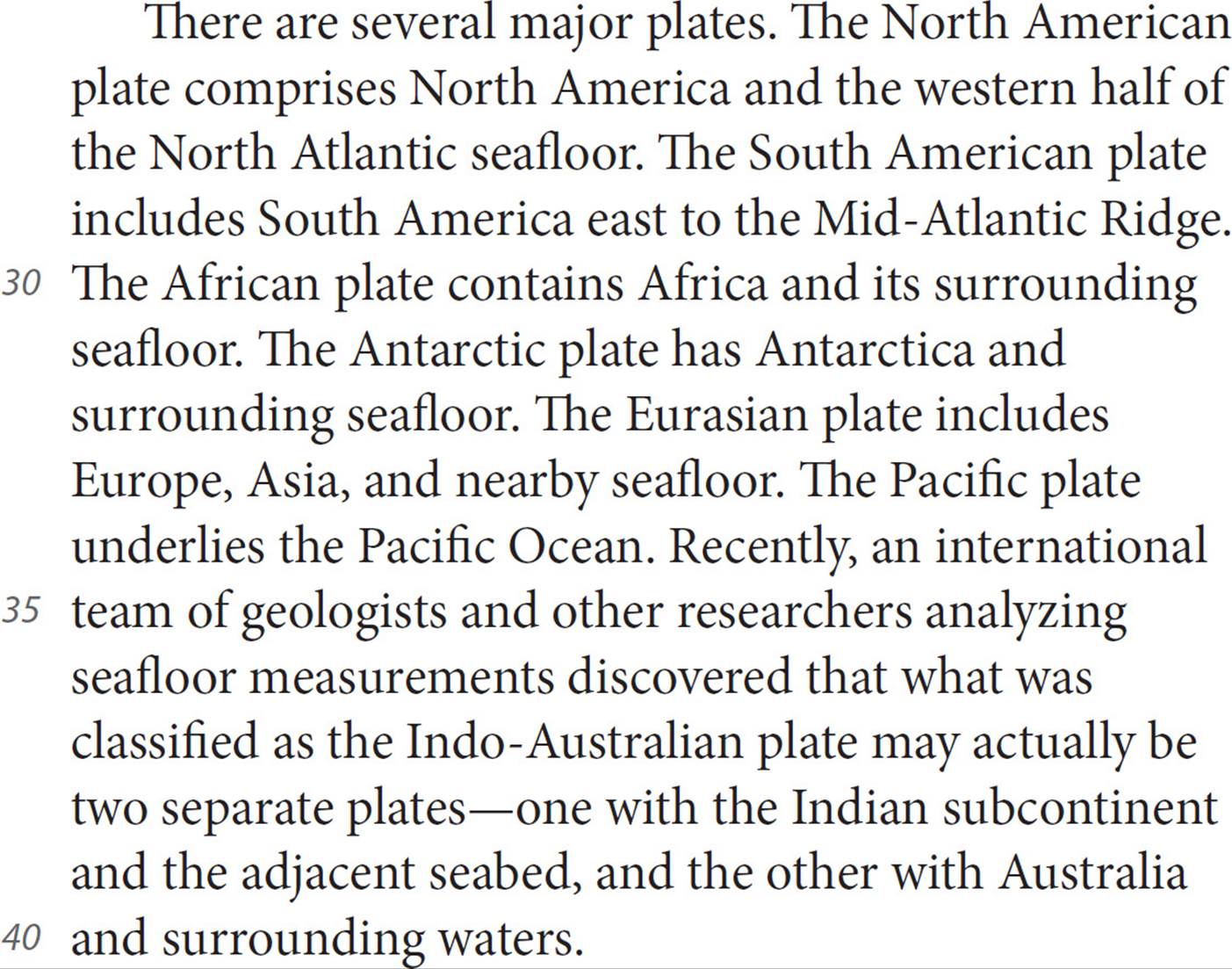


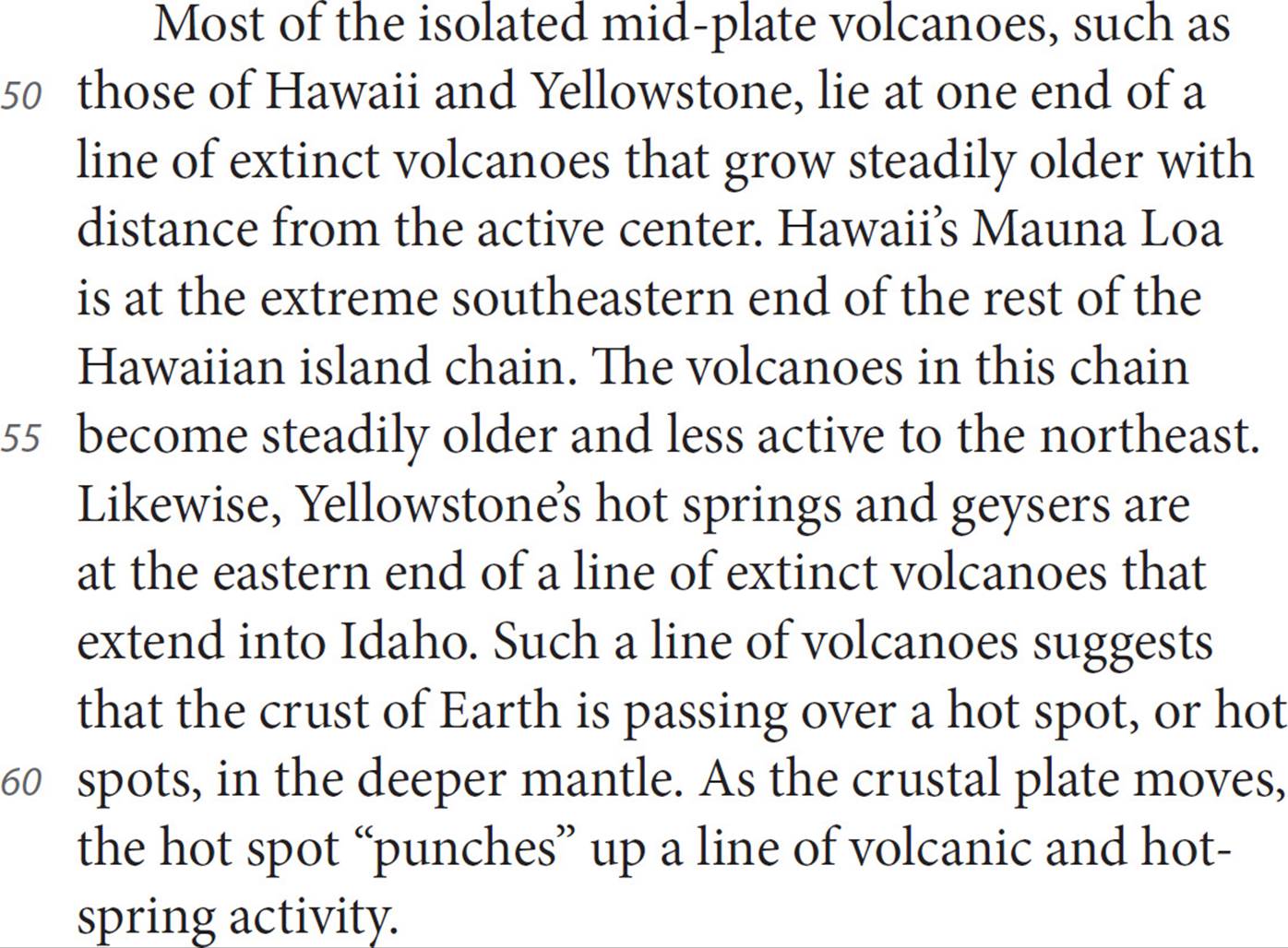

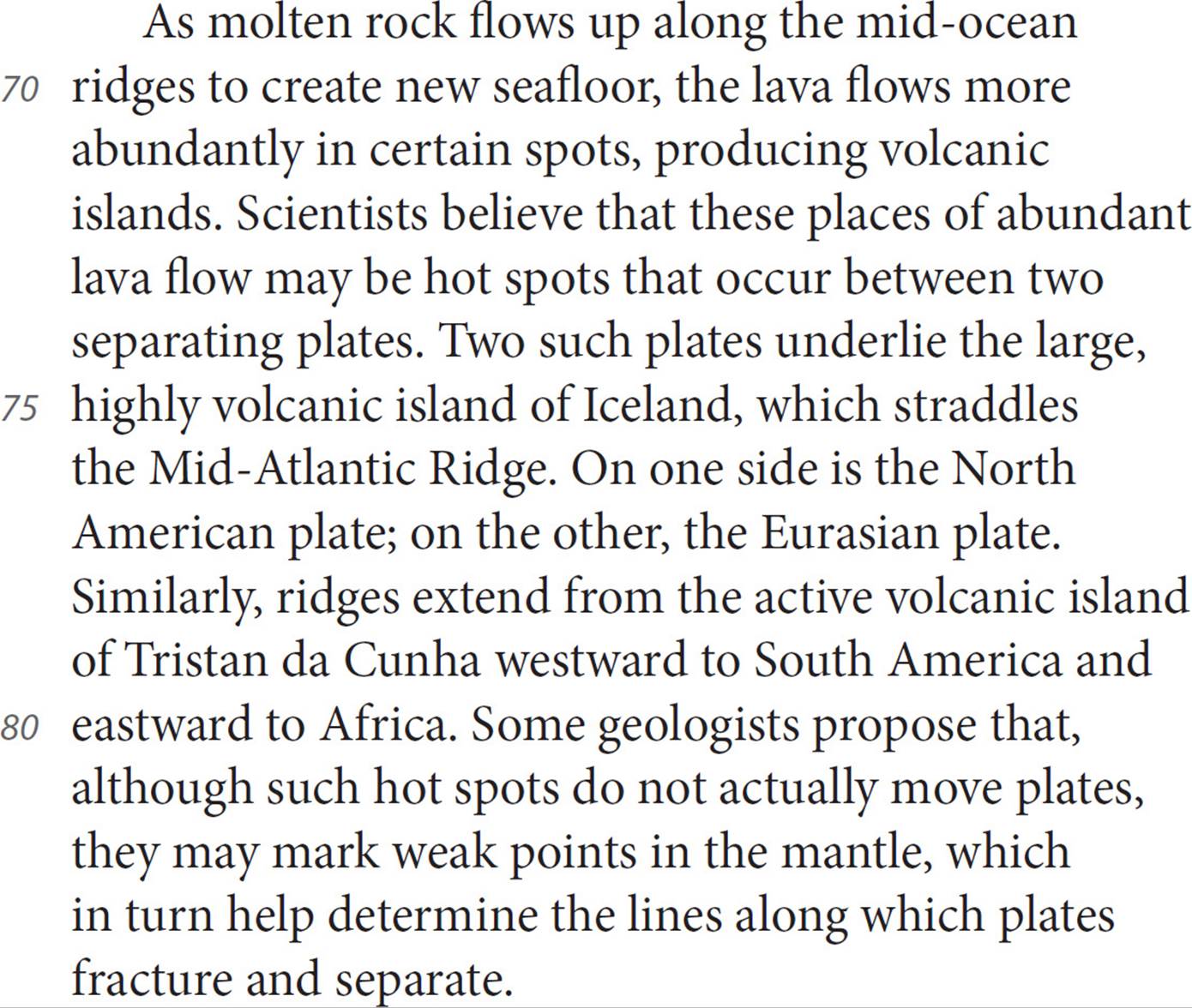
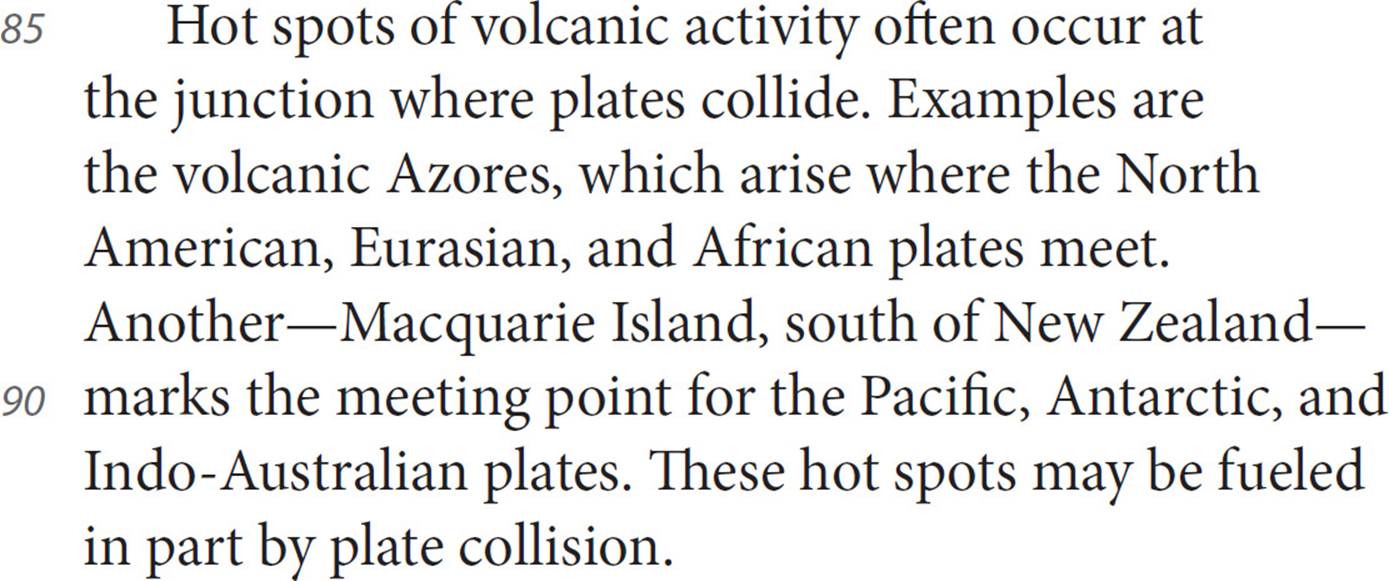
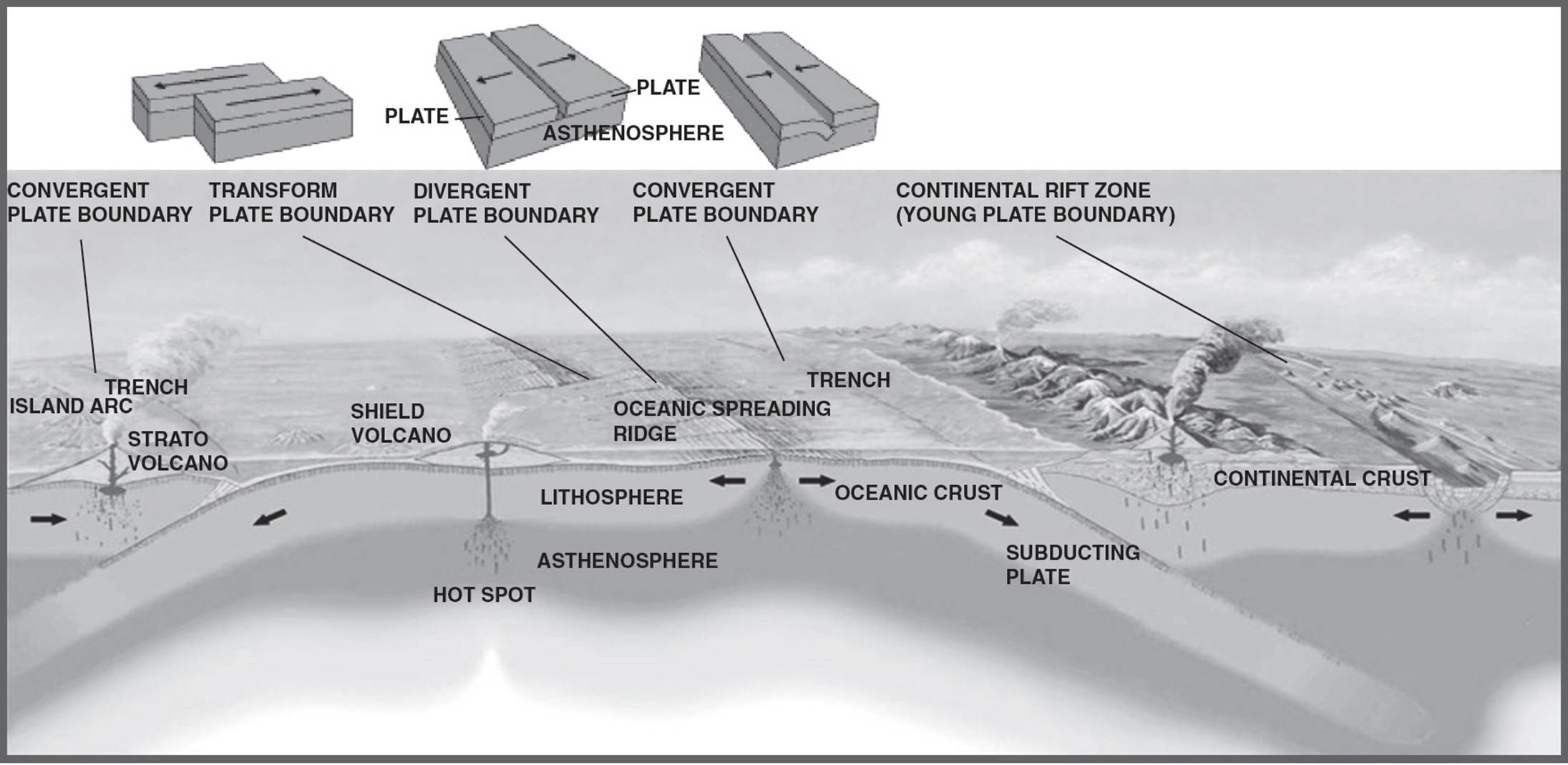
This image shows the three main types of plate boundaries: divergent, convergent, and transform. Image adapted from the U.S. Geological Survey.
32.Based on the information in the passage it can be reasonably inferred that
A)geological theories are only proven with the help of technological advances.
B)improvements in satellite technology advanced plate tectonics theory.
C)the plate tectonics theory was created in 1965.
D)the San Andreas Fault proved the veracity of plate tectonics theory.
33.In the third paragraph (lines 20-25), what is the distinction the author draws between continental-drift theory and plate tectonics?
A)Fluidity versus immobility
B)Drifting along versus pushing with purpose
C)Moving through versus moving with
D)Sailing on oceans versus rafting through streams
34.As used in line 42, “convection” most nearly means
A)liquefying.
B)melting.
C)mobilizing.
D)transferring.
35.In line 56, what is the most likely reason the author introduces Yellowstone’s hot springs?
A)As an example of a mid-plate volcano
B)As proof that plates slide past each other
C)As support for an opposing theory
D)As an example of a mid-ocean ridge
36.Which choice provides the best evidence for the answer to the previous question?
A)Lines 3-5 (“It was…activity”)
B)Lines 54-55 (“The volcanoes…northeast”)
C)Lines 60-62 (“As the…activity”)
D)Lines 65-67 (“Plate…them”)
37.As used in line 64, “compatible” most nearly means
A)consistent.
B)adaptable.
C)opposed.
D)skewed.
38.What is the most likely reason the author mentions Iceland?
A)To offer an example of an island created at a mid-ocean ridge
B)To show a contrast between an island and a continent
C)To prove that an island can also be a volcano
D)To assert that the Mid-Atlantic Ridge connects two plates
39.Which choice provides the best evidence for the answer to the previous question?
A)Lines 9-12 (“Plates…other”)
B)Lines 41-44 (“Scientists…Earth”)
C)Lines 49-52 (“Most…center”)
D)Lines 69-72 (“As…islands”)
40.The principal rhetorical purpose of the phrase “Some geologists…separate” (lines 80-84) is to
A)suggest that scientists are still investigating plate tectonic theory.
B)emphasize the lack of data supporting how fractures separate.
C)reveal that some scientists disagree with the major tenets of plate tectonics.
D)expose a weakness in the continental-drift theory.
41.It can be reasonably inferred from information in the passage and the diagram that
A)continental rift zones always occur beside the ocean.
B)hot spots are molten plumes that travel through the lithosphere to the surface.
C)mid-ocean ridges are caused by the presence of subducting plates.
D)oceanic crust is more rigid than continental crust.
Questions 42-52 are based on the following passage.
Passage 1 is adapted from Theodore S. Melis, Ed., “Effects of Three High-Flow Experiments on the Colorado River Ecosystem Downstream from Glen Canyon Dam, Arizona,” published in 2011 by the U.S. Geological Survey. Passage 2 is adapted from Paul E. Grams, “A Sand Budget for Marble Canyon, Arizona—Implications for Long-Term Monitoring of Sand Storage Change,” published in 2013 by the U.S. Geological Survey.
Passage 1
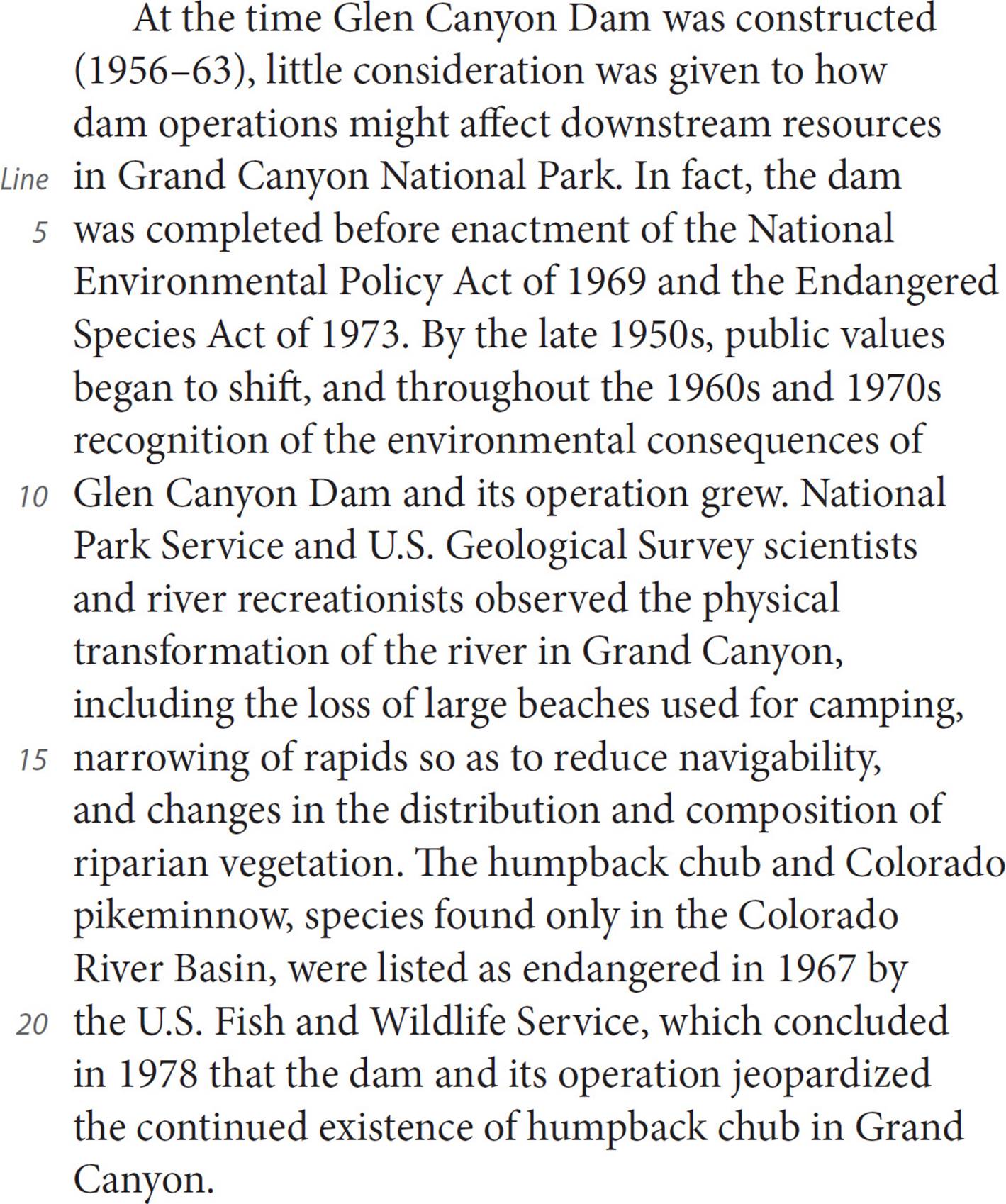

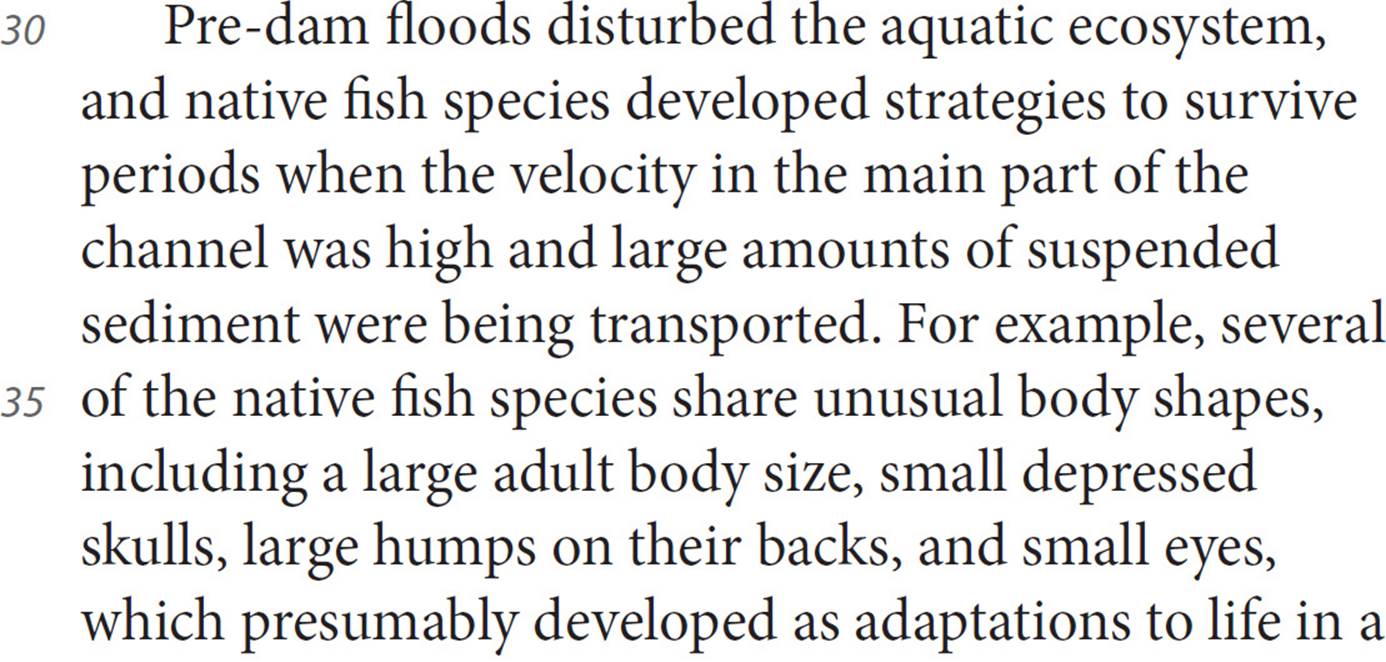

Passage 2
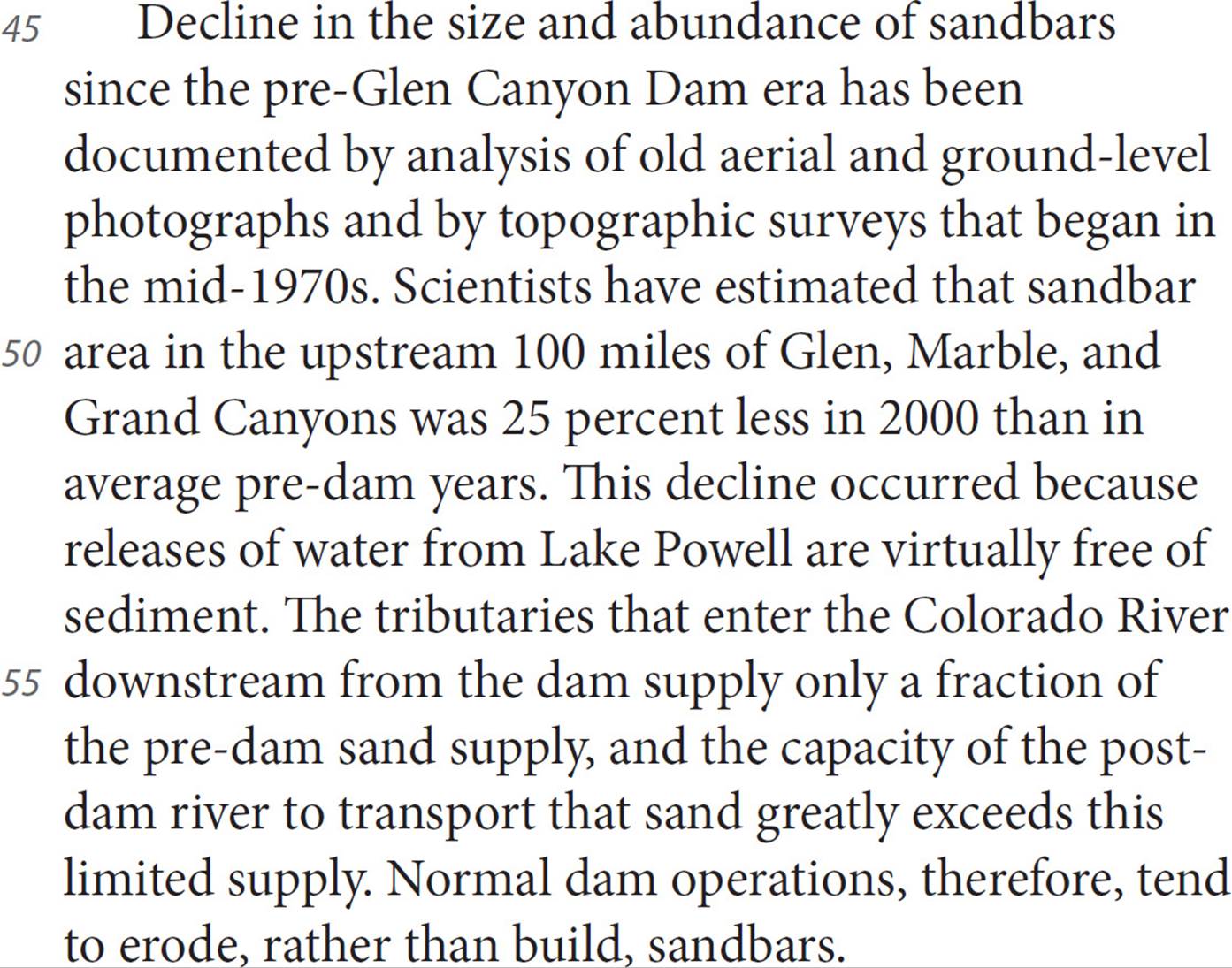
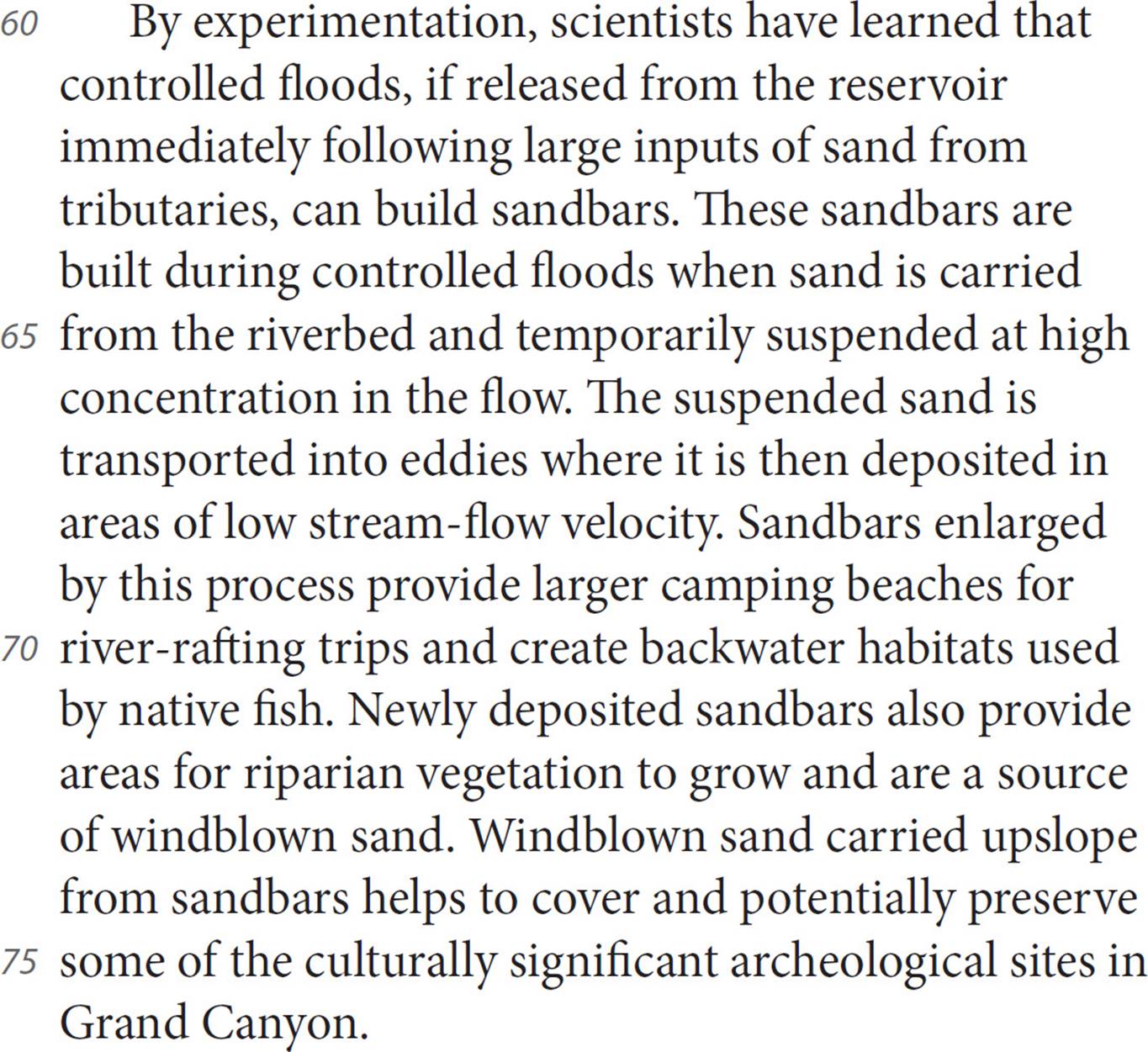
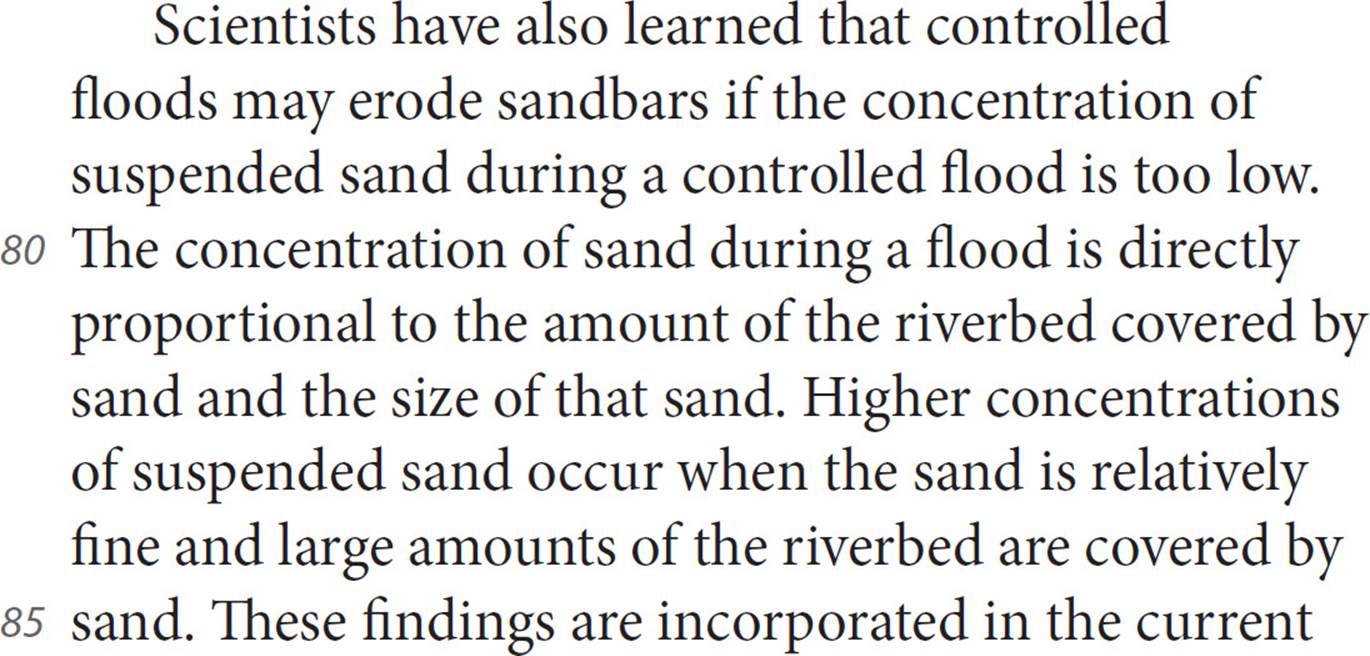
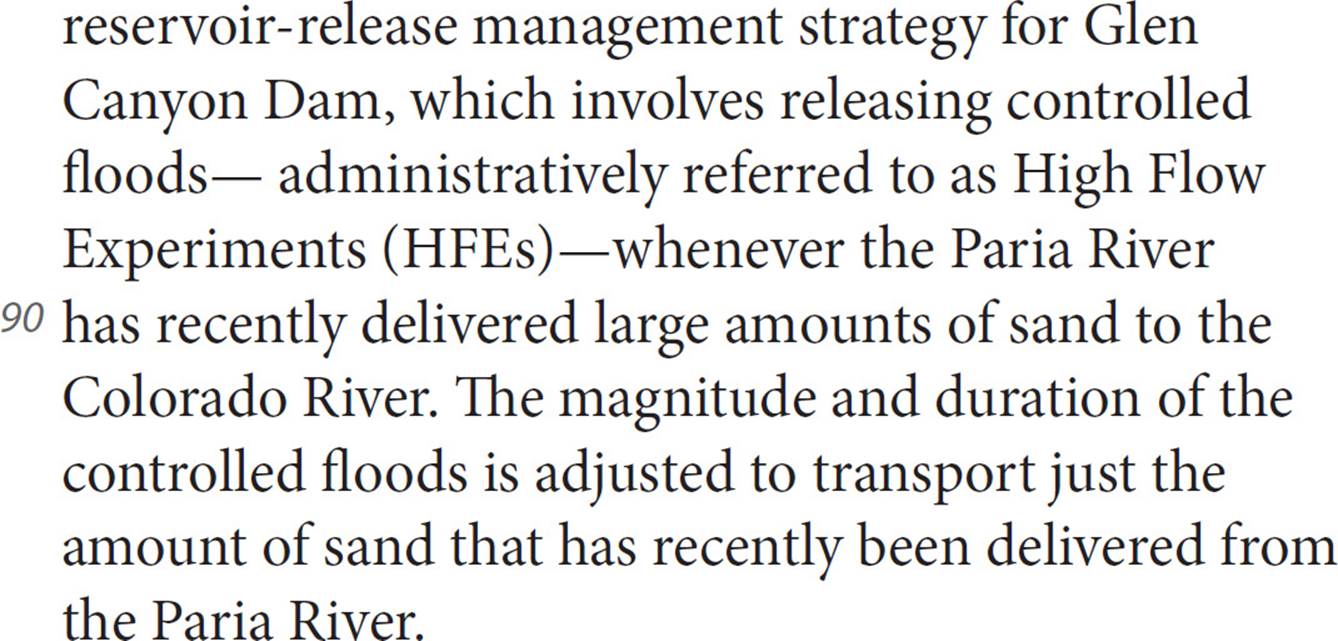
42.The author of Passage 1 most likely believes that the Glen Canyon Dam
A)is a useful tool for managing scarce water resources.
B)was built with a lack of foresight.
C)has decimated native fish populations.
D)has had a calming effect on the aquatic ecosystem.
43.Which choice provides the best evidence for the answer to the previous question?
A)Lines 1-4 (“At the time…Park”)
B)Lines 17-23 (“The humpback…Canyon”)
C)Lines 24-25 (“Annual…regime”)
D)Lines 30-34 (“Pre-dam floods…transported”)
44.The author of Passage 1 mentions scientists and river recreationists primarily to
A)provide support for the idea that post-dam river looks drastically different.
B)draw a contrast between scientific observations and casual observations of river conditions.
C)emphasize the spirit of collaboration between the science community and the public in conservation efforts.
D)prove that the Glen Canyon Dam has had a ruinous effect on the river.
45.Passage 1 suggests that the humpback chub
A)is now extinct in the Grand Canyon.
B)has a small, depressed skull.
C)can survive in changing environments.
D)thrives in high velocity river channels.
46.As used in line 25, “regime” most nearly means
A)government.
B)tenure.
C)system.
D)management.
47.As used in line 65, “suspended” most nearly means
A)stopped.
B)mixed.
C)withheld.
D)hanging.
48.It is reasonable to conclude that controlled floods
A)successfully simulate pre-dam snowmelt floods.
B)contain large amounts of suspended sediment.
C)may be detrimental to the health of the Colorado River.
D)should be done during the months that snowmelt floods typically occur.
49.Which choice provides the best evidence for the answer to the previous question?
A)Lines 58-59 (“Normal…sandbars”)
B)Lines 66-68 (“The suspended…velocity”)
C)Lines 71-73 (“Newly…sand”)
D)Lines 77-79 (“Scientists…low”)
50.The author of Passage 1 would most likely respond to the High Flow Experiments described in Passage 2 by
A)appreciating the efforts of scientists to maintain the sand supply below the dam.
B)warning of the calamity of interfering with the river ecosystem.
C)questioning the ability of controlled floods to build up sandbars.
D)worrying that reshaped habitats will harm native fish.
51.Which of the following best describes the structure of the two passages?
A)Passage 1 introduces a problem, and Passage 2 proposes a solution to the problem.
B)Passage 1 offers a historical discussion, and Passage 2 describes the implications of a scientific practice.
C)Passage 1 gives background information, and Passage 2 details recent changes.
D)Passage 1 describes an experiment, and Passage 2 offers suggestions for future action.
52.Which of the following statements is true of Passage 1, but not of Passage 2?
A)The passage gives details of scientific studies conducted on the river.
B)The passage offers documented evidence of topographic change in the river.
C)The passage indicates the importance of floods to the river ecosystem.
D)The passage gives specific examples of species affected by the dam.
S T O P
If you finish before time is called, you may check your work on this section only.

Writing and Language Test
35 MINUTES, 44 QUESTIONS
Turn to Section 2 of your answer sheet to answer the questions in this section.
DIRECTIONS
Each passage below is accompanied by a number of questions. For some questions, you will consider how the passage might be revised to improve the expression of ideas. For other questions, you will consider how the passage might be edited to correct errors in sentence structure, usage, or punctuation. A passage or a question may be accompanied by one or more graphics (such as a table or graph) that you will consider as you make revising and editing decisions.
Some questions will direct you to an underlined portion of a passage. Other questions will direct you to a location in a passage or ask you to think about the passage as a whole.
After reading each passage, choose the answer to each question that most effectively improves the quality of writing in the passage or that makes the passage conform to the conventions of standard written English. Many questions include a “NO CHANGE” option. Choose that option if you think the best choice is to leave the relevant portion of the passage as it is.
Questions 1–11 are based on the following passage.
And Justice for All
Her father got her the job. Amanda was between semesters at college, and her  work at the mall wouldn’t do much for her when she got out of school. It was time to do something more serious, something that meant more to her. Many of her friends were getting internships in the city, working for this or that publishing house or TV studio. Amanda, however, wanted something different. She would start applying to law schools
work at the mall wouldn’t do much for her when she got out of school. It was time to do something more serious, something that meant more to her. Many of her friends were getting internships in the city, working for this or that publishing house or TV studio. Amanda, however, wanted something different. She would start applying to law schools  soon and she wanted to know what the law looked like in action.
soon and she wanted to know what the law looked like in action.
1.
A)NO CHANGE
B)work, at the mall, wouldn’t do much for her when
C)work at the mall wouldn’t do much for her, when
D)work, at the mall, wouldn’t do much for her, when
2.
A)NO CHANGE
B)soon and,
C)soon, and
D)soon,
Fortunately, her dad knew someone from high school, a friend  named Ellen, who had then gone on to study at Duke University. It was a thankless job, and although the Department building itself covered almost one hundred acres (in New York City, there was an entire island devoted to it), no one paid the Department of Corrections much mind. Most people never come near a jail cell, so
named Ellen, who had then gone on to study at Duke University. It was a thankless job, and although the Department building itself covered almost one hundred acres (in New York City, there was an entire island devoted to it), no one paid the Department of Corrections much mind. Most people never come near a jail cell, so  it’s easy for them to dismiss inmates as totally removed from society.
it’s easy for them to dismiss inmates as totally removed from society.
[1] At the Department, however, Amanda learned about prisoners’ rights. [2] Or, by the same token, when was the use of force appropriate from the officers? [3] There is a clear provision in the Constitution that prohibits “cruel and unusual punishment.” [4] The meaning of these four words  were nowhere more ambiguous than in prisons. [5] Everyone within these walls had been convicted of a crime and was now paying
were nowhere more ambiguous than in prisons. [5] Everyone within these walls had been convicted of a crime and was now paying  they’re debt to society, but how could a government ensure that the place would deliver the “reform” in a reformatory or the “penitence” in a penitentiary? [6] Should inmates with, for example, mental illnesses be treated differently from others?
they’re debt to society, but how could a government ensure that the place would deliver the “reform” in a reformatory or the “penitence” in a penitentiary? [6] Should inmates with, for example, mental illnesses be treated differently from others? 
3.Which of the following true statements contains information most in keeping with the main idea of this passage?
A)NO CHANGE
B)who had gone on to law school and now worked at the County Department of Corrections.
C)with whom he had not spoken in twenty-five years, though with whom he still felt very close.
D)DELETE the underlined portion.
4.Which of the following best concludes this paragraph by reinforcing ideas presented in this sentence and the preceding one?
A)NO CHANGE
B)people often know literally nothing about prison life, though they are endlessly fascinated.
C)movie studios are famous for their sordid but often wrong depictions of prison life.
D)incarceration rates in the United States are some of the highest in the world.
5.
A)NO CHANGE
B)have been
C)are
D)is
6.
A)NO CHANGE
B)their
C)there
D)his or her
7.In the sequence of the paragraph, the best placement for sentence 2 would be
A)where it is now.
B)before sentence 1.
C)after sentence 3.
D)after sentence 6.
While Amanda did not gain any answers from her summer at the Department of Corrections, she  gathered together a whole new set of questions. She had uncovered questions and conundrums about the prison system itself, but she had begun to see prisoners’ rights as central to the question of free rights as well. She began to wonder exactly what it was that a government owed its people and how much freedom was too much. Her internship that summer made her realize that politics and the law
gathered together a whole new set of questions. She had uncovered questions and conundrums about the prison system itself, but she had begun to see prisoners’ rights as central to the question of free rights as well. She began to wonder exactly what it was that a government owed its people and how much freedom was too much. Her internship that summer made her realize that politics and the law  was a living thing. As she applied to law schools the following fall, Amanda wrote passionately about what she had uncovered. “Although law has long been considered a profession of privilege and prestige,” she concluded her essay, “I have seen firsthand how it affects the lives of all of us. We may believe that we never come into contact with the
was a living thing. As she applied to law schools the following fall, Amanda wrote passionately about what she had uncovered. “Although law has long been considered a profession of privilege and prestige,” she concluded her essay, “I have seen firsthand how it affects the lives of all of us. We may believe that we never come into contact with the  law; however, it is written into everything around us, including how we see ourselves.”
law; however, it is written into everything around us, including how we see ourselves.”
8.
A)NO CHANGE
B)gathered up
C)collected up
D)gathered
9.
A)NO CHANGE
B)were living things.
C)was a thing that was alive.
D)were things that were living.
10.
A)NO CHANGE
B)law, however
C)law, however;
D)law, however,
11.Suppose the writer’s goal had been to write an essay that criticizes the American justice system. Would this essay fulfill that goal?
A)Yes, because it refers to much of what Amanda learns as “conundrums.”
B)Yes, because it shows that the U.S. justice system has some problems.
C)No, because it tells the story of one person becoming interested in the justice system.
D)No, because it suggests that working in the justice system inspired one person’s entire career.
Questions 12–22 are based on the following passage.
Alexander’s Empire of Culture
Alexander the Great is a name known to all, but not all know the extent of Alexander’s accomplishments. Now that the study of the “classics” (mainly Roman and Greek civilizations) has  disappeared both from high-school and college curricula, Alexander the Great’s legend is not on the tongue of every schoolboy, though his accomplishments have not
disappeared both from high-school and college curricula, Alexander the Great’s legend is not on the tongue of every schoolboy, though his accomplishments have not  diminished for all that.
diminished for all that.
Alexander was born in Pella, Macedonia, in 356 BCE. His father, King Philip II, a strong military king  in his own write, believed that his son was born part man and part god. Alexander came to cultivate the image himself, bolstered by his keen intellect and learning, quickened in part by his tutor, the great Greek philosopher Aristotle. Pella was at that time a backwater of Greek culture, and
in his own write, believed that his son was born part man and part god. Alexander came to cultivate the image himself, bolstered by his keen intellect and learning, quickened in part by his tutor, the great Greek philosopher Aristotle. Pella was at that time a backwater of Greek culture, and  hisarrival announced a new era of what historians would later call “enlightened monarchy,”
hisarrival announced a new era of what historians would later call “enlightened monarchy,”  even though that term is used much more to describe monarchies in the eighteenth century.
even though that term is used much more to describe monarchies in the eighteenth century.
12.
A)NO CHANGE
B)disappeared from both
C)disappeared both
D)from both disappeared
13.
A)NO CHANGE
B)ameliorated
C)gone down
D)subsided
14.
A)NO CHANGE
B)in his own right,
C)in his own rite,
D)by his own rite,
15.
A)NO CHANGE
B)Aristotle’s
C)their
D)the
16.Which of the following true statements would best conclude the paragraph by emphasizing the change that Alexander’s rule brought to Macedonia?
A)NO CHANGE
B)although those who suffered defeat at Alexander’s hands might not have seen it that way.
C)suggesting a style for the reigns of both Julius Caesar and Napoleon Bonaparte.
D)underlining further that Philip’s former militaristic state was entering a new age.
Still, the age was not entirely new. Alexander spent nearly all his time abroad, first uniting the Greek kingdom that threatened to fall apart at Philip’s death, then moving on to broader military conquests.  Alexander had conquered an incredible amount of land by the time of his death in 323 BCE,
Alexander had conquered an incredible amount of land by the time of his death in 323 BCE,  as his empire stretched from Greece to modern-day India, some two million square miles. When his armies conquered Persia (now Iran and Iraq) once and for all, he took on the title by which he is still known today: King of Babylon, King of Asia, King of the Four Quarters of the World.
as his empire stretched from Greece to modern-day India, some two million square miles. When his armies conquered Persia (now Iran and Iraq) once and for all, he took on the title by which he is still known today: King of Babylon, King of Asia, King of the Four Quarters of the World.
17.The author wants to insert an introductory phrase or clause at the beginning of this sentence that will emphasize the continuity Alexander’s reign had with the previous one. Which of the following choices would most effectively give this emphasis?
A)In what must have been truly exhausting,
B)With great ambition,
C)As his father had before him,
D)Just as historians have noted,
18.Which of the following choices gives information consistent with the map shown below?
A)NO CHANGE
B)while he traveled on foot throughout most of modern-day Europe,
C)because he circled the entire Mediterranean Sea and much of the Indian Ocean,
D)as he conquered all of Italy hundreds of years before Caesar had done so,
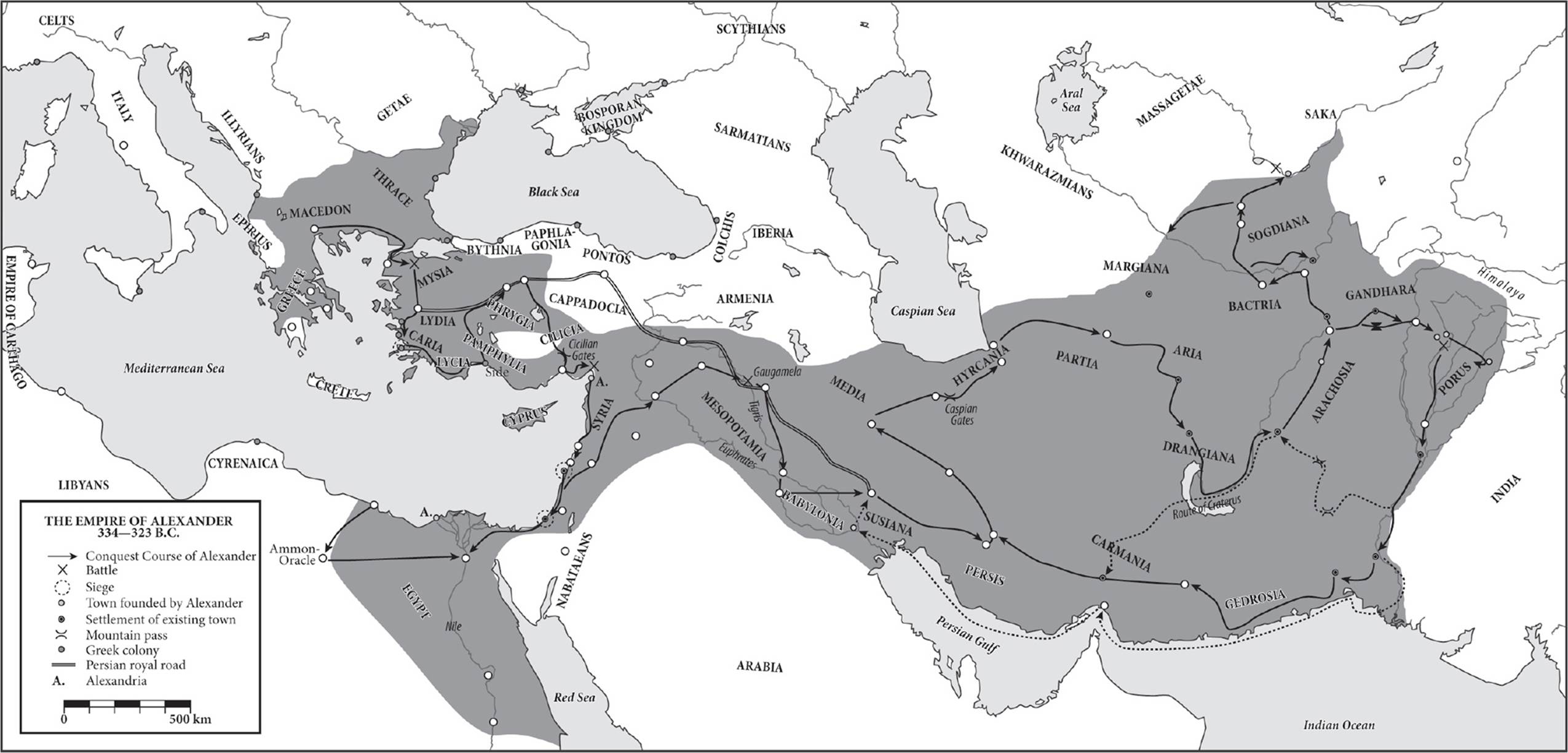
Extent of the empire of Alexander the Great
Alexander’s historical importance is not merely one of military might, however.  He moved to these different parts of the world, he brought Greek culture with him, and his reign marks
He moved to these different parts of the world, he brought Greek culture with him, and his reign marks  an unprecedented instance of contact between the ancient East and West. Over twenty cities throughout the empire bear his name. Alexandria, Egypt, perhaps the most famous of these cities, continues to
an unprecedented instance of contact between the ancient East and West. Over twenty cities throughout the empire bear his name. Alexandria, Egypt, perhaps the most famous of these cities, continues to  thrive. It is the second-largest city in the modern nation of Egypt.
thrive. It is the second-largest city in the modern nation of Egypt.
Perhaps history is the wrong place to understand the accomplishments of Alexander the Great. Epic poetry seems more suitable. After all, Alexander’s great teacher Aristotle showed him Homer’s Iliadand Odyssey, and it seems that Alexander himself understood his life as a shuttling back and forth between man and god, the individual and the world, and the natural  and the unnatural.
and the unnatural.
19.
A)NO CHANGE
B)As he
C)Although he
D)Moreover, he
20.Which of the following alternatives to the underlined portion would NOT be acceptable?
A)an unparalleled
B)a pioneering
C)an ahistorical
D)a never before seen
21.Which of the following is the most effective way to combine these two sentences?
A)thrive; it is
B)thrive, is
C)thrive. It’s
D)thrive and is
22.
A)NO CHANGE
B)versus
C)from
D)but
Questions 23–33 are based on the following passage.
Brother, Can You Spare a Dime?
Although printed cheaply and for quick consumption,  today’s experience of culture is largely shaped by dime novels. For much of the nineteenth century, Americans consumed fiction, poetry, and non-fiction by way of literary periodicals. Some of our best-known authors from this period,
today’s experience of culture is largely shaped by dime novels. For much of the nineteenth century, Americans consumed fiction, poetry, and non-fiction by way of literary periodicals. Some of our best-known authors from this period,  though there were also some notable exceptions, published something close to their complete works between the pages of countless periodicals.
though there were also some notable exceptions, published something close to their complete works between the pages of countless periodicals.
23.
A)NO CHANGE
B)we experience culture the way we do because of dime novels.
C)dime novels have shaped the way we experience culture today.
D)the shape of dime novels influences of cultural experiences.
24.Which of the following true phrases gives the most specific information in the context?
A)NO CHANGE
B)some of the best-known authors of all time,
C)and some who were not so well-known,
D)especially Edgar Allan Poe and Nathaniel Hawthorne,
Things started to change around the Civil War. Harriet Beecher Stowe’s great  novel, Uncle Tom’s Cabin had been an enormously popular serial novel in the abolitionist periodical The National Era. By the time the novel’s forty-week run had concluded, however, publishers were clamoring for an actual book. That book went on to become the first American bestseller.
novel, Uncle Tom’s Cabin had been an enormously popular serial novel in the abolitionist periodical The National Era. By the time the novel’s forty-week run had concluded, however, publishers were clamoring for an actual book. That book went on to become the first American bestseller.  And it showed that Americans were willing to pay for books, which had, to that point, been too expensive to print and subsequently to buy.
And it showed that Americans were willing to pay for books, which had, to that point, been too expensive to print and subsequently to buy. 
25.
A)NO CHANGE
B)novel, Uncle Tom’s Cabin,
C)novel Uncle Tom’s Cabin,
D)novel Uncle Tom’s Cabin
26.If the author were to remove the phrase “for an actual book” (ending the sentence at the word clamoring), the sentence would lose
A)specific information that clarifies the subject of the next sentence.
B)a description of the greed of publishers in the nineteenth century.
C)details that show how Stowe’s work came to be so popular.
D)nothing, because this information is implied in the word “clamoring.”
27.At this point, the writer is considering adding the following true statement:
The average annual income for men in New England from 1820-1850 was a mere $323.25.
Should the writer make this addition here?
A)Yes, because it makes clear how expensive books must have been in the period.
B)Yes, because it shows that even those in New England could not afford books printed there.
C)No, because it strays from the paragraph’s focus on the changes in book publishing.
D)No, because it suggests that people in New England were not wealthy enough to read.
In 1860, Irwin and Erastus Beadle published the first in a long series of what  would become known as Beadle’s Dime Novels. The first was called Malaeska, The Indian Wife of the White Hunter. By the turn of the nineteenth century, dime novels were everywhere.
would become known as Beadle’s Dime Novels. The first was called Malaeska, The Indian Wife of the White Hunter. By the turn of the nineteenth century, dime novels were everywhere.
The  affects are difficult to chart, but we can actually see the influence of these dime novels everywhere. Much of the mythology of the Old West, for example, was concretized in these dime novels, and William Bonney and James Butler Hickok became the folk heroes Billy the Kid and Wild Bill Hickok as the dime novels charted their (largely imagined) adventures.
affects are difficult to chart, but we can actually see the influence of these dime novels everywhere. Much of the mythology of the Old West, for example, was concretized in these dime novels, and William Bonney and James Butler Hickok became the folk heroes Billy the Kid and Wild Bill Hickok as the dime novels charted their (largely imagined) adventures. 
28.
A)NO CHANGE
B)becomes
C)is
D)would have become
29.
A)NO CHANGE
B)effects
C)effect’s
D)affect’s
30.The author is considering deleting the names “Billy the Kid and Wild Bill Hickok” from the preceding sentence. Should the names be kept or deleted?
A)Kept, because they are specific names in a sentence that speaks in generalities.
B)Kept, because they demonstrate the transformation described in the sentence.
C)Deleted, because they are nicknames of people whose true names are already listed in the sentence.
D)Deleted, because they encourage the frontier behavior that made the Wild West such a violent place.
The new media of the twentieth-century—film, radio, and comic books—may have replaced the dime novel, but they did so with much they had  been taught from the dime novel’s popularity. All three media, for instance, borrowed characters that had become popular in dime novels—characters such as Frank Reade and Nick Carter, Master Detective. Then, in comic books and radio, a new generation of superheroes—The Shadow, Superman, and Popeye—was created in the mold of the old swashbuckling romanciers of the dime-novel era.
been taught from the dime novel’s popularity. All three media, for instance, borrowed characters that had become popular in dime novels—characters such as Frank Reade and Nick Carter, Master Detective. Then, in comic books and radio, a new generation of superheroes—The Shadow, Superman, and Popeye—was created in the mold of the old swashbuckling romanciers of the dime-novel era.
So today, as we enjoy superhero action films or boy-wizard series of novels, we should be aware that there is nothing new under the sun. Indeed,  for our hopelessly mass-media universe, this now forgotten form laid the foundation, pushing the same books onto countless readers. Such a feat may be commonplace as films gross many billions of dollars at the box office, but in the nineteenth century, the dime novel brought a new
for our hopelessly mass-media universe, this now forgotten form laid the foundation, pushing the same books onto countless readers. Such a feat may be commonplace as films gross many billions of dollars at the box office, but in the nineteenth century, the dime novel brought a new  frame of reference and a belief that the small world was getting larger bit by bit.
frame of reference and a belief that the small world was getting larger bit by bit.
31.
A)NO CHANGE
B)got
C)learned
D)brought
32.If the punctuation is adjusted accordingly, the best placement for the underlined portion would be
A)where it is now.
B)after the word form.
C)after the word foundation.
D)at the end of the sentence.
33.Which of the following alternatives to the underlined portion would NOT be acceptable?
A)paradigm
B)integration
C)framework
D)context
Questions 34–44 are based on the following passage.
The Tiger Moth’s Phantom Target
[1]
Bats have always seemed mysterious predators. While many other animal predators use methods  similar to human hunters, bats have evolved a series of unique methods of capturing prey.
similar to human hunters, bats have evolved a series of unique methods of capturing prey.  The main curiosity among the bat’s weaponry is its use of echolocation, or sonar.
The main curiosity among the bat’s weaponry is its use of echolocation, or sonar.
[2]
Because bats hunt in the dark, they are not often able to see their prey. Instead, they use a process wherein they emit sounds and listen for the echoes. If  they are, say, standing atop a mountain and shout, you can figure out the distance across the canyon using the speed of sound waves and a series of precise calculations. Using its innate senses, a bat does these same
they are, say, standing atop a mountain and shout, you can figure out the distance across the canyon using the speed of sound waves and a series of precise calculations. Using its innate senses, a bat does these same  calculations instinctively. With extreme precision, a bat can identify its prey’s location and size in the dark and capture its prey. While a bat does have relatively acute vision,
calculations instinctively. With extreme precision, a bat can identify its prey’s location and size in the dark and capture its prey. While a bat does have relatively acute vision,  though not nearly as acute as some species of shrimp, its echolocation is what makes it such an effective predator.
though not nearly as acute as some species of shrimp, its echolocation is what makes it such an effective predator.
34.
A)NO CHANGE
B)similar to that of human hunters
C)similar to those of human hunters
D)like human hunters
35.
A)NO CHANGE
B)The echolocation, sonar, of the bat’s weaponry is its main curiosity.
C)The bat has a curious weaponry, main among which is its echolocation and sonar.
D)The bat’s weaponry is mainly curious in its use of echolocation of sonar.
36.
A)NO CHANGE
B)they’re,
C)one is,
D)you are,
37.
A)NO CHANGE
B)calculations by instinct.
C)calculations with its instincts.
D)calculations.
38.The writer intends to insert a phrase or clause that emphasizes a common misunderstanding about bats’ vision. Which of the following would best suit that intention?
A)NO CHANGE
B)undermining the cliché “blind as a bat,”
C)despite the pitch darkness in which it hunts,
D)in addition to its incredible hearing,
[3]
However, scientists have recently discovered a species that can disrupt the bat’s usually failsafe echolocation. The tiger moth, a victim of bat predation for over 50 million years, has figured out a way to “jam”  its system of echolocation. Most tiger moths can emit clicks that warn bats away from the moths, suggesting that the moths might be inedible toxic compounds.
its system of echolocation. Most tiger moths can emit clicks that warn bats away from the moths, suggesting that the moths might be inedible toxic compounds. 
[4]
In the long history of bat research, scientists have never seen the like of these tiger moths. Although human methods of warfare have used sonic deception for as long as such warfare has existed, the tiger moth and  their sonar jamming provide one of the first instances of aural camouflage in the animal kingdom that scientists have discovered. It seems that no matter how ancient the conflict, bats and tiger moths continue to attack,
their sonar jamming provide one of the first instances of aural camouflage in the animal kingdom that scientists have discovered. It seems that no matter how ancient the conflict, bats and tiger moths continue to attack,  counterattack, and adapt in a war as old as time.
counterattack, and adapt in a war as old as time.
39.
A)NO CHANGE
B)the bats’
C)the bat’s
D)the bats
40.If the writer were to delete the words inedible and toxic from the preceding sentence, the sentence would primarily lose
A)an indication that the tiger moth is not consumed by any predators.
B)a specific description of the compound that prevents the bat from eating the tiger moth.
C)a detailed analysis of the mechanism of the clicks that produce this particular compound.
D)nothing, because the information is stated elsewhere in the passage.
41.
A)NO CHANGE
B)it’s
C)its
D)its’
42.
A)NO CHANGE
B)counterattack, and, adapt
C)counterattack and adapt
D)counterattack and adapt,
[5]
One species, the tiger moth Bertholdia trigona, has done even better. This species emits a high-frequency clicking noise that throws off the bat’s sonar altogether. While no one is certain exactly how these clicks camouflage the B. trigona, the clicks have been remarkably successful in defending the moths from bat attacks. Some suggest that the clicks force bats to misinterpret their sensory data, taking the moth clicks for their own echoes. As a result, bats  miss their prey at the moment of attempted capture, and the tiger moths flit away unharmed.
miss their prey at the moment of attempted capture, and the tiger moths flit away unharmed. 
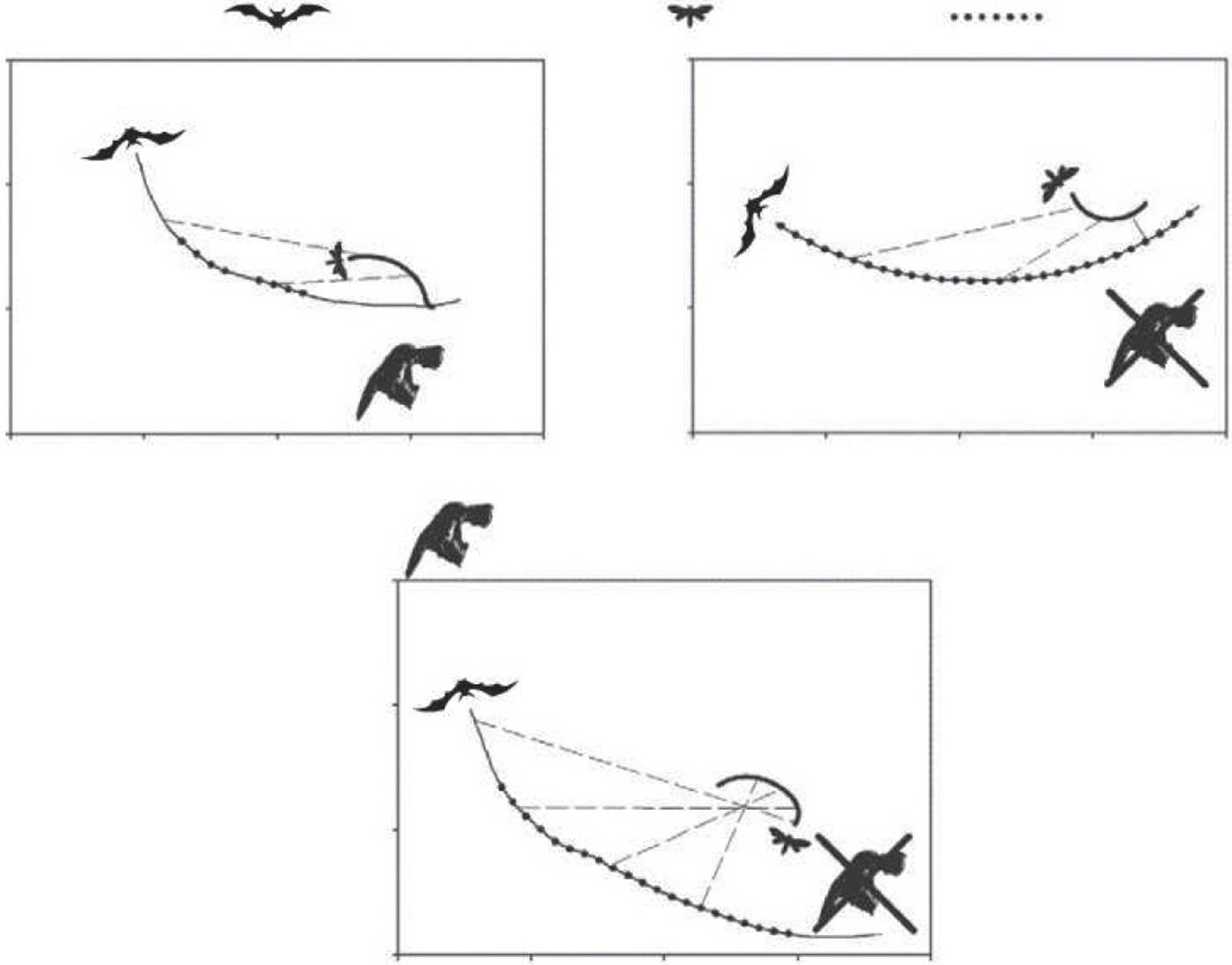
This image adapted from the Journal of Experimental Biology © 2011.
43.Which of the following provides accurate information based on the diagrams?
A)NO CHANGE
B)attack other animals they find easier to detect,
C)fly after one another, bonking their heads together,
D)hear no sounds at all,
44.In the context of the passage as a whole, the best placement for paragraph 5 would be
A)where it is now.
B)after paragraph 1.
C)after paragraph 2.
D)after paragraph 3.
S T O P
If you finish before time is called, you may check your work on this section only. Do not turn to any other section in the test.

Math Test – No Calculator
25 MINUTES, 20 QUESTIONS
Turn to Section 3 of your answer sheet to answer the questions in this section.
DIRECTIONS
For questions 1-15, solve each problem, choose the best answer from the choices provided, and fill in the corresponding circle on your answer sheet. For questions 16-20, solve the problem and enter your answer in the grid on the answer sheet. Please refer to the directions before question 16 on how to enter your answers in the grid. You may use any available space in your test booklet for scratch work.
NOTES
1.The use of a calculator is not permitted.
2.All variables and expressions used represent real numbers unless otherwise indicated.
3.Figures provided in this test are drawn to scale unless otherwise indicated.
4.All figures lie in a plane unless otherwise indicated.
5.Unless otherwise indicated, the domain of a given function f is the set of all real numbers x for which f(x) is a real number.
REFERENCE
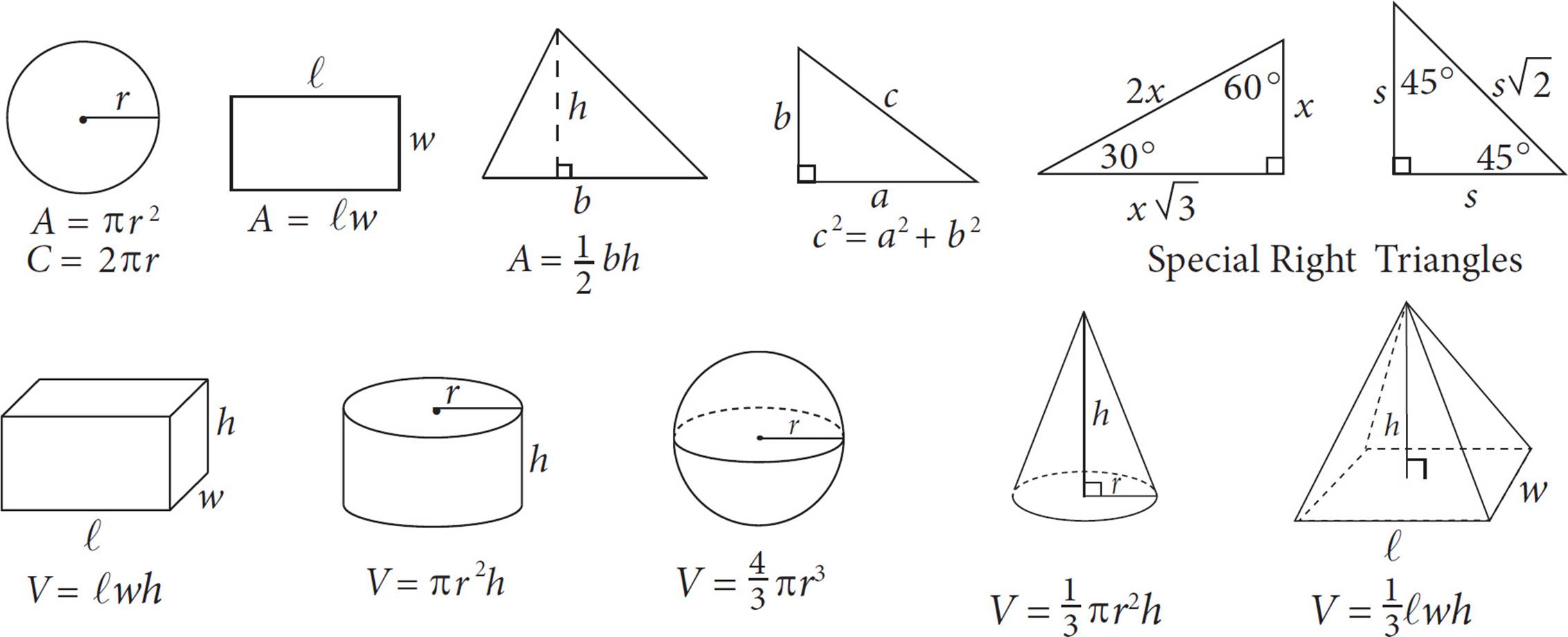
The number of degrees of arc in a circle is 360.
The number of radians of arc in a circle is 2π.
The sum of the measures in degrees of the angles of a triangle is 180.
1.Which of the following equations has a vertex of (3, −3) ?
A)y = 5(x − 3)2 − 3
B)y = 5(x + 3)2 − 3
C)y = 5(x − 3)2 + 3
D)y = 5(x + 3)2 + 3
2.A beverage store charges a base price of x dollars for one keg of root beer. A sales tax of a certain percentage is applied to the base price, and an untaxed deposit for the keg is added. If the total amount, in dollars, paid at the time of purchase for one keg is given by the expression 1.07x + 17, then what is the sales tax, expressed as a percentage of the base price?
A)0.07%
B)1.07%
C)7%
D)17%
3.Syed took out a cash advance of d dollars from a financing company. The company deducts a fee of ![]() of the original advanced amount along with a wire transfer fee of $30.00. Which of the following represents the final advanced amount that Syed receives after all applied fees, in dollars?
of the original advanced amount along with a wire transfer fee of $30.00. Which of the following represents the final advanced amount that Syed receives after all applied fees, in dollars?
A)![]() d − 30
d − 30
B)![]() (d − 30)
(d − 30)
C)![]() (d − 30)
(d − 30)
D)![]() d − 30
d − 30
4.What is the equation of a line that contains the point (1, 6) and has a y-intercept of 4 ?
A)y = ![]() x + 4
x + 4
B)y = x + 4
C)y = 2x + 4
D)y = 4x + 2
5.The number of bonus points, B(p), that a credit card holder receives is given by the function B(p) = 4p + 7, where p represents the number of purchases made. If the number of purchases is increased by 3, by how much does the number of bonus points increase?
A) 3
B) 4
C)12
D)19
6.Jeff tests how the total volume occupied by a fluid contained in a graduated cylinder changes when round marbles of various sizes are added. He found that the total volume occupied by the fluid, V, in cubic centimeters, can be found using the equation below, where x equals the number of identical marbles Jeff added, one at a time, to the cylinder, and r is the radius of one of the marbles.

If the volume of the graduated cylinder is 96π cubic centimeters, then, what is the maximum number of marbles with a radius of 3 centimeters that Jeff can add without the volume of the fluid exceeding that of the graduated cylinder?
A)1
B)2
C)3
D)4
7.If b is two more than one-third of c, which of the following expresses the value of c in terms of b ?
A)c = 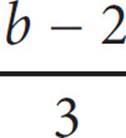
B)c = 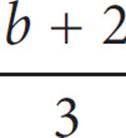
C)c = 3(b − 2)
D)c = 3(b − 6)
8.The rotation rate of a mixing blade, in rotations per second, slows as a liquid is being added to the mixer. The blade rotates at 1,000 rotations per second when the mixer is empty. The rate at which the blade slows is four rotations per second less than three times the square of the height of the liquid. If h is the height of liquid in the mixer, which of the following represents R(h), the rate of rotation?
A)4 − 9h2
B)1,000 − (4 − 3h)
C)1,000 − (9h − 4)
D)1,000 − (3h2 − 4)
9.A dental hygiene company is creating a new 24-ounce tube of toothpaste by combining its most popular toothpastes, Cavity Crusher and Bad Breath Obliterator. Cavity Crusher contains 0.25% of sodium fluoride as its active ingredient, and Bad Breath Obliterator contains 0.30% of triclosan as its active ingredient for a total of 0.069 ounces of active ingredients in both toothpastes. Solving which of the following systems of equations yields the number of ounces of Cavity Crusher, c, and the number of ounces of Bad Breath Obliterator, b, that are in the new toothpaste?
A) c + b = 0.069
0.25c + 0.3b = 24
B) c + b = 24
0.0025c + 0.003b = 0.069
C) c + b = 24
0.025c + 0.03b = 0.069
D) c + b = 24
0.25c + 0.3b = 0.069
10.

In the equation above, what is the value of d ?
A)−4
B) 2
C) 4
D) 6
11.Which of the following is a possible equation for a circle that is tangent to both the x-axis and the line x = 4 ?
A)(x + 2)2 + (y + 2)2 = 4
B)(x + 2)2 + (y − 2)2 = 4
C)(x − 2)2 + (y + 4)2 = 4
D)(x − 6)2 + (y − 2)2 = 4
12.Reactant A is placed in a beaker, to which Reactant B will be added. Reactants A and B will not react unless B gets to a certain concentration. Once the reaction starts, both concentrations decrease until B has been consumed. Which of the following graphs, showing concentration in moles as a function of time in seconds, represents the reaction?
A)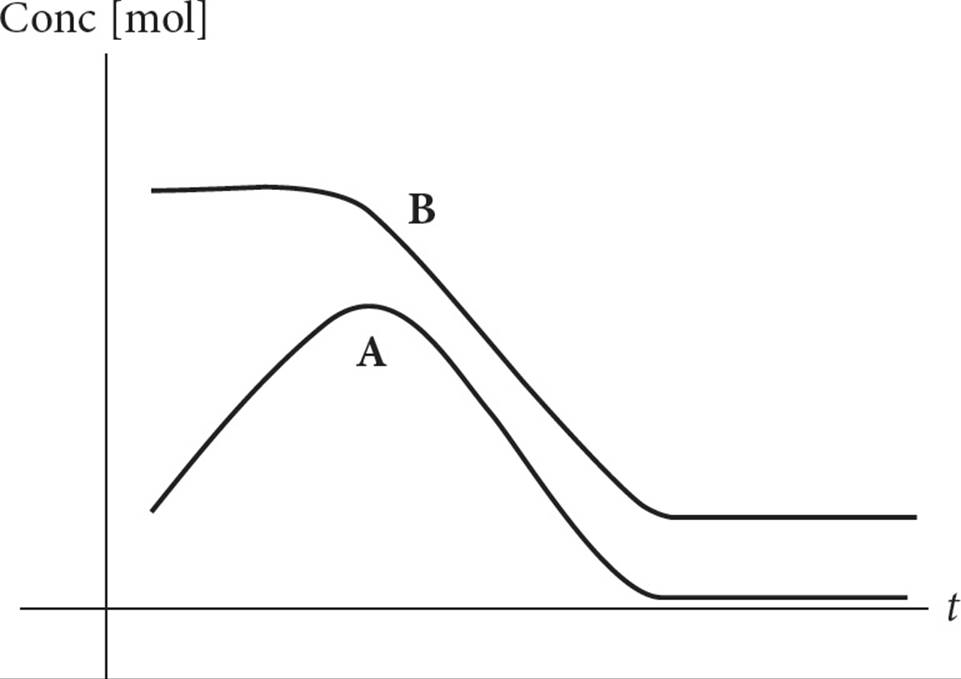
B)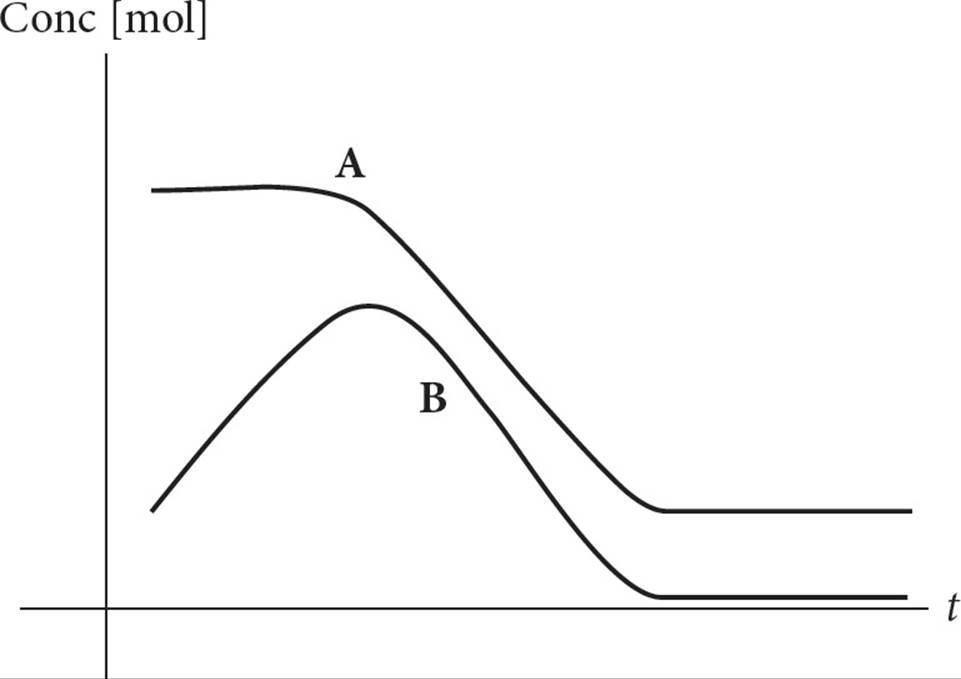
C)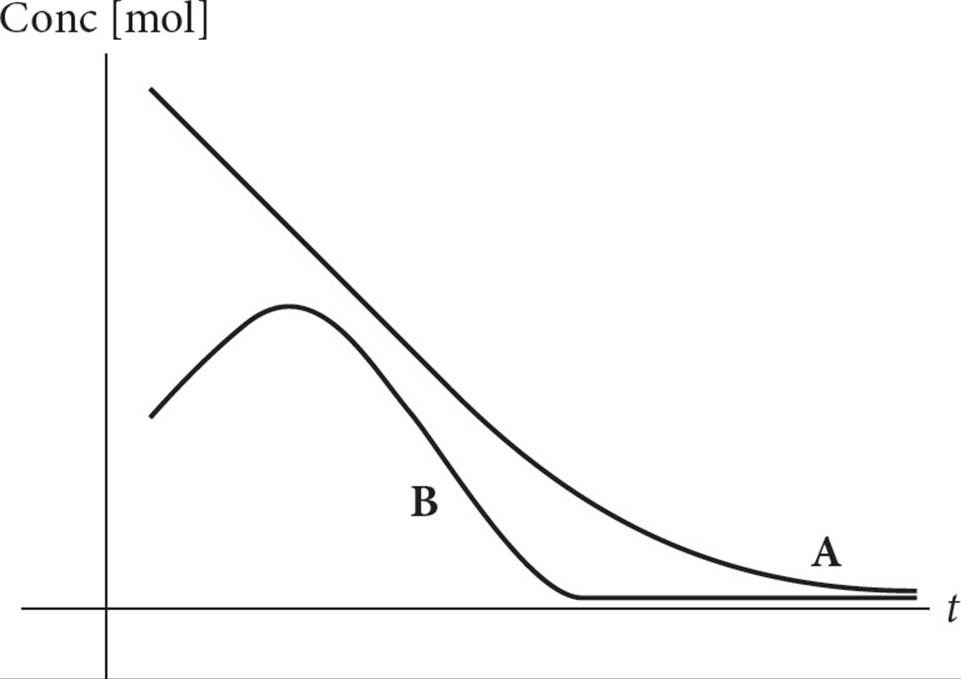
D)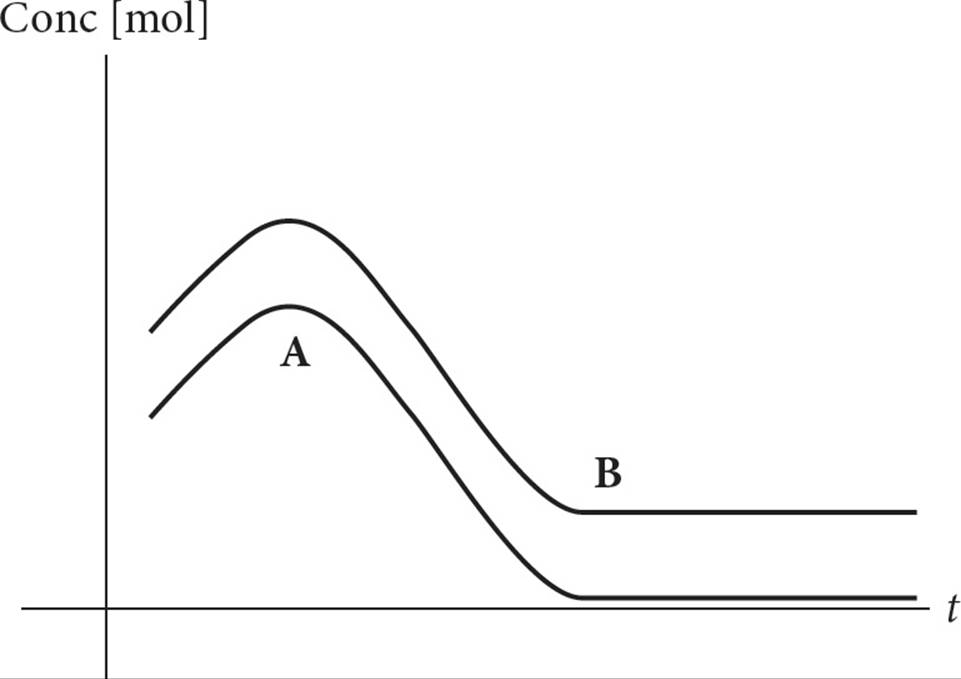
13.
−2y ≤ 8
y − 3 ≤ x
−![]() y + 1 ≥ x
y + 1 ≥ x
Which of the following graphs shows the solution to the system of inequalities above?
A)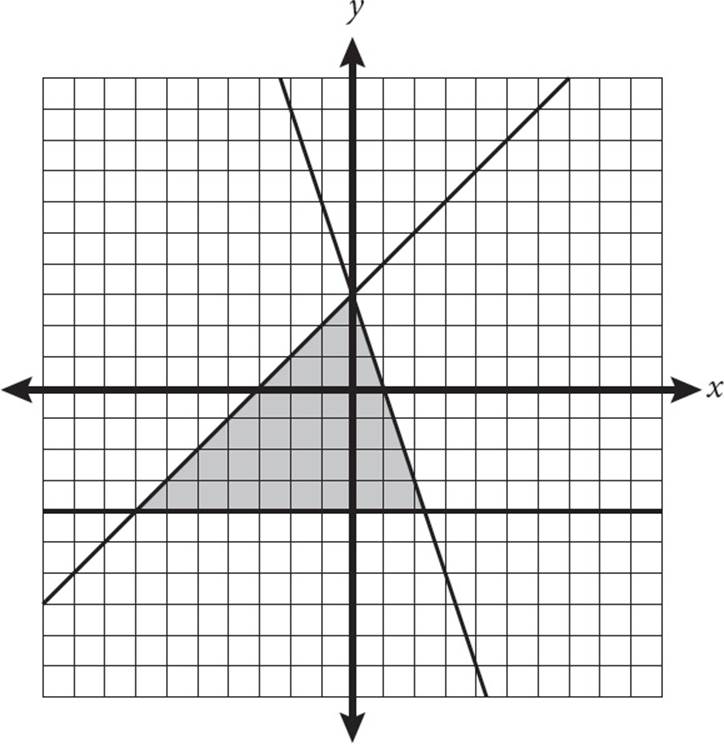
B)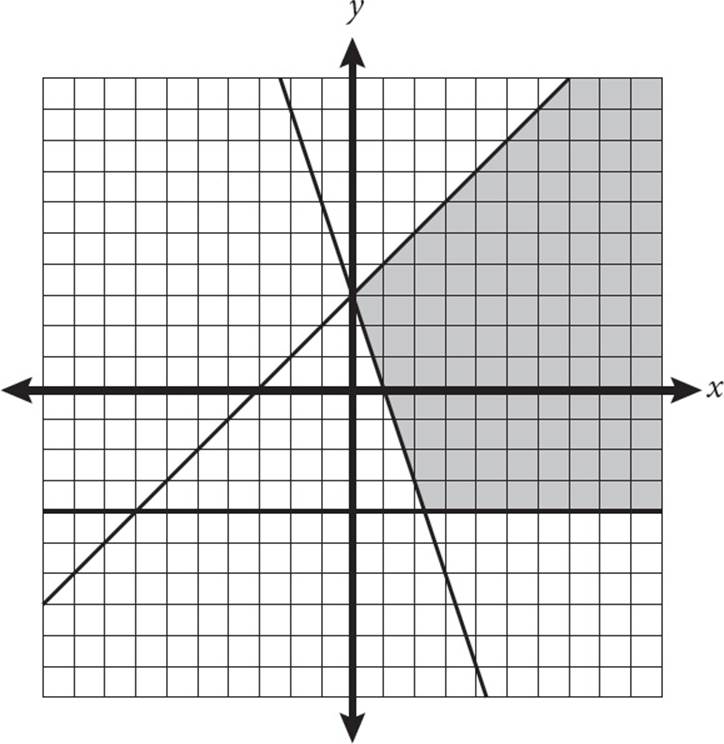
C)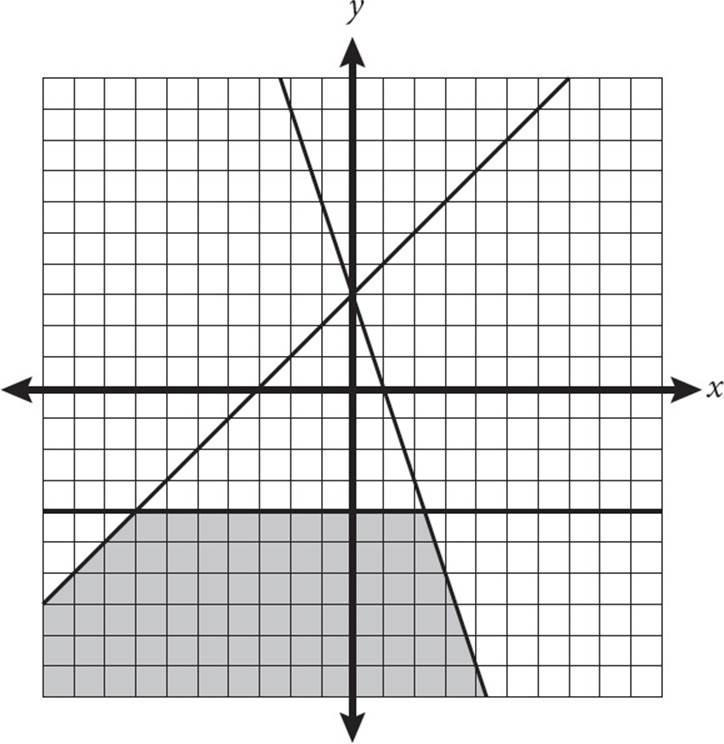
D)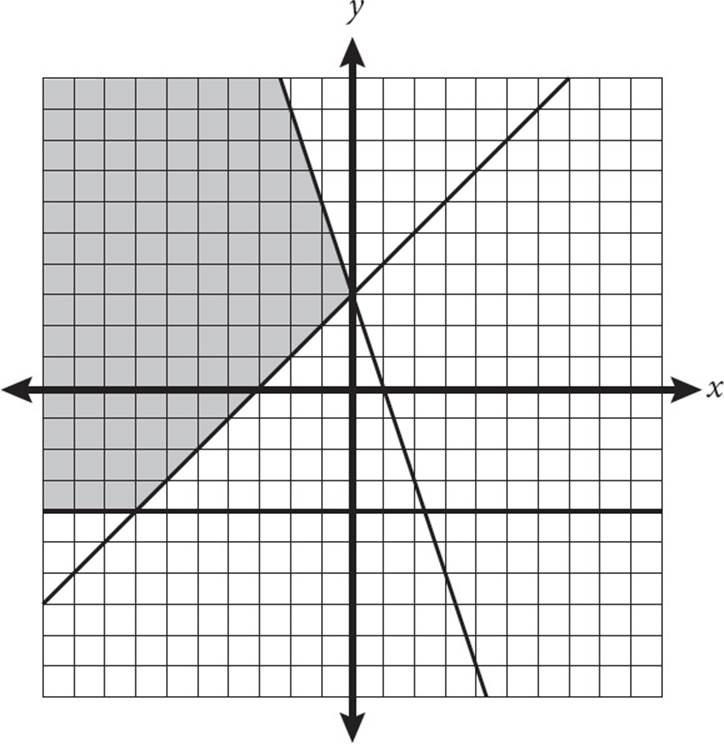
14.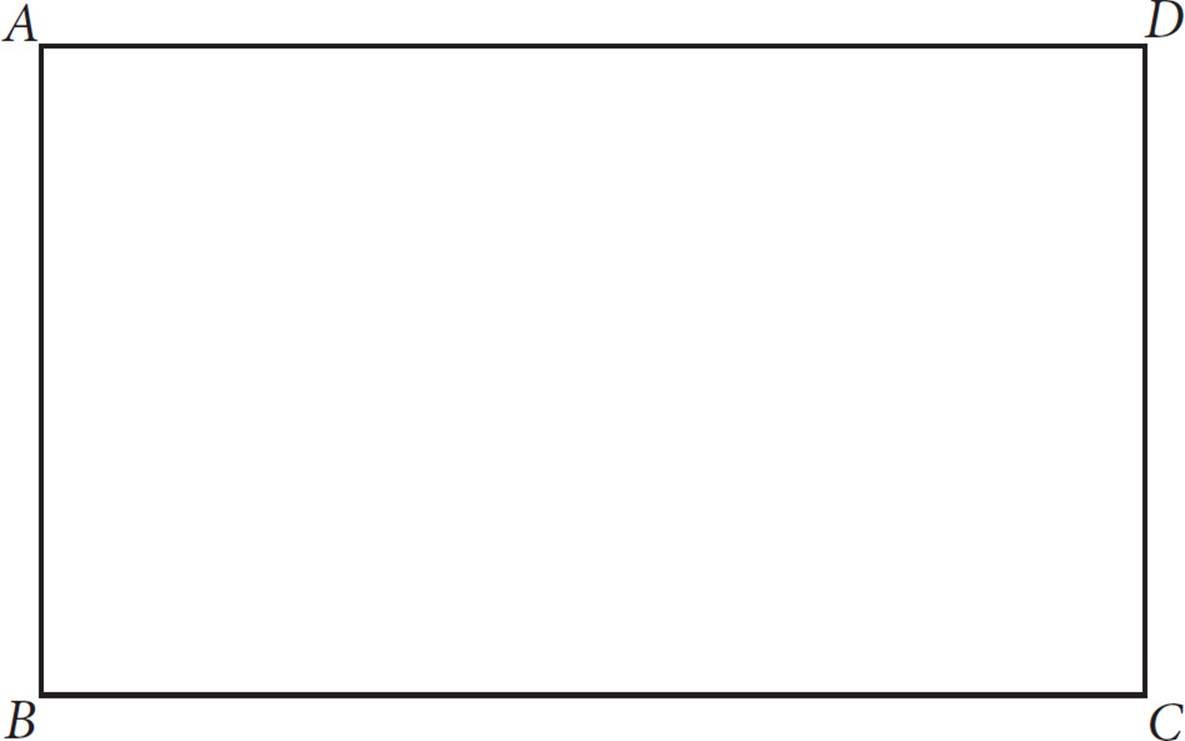
If rectangle ABCD has an area of 324 and the tangent of ∠BCA (not shown) is ![]() , then which of the following is closest to the length of BD (not shown)?
, then which of the following is closest to the length of BD (not shown)?
A)9.8
B)27
C)29.5
D)It cannot be determined from the given information.
15.Which of the following is equivalent to  ?
?
A)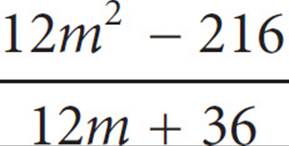
B)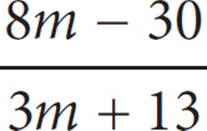
C)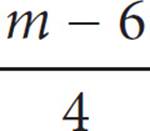
D)m − 6
DIRECTIONS
For questions 16-20, solve the problem and enter your answer in the grid, as described below, on the answer sheet.
1.Although not required, it is suggested that you write your answer in the boxes at the top of the columns to help you fill in the circles accurately. You will receive credit only if the circles are filled in correctly.
2.Mark no more than one circle in any column.
3.No question has a negative answer.
4.Some problems may have more than one correct answer. In such cases, grid only one answer.
5.Mixed numbers such as 3![]() must be gridded as 3.5 or 7/2. (If
must be gridded as 3.5 or 7/2. (If 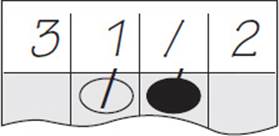 is entered into the grid, it will be interpreted as
is entered into the grid, it will be interpreted as ![]() , not as 3
, not as 3![]() .)
.)
6.Decimal Answers: If you obtain a decimal answer with more digits than the grid can accomodate, it may be either rounded or truncated, but it must fill the entire grid.
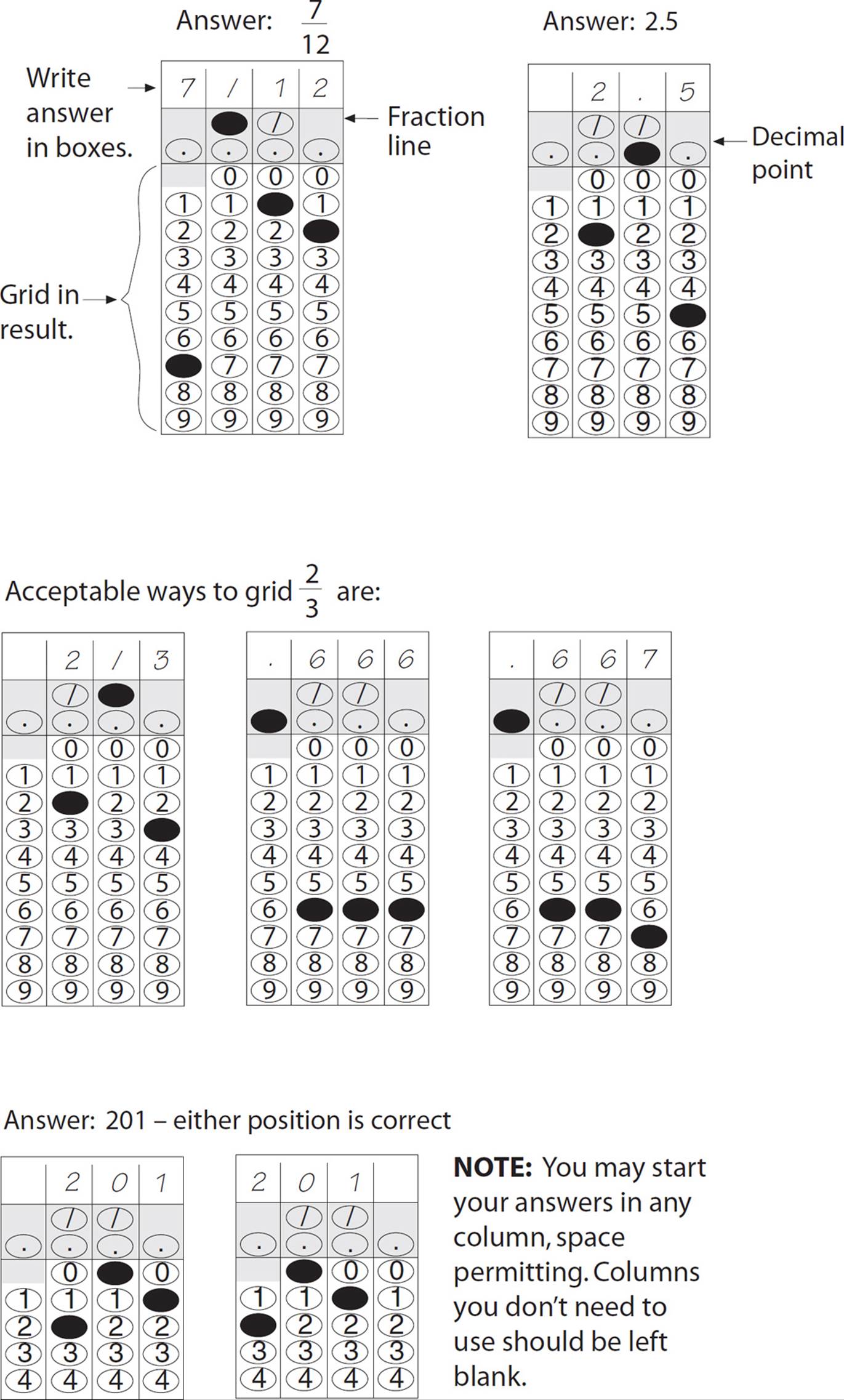
16.A rectangular box has sides 3, 4, and x and a volume of 18. What is the value of x ?
17.Jeanne babysits Chuy one day each week. Jeanne charges a $20 fee for the day, plus $5.50 for every 30 minutes of babysitting. How much has Jeanne earned after three hours of babysitting? (Disregard the $ sign when gridding your answer.)
18.The parabola y = −x2 + 5x + 6 is intersected by the line y = − ![]() x + 12. What is the y-coordinate of the intersection closest to the x-axis?
x + 12. What is the y-coordinate of the intersection closest to the x-axis?
19.
13r + 8v = 47
22v = 63 − 17r
Based on the system of equations above, what is the sum of r and v ?
20.A gardener has a cultivated plot that measures 4 feet by 6 feet. Next year, she wants to double the area of her plot by increasing the length and width by x feet. What is the value of x ?
S T O P
If you finish before time is called, you may check your work on this section only. Do not turn to any other section in the test.

Math Test – Calculator
55 MINUTES, 38 QUESTIONS
Turn to Section 4 of your answer sheet to answer the questions in this section.
DIRECTIONS
For questions 1-30, solve each problem, choose the best answer from the choices provided, and fill in the corresponding circle on your answer sheet. For questions 31-38, solve the problem and enter your answer in the grid on the answer sheet. Please refer to the directions before question 31 on how to enter your answers in the grid. You may use any available space in your test booklet for scratch work.
NOTES
1.The use of a calculator is permitted.
2.All variables and expressions used represent real numbers unless otherwise indicated.
3.Figures provided in this test are drawn to scale unless otherwise indicated.
4.All figures lie in a plane unless otherwise indicated.
5.Unless otherwise indicated, the domain of a given function f is the set of all real numbers x for which f(x) is a real number.
REFERENCE

The number of degrees of arc in a circle is 360.
The number of radians of arc in a circle is 2π.
The sum of the measures in degrees of the angles of a triangle is 180.
1.The population, P, of Town Y since 1995 can be estimated by the equation P = 1.0635x + 3,250, where x is the number of years since 1995 and 0 ≤ x ≤ 20. In the context of this equation, what does the number 1.0635 most likely represent?
A)The estimated population of town Y in 1995
B)The estimated population of town Y in 2015
C)The factor by which the population of town Y increased yearly
D)The factor by which the population of town Y decreased yearly
2.If x2 + 12x = 64 and x > 0, what is the value of x ?
A) 2
B) 4
C) 8
D)16
3.Sai is ordering new shelving units for his store. Each unit is 7 feet in length and extends from floor to ceiling. Sai’s store has 119 feet of wall space that includes 21 feet of windows along the walls. If the shelving units cannot be placed in front of the windows, which of the following inequalities includes all possible values of r, the number of shelving units that Sai could use?
A)r ≤ 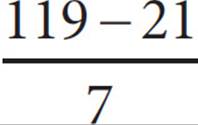
B)r ≥ 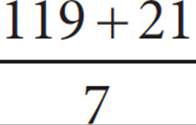
C)r ≤ 119 − 21 + 7r
D)r ≥ 119 + 21 − 7r
4.
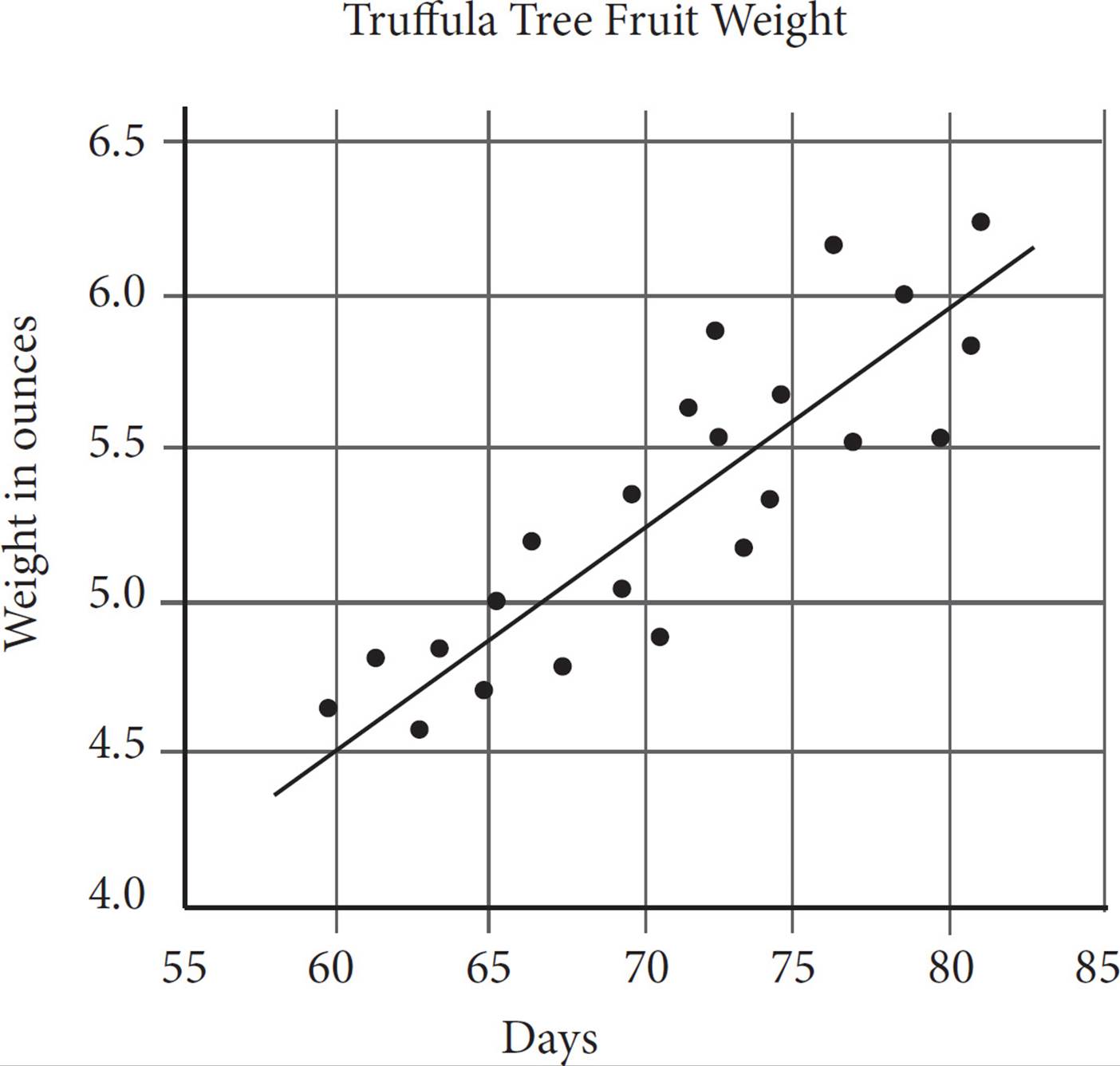
The scatterplot above shows the weight, in ounces, of the fruits on a certain truffula tree from days 55 to 85 after flowering. According to the line of best fit in the scatterplot above, which of the following is the closest approximation of the number of days after flowering of a truffula fruit that weighs 5.75 ounces?
A)63
B)65
C)77
D)81
5.Hannah placed an online order for shirts that cost $24.50 per shirt. A tax of 7% is added to the cost of the shirts, before a flat, untaxed shipping rate of $6 is charged. Which of the following represents Hannah’s total cost for s shirts, in dollars?
A)0.07(24.50s + 6)
B)1.07(24.50 + 6)s
C)1.07(24.50s) + 6
D)1.07(24.50 + s) + 6
6.Once a certain plant begins to grow, its height increases at a linear rate. After six weeks, the plant is 54 centimeters tall. Which of the following functions best models the relationship between h(w), the height, in centimeters, of the plant, and w, the number of weeks that the plant has been growing?
A)h(w) = 6w
B)h(w) = 9w
C)h(w) = 54w
D)h(w) = 54 + w
7.Which of the following is equivalent to (12x2 + 4x + 5y) + (3x2 − 2x + 3y) ?
A)2x2 − 2x + 8y
B)2x2 + 15x + 8y
C)15x2 − 2x + 8y
D)15x2 + 2x + 8y
8.An advertisement for Royal Rat Rations states: “7 out of 8 veterinarians recommend Royal Rat Rations for your fancy rat.” No other information about the data is provided by the company.
Based on this data, which of the following inferences is most valid?
A)Royal Rat Rations provides the best nutrition for fancy rats.
B)If you do not feed your rat Royal Rat Rations, your rat will be unhealthy.
C)Only one veterinarian does not recommend Royal Rat Rations for your fancy rat.
D)Of the veterinarians surveyed by Royal Rat Rations, the majority recommend Royal Rat Rations for your fancy rat.
9.
![]() t + 4 =
t + 4 = ![]() t − 5
t − 5
In the equation above, what is the value of t ?
A) 4
B) 9
C)18
D)36
10.Dogs need 8.5 to 17 ounces of water each day for every 10 pounds of their weight. Everett has two dogs—Ringo is a 35-pound black lab mix, and Elvis is a 55-pound beagle. Which of the following ranges represents the approximate total number of ounces of water, w, that Elvis and Ringo need in a week?
A)77 ≤ w ≤ 153
B)109 ≤ w ≤ 218
C)536 ≤ w ≤ 1,071
D)765 ≤ w ≤ 1,530
11.Priya is planning to send her favorite dry rub recipe to a friend who lives in France. Before sending the recipe, Priya wants to convert the American customary units in the instructions into metric units so that her friend will easily be able to understand the measurements. If the recipe calls for a ratio of four ounces of paprika to every seven ounces of chili powder, and if Priya’s friend is planning to make a large batch of dry rub with 91 total ounces of chili powder, approximately how many total grams of paprika and chili powder will the recipe require? (1 ounce = 28.3 grams)
A)4,047 grams
B)4,521 grams
C)4,925 grams
D)5,149 grams
12.Luciano measured the amount of water that evaporated over a period of time from a container holding w ounces of water, where w is greater than 12. By the end of the first day, the cup had lost 2 ounces of water. By the end of the 7th day, the cup had lost an additional 8 ounces of water. By the end of the 11th day, the cup had lost half of the water that remained after the 7th day. Which of the following represents the remaining amount of water, in ounces, in Luciano’s container at the end of the 11th day?
A)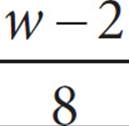
B)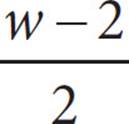 − 10
− 10
C)![]() w − 10
w − 10
D)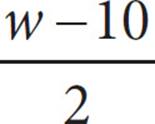
![]()
Questions 13 and 14 refer to the following information.
In the 1990s, the park rangers at Yellowstone National Park implemented a program aimed at increasing the dwindling coyote population in Montana. Results of studies of the coyote population in the park are shown in the scatterplot below.
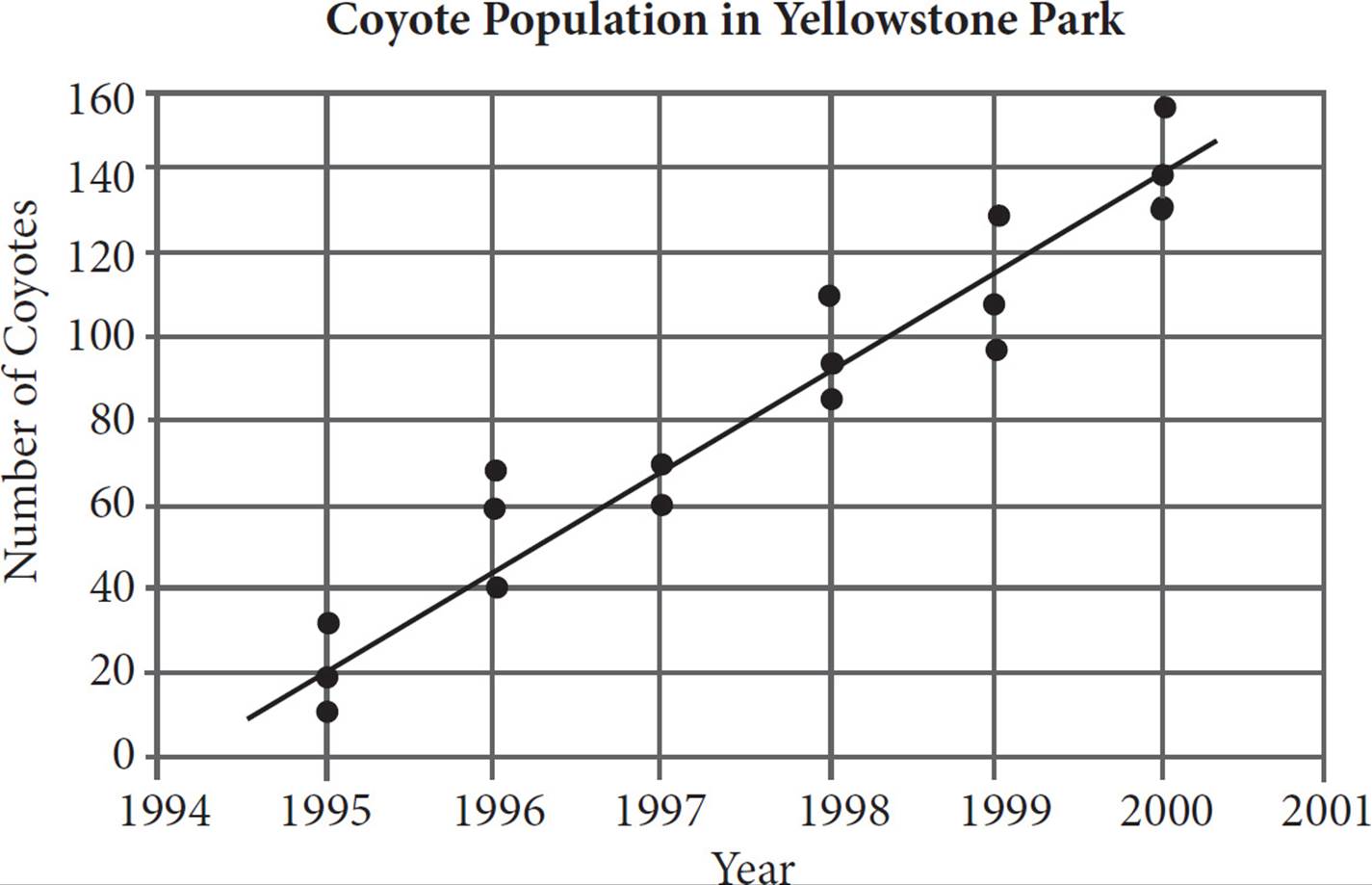
13.Based on the line of best fit in the scatterplot above, which of the following is the closest to the average annual increase in coyotes in Yellowstone Park between 1995 and 2000 ?
A)22
B)24
C)26
D)28
14.According to the data in the scatterplot, which of the following best represents the percent increase between the median of the results of the studies from 1995 and the median of the results of the studies from 1996 ?
A) 50%
B)100%
C)150%
D)200%
![]()
15.Bailey’s Boutique Clothing is having a 20% off sale during which shirts cost $30.00 and pants cost $60.00. On the day of the sale, Bailey’s sells ![]() a total of 60 shirts and pants and earned a total of $2,250. On a regular day, Bailey’s sellsthe number of shirts and pants sold during the sale and earns a total of $1,875. Solving which of the following systems of equations yields the number of shirts, s, and the number of pants, p, sold during a regular day?
a total of 60 shirts and pants and earned a total of $2,250. On a regular day, Bailey’s sellsthe number of shirts and pants sold during the sale and earns a total of $1,875. Solving which of the following systems of equations yields the number of shirts, s, and the number of pants, p, sold during a regular day?
A) s + p = 40
37.5s + 75p = 1,875
B) s + p = 40
30s + 60p = 2,250
C) s + p = 60
30s + 60p = 2,250
D) s + p = 2,250
30s + 60p = 60
16.Bryan, who works in a high-end jewelry store, earns a base pay of $10.00 per hour plus a certain percent commission on the sales that he helps to broker in the store. Bryan worked an average of 35 hours per week over the past two weeks and helped to broker sales of $5,000.00 worth of jewelry during that same two-week period. If Bryan’s earnings for the two-week period were $850.00, what percent commission on sales does Bryan earn?
A)1%
B)2%
C)3%
D)4%
17.If  , which of the following could be an expression of C in terms of x ?
, which of the following could be an expression of C in terms of x ?
A)3(1 + x)
B)x2 + 2x − 24
C)![]() (x + 6)(x − 4)
(x + 6)(x − 4)
D) ![]() (x − 3)(x + 8)
(x − 3)(x + 8)
18.Lennon has 6 hours to spend in Ha Ha Tonka State Park. He plans to drive around the park at an average speed of 20 miles per hour, looking for a good trail to hike. Once he finds a trail he likes, he will spend the remainder of his time hiking it. He hopes to travel more than 60 miles total while in the park. If he hikes at an average speed of 1.5 miles per hour, which of the following systems of inequalities can be solved for the number of hours Lennon spends driving, d, and the number of hours he spends hiking, h, while he is at the park?
A) 1.5h + 20d > 60
h + d ≤ 6
B) 1.5h + 20d > 60
h + d ≥ 6
C) 1.5h + 20d < 60
h + d ≥ 360
D) 20h + 1.5d > 6
h + d ≤ 60
19.In a certain sporting goods manufacturing company, a quality control expert tests a randomly selected group of 1,000 tennis balls in order to determine how many contain defects. If this quality control expert discovered that 13 of the randomly selected tennis balls were defective, which of the following inferences would be most supported?
A)98.7% of the company’s tennis balls are defective
B)98.7% of the company’s tennis balls are not defective
C)9.87% of the company’s tennis balls are defective
D)9.87% of the company’s tennis balls are not defective
20.If −  < −3z + 6 < −
< −3z + 6 < − ![]() , what is the greatest possible integer value of 9z − 18 ?
, what is the greatest possible integer value of 9z − 18 ?
A)6
B)7
C)8
D)9
21.
−24 − 8j = 12k
3 + ![]() k = −
k = − ![]() j
j
Which of the following ordered pairs (j, k) is the solution to the system of equations above?
A)(6, −6)
B)(3, 0)
C)(0, 2)
D)(−4, 1)
22.
United States Investment in
Alternative Energy Sources
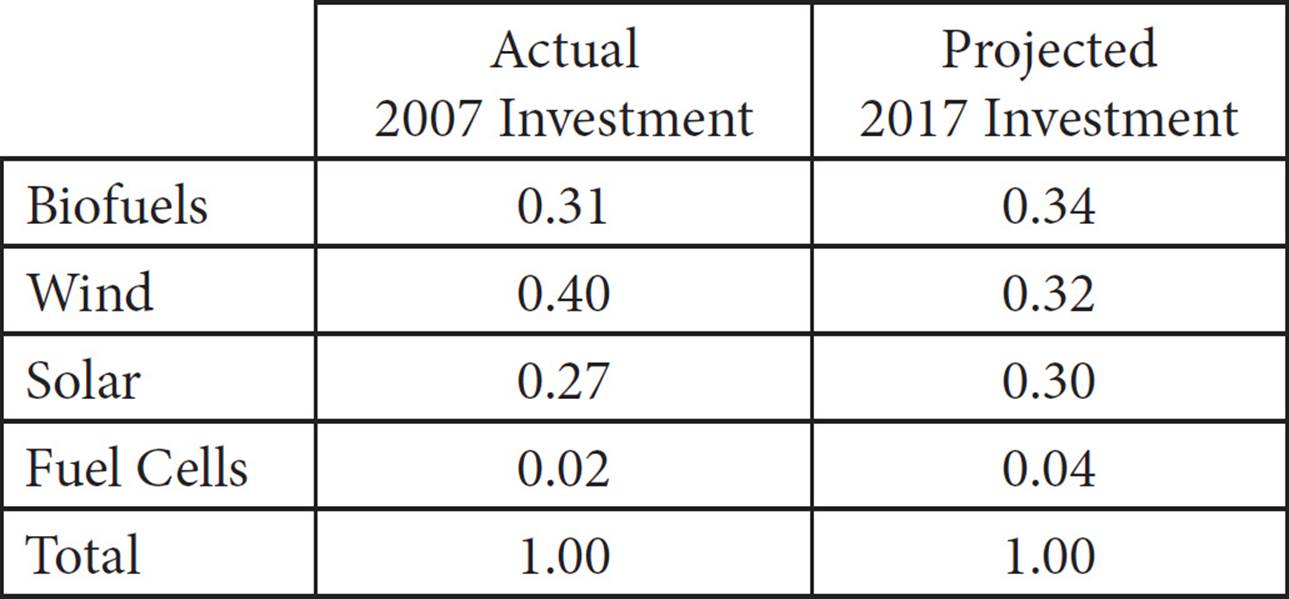
The table above shows the relative investment in alternative energy sources in the United States by type. One column shows the relative investment in 2007 of $75 million total invested in alternative energy. The other column shows the projected relative investment in 2017 given current trends. The total projected investment in alternative energy in 2017 is $254 million. Suppose that a new source of alternative energy, Cold Fusion, is perfected. It is projected that by 2017 that $57 million will be invested in Cold Fusion in the United States, without any corresponding reduction in investment for any other form of alternative energy. What portion of the total investment of alternative energy in the United States will be spent on biofuels?
A)0.18
B)0.22
C)0.28
D)0.34
23.
(x − 2)2 + y2 = 36
y = −x + 2
The equations above represent a circle and a line that intersects the circle across its diameter. What is the point of intersection of the two equations that lies in quadrant II?
A)(−3 , 3
, 3 )
)
B)(−4, 2)
C) (2 +  , 2)
, 2)
D) (2 − 3 , 3
, 3 )
)
24.
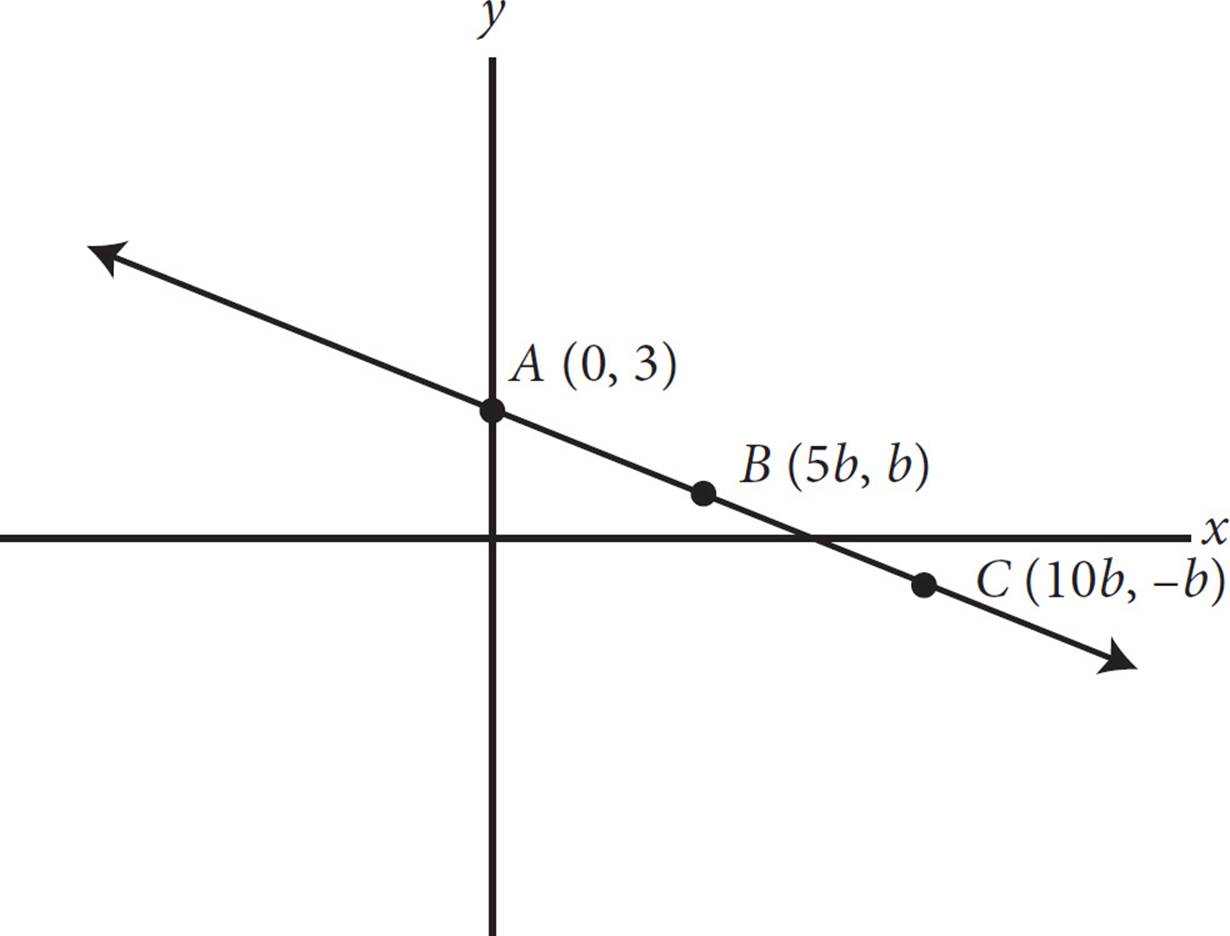
The graph of f(x) is shown above in the xy-plane. The points (0, 3), (5b, b), and (10b, −b) are on the line described by f(x). If b is a positive constant, what are the coordinates of point C ?
A)(5, 1)
B)(10, −1)
C)(15, −0.5)
D)(20, −2)
25.Melanie puts $1,100 in an investment account that she expects will make 5% interest for each three-month period. However, after a year she realizes she was wrong about the interest rate and she has $50 less than she expected. Assuming the interest rate the account earns is constant, which of the following equations expresses the total amount of money, x, she will have after t years using the actual rate?
A)x = 1,100(1.04)4t
B)x = 1,100(1.05)4t − 50
C)x = 1,100(1.04)t/3
D)x = 1,100(1.035)4t
26.
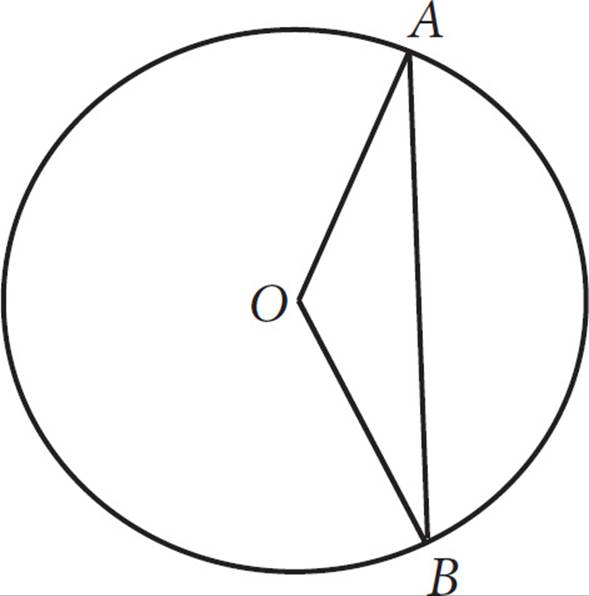
If the radius of the circle above is x, ∠AOB = 120°, and O is the center of the circle, what is the length of chord AB in terms of x ?
A) x
x
B) x
x
C)
D)
27.Students in a physics class are studying how the angle at which a projectile is launched on level ground affects the projectile’s hang time and horizontal range. Hang time can be calculated using the formula t = 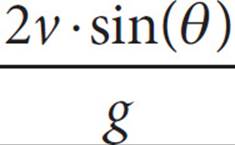 ,where t is the hang time in seconds, v is the initial launch velocity, θ is the projectile angle with respect to level ground, and g is the acceleration due to gravity, defined as 9.8 m/s2. Horizontal range can be calculated using the formula R =
,where t is the hang time in seconds, v is the initial launch velocity, θ is the projectile angle with respect to level ground, and g is the acceleration due to gravity, defined as 9.8 m/s2. Horizontal range can be calculated using the formula R =  , where R is the distance the projectile travels from the launch site, in feet. Which of the following gives the value of v, in terms of R, t, and θ ?
, where R is the distance the projectile travels from the launch site, in feet. Which of the following gives the value of v, in terms of R, t, and θ ?
A)v = 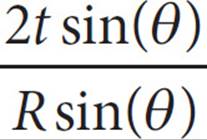
B)v = 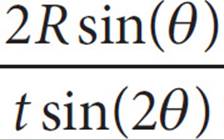
C)v = 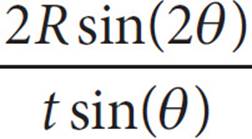
D)v = 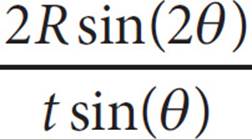
28.If (i413)(ix) = 1, then what is one possible value of x ?
A)0
B)1
C)2
D)3
29.The function g is defined by g(x) = 2x2 − dx − 6, where d is a constant. If one of the zeros of g is 6, what is the value of the other zero of g ?
A)2
B)![]()
C)− ![]()
D)−2
30.The flu shot for a flu season is created from four strains of the flu virus, named Strain A, B, C, and D, respectively. Medical researchers use the following data to determine the effectiveness of the vaccine over the flu season. Table 1 shows the effectiveness of the vaccine against each of these strains individually. The graph below the table shows the prevalence of each of these strains during each month of the flu season, represented as a percentage of the overall cases of flu that month.
Table 1
|
Strain |
Effectiveness |
|
A |
35% |
|
B |
13% |
|
C |
76% |
|
D |
68% |
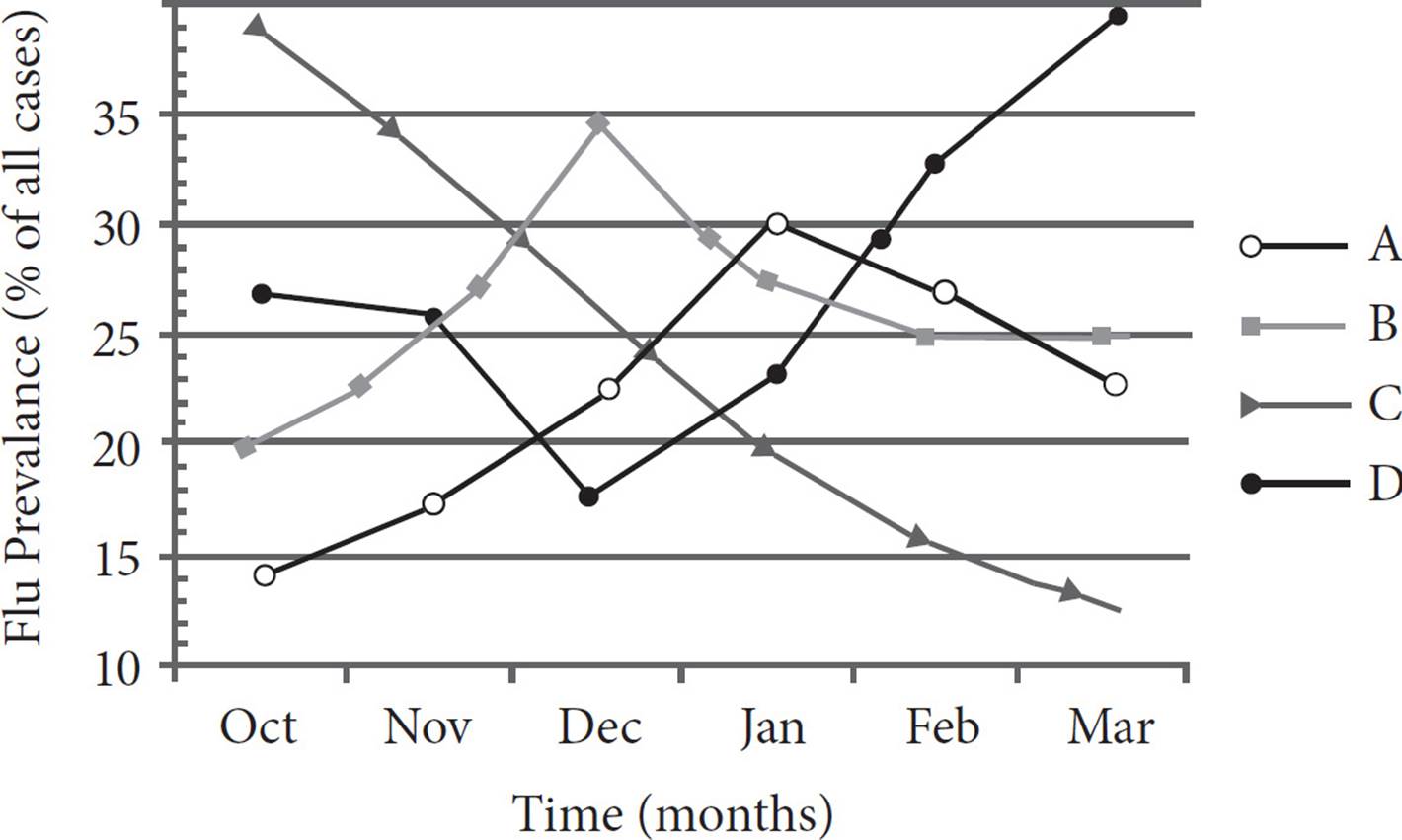
For the strain against which the flu shot was the most effective, approximately how effective was the shot overall when that strain was least prevalent?
A)13%
B)20%
C)27%
D)48%
DIRECTIONS
For questions 31-38, solve the problem and enter your answer in the grid, as described below, on the answer sheet.
1.Although not required, it is suggested that you write your answer in the boxes at the top of the columns to help you fill in the circles accurately. You will receive credit only if the circles are filled in correctly.
2.Mark no more than one circle in any column.
3.No question has a negative answer.
4.Some problems may have more than one correct answer. In such cases, grid only one answer.
5.Mixed numbers such as 3![]() must be gridded as 3.5 or 7/2. (If
must be gridded as 3.5 or 7/2. (If  is entered into the grid, it will be interpreted as
is entered into the grid, it will be interpreted as ![]() , not as 3
, not as 3![]() .)
.)
6.Decimal Answers: If you obtain a decimal answer with more digits than the grid can accomodate, it may be either rounded or truncated, but it must fill the entire grid.

31.If 9 > 3v − 3, what is the greatest possible integer value of v ?
32.In the expression 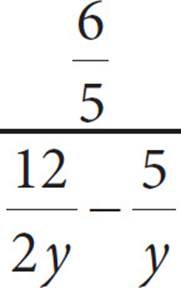 = 1, what is the value of y ?
= 1, what is the value of y ?
33.During a presidential election, a high school held its own mock election. Students had the option to vote for Candidate A, Candidate B, or several other candidates. They could also choose to spoil their ballot. The table below displays a summary of the election results.
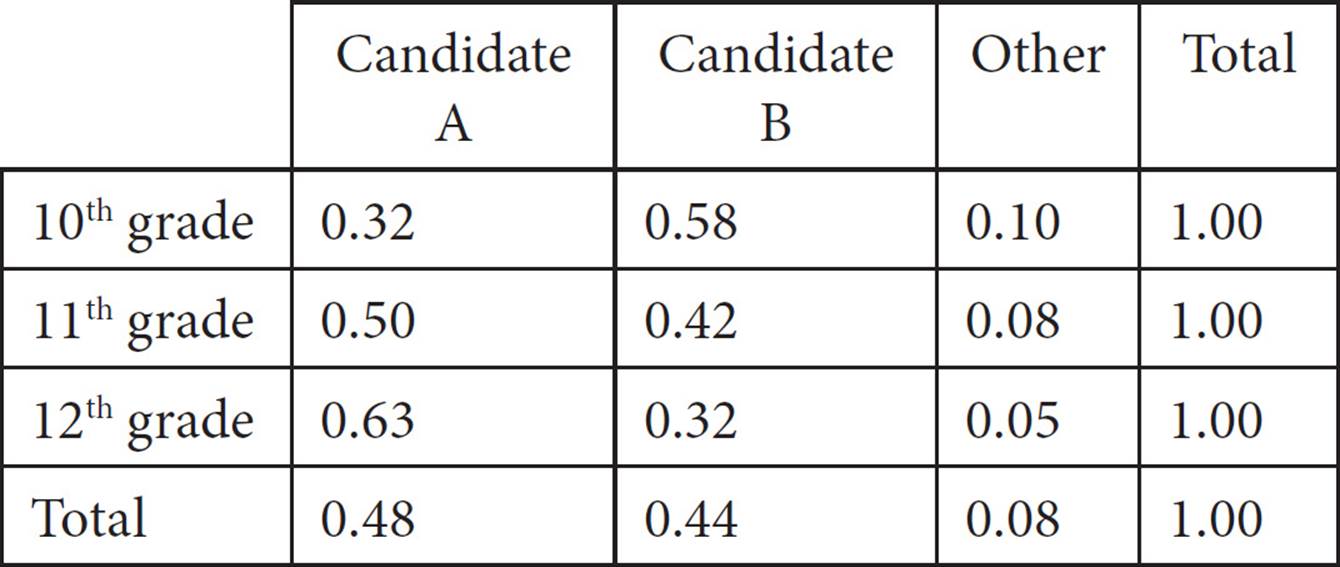
614 students voted for Candidate A. Approximately how many students attend the school?
34.If θ = ![]() , then cos θ =
, then cos θ =
35.Marcellus is traveling abroad in Ghana and using traveler’s checks, which he has acquired from Easy Traveler’s Savings Bank. Easy Traveler’s Savings Bank charges a 7% fee on traveler’s checks, which can then be used like cash at any location overseas at the same exchange rate, and any change will then be returned to Marcellus in local currency. For this trip, Marcellus bought a 651 Cedi traveler’s check and paid a fee of 32.30 USD (United States dollars) for the check.
While in Ghana, Marcellus finds Leon’s Pawnshop and Barter, which offers store credit for Marcellus’s briefcase equal to its value in Cedis. If Marcellus’s briefcase is worth 5,000 USD at the same exchange rate at which he bought his traveler’s check, then how much store credit, to the closest Cedi, will Marcellus receive for the briefcase?
36.A square is inscribed in a circle. The area of the square is what percent of the area of the circle? (Disregard the percent symbol when gridding your answer.)
![]()
Questions 37 and 38 refer to the following information.
Professor Malingowski, a chemist and teacher at a community college, is organizing his graduated cylinders in the hopes of keeping his office tidy and setting a good example for his students. He has beakers with diameters, in inches, of ![]() ,
, ![]() ,
, ![]() , 1, and
, 1, and ![]() .
.
37.Professor Malingowski notices one additional cylinder lying on the ground, and can recall certain facts about it, but not its actual diameter. If he knows that the value of the additional graduated cylinder’s diameter, x, will not create any modes and will make the mean of the set equal to ![]() , what is the value of the additional cylinder’s diameter?
, what is the value of the additional cylinder’s diameter?
38.With his original five cylinders, Professor Malingowski realizes that he is missing a cylinder necessary for his upcoming lab demonstration for Thursday’s class. He remembers that the cylinder he needs, when added to the original five, will create a median diameter value of  for the set of six total cylinders. He also knows that the measure of the sixth cylinder will exceed the value of the range of the current five cylinders by a width of anywhere from
for the set of six total cylinders. He also knows that the measure of the sixth cylinder will exceed the value of the range of the current five cylinders by a width of anywhere from ![]() inches to
inches to ![]() inches, inclusive. Based on the above data, what is one possible value of y, the diameter of this missing sixth cylinder?
inches, inclusive. Based on the above data, what is one possible value of y, the diameter of this missing sixth cylinder?
![]()
S T O P
If you finish before time is called, you may check your work on this section only. Do not turn to any other section in the test.
SAT Essay
ESSAY BOOK
DIRECTIONS
The essay gives you an opportunity to show how effectively you can read and comprehend a passage and write an essay analyzing the passage. In your essay you should demonstrate that you have read the passage carefully, present a clear and logical analysis, and use language precisely.
Your essay must be written on the lines provided in your answer sheet booklet; except for the planning page of the answer booklet, you will receive no other paper on which to write. You will have enough space if you write on every line, avoid wide margins, and keep your handwriting to a reasonable size. Remember that people who are not familiar with your handwriting will read what you write. Try to write in print so that what you are writing is legible to those readers.
You have 50 minutes to read the passage and write an essay in response to the prompt provided inside this booklet.
REMINDER
— Do not write your essay in this booklet. Only what you write on the lined pages of your answer booklet will be evaluated.
— An off-topic essay will not be evaluated.
As you read the passage below, consider how the author uses
•evidence, such as facts or examples, to support claims.
•reasoning to develop ideas and to connect claims and evidence.
•stylistic or persuasive elements, such as word choice or appeals to emotion, to add power to the ideas expressed.
Excerpted from “Making A Brain Map That We Can Use” by Alva Noë. Originally published Janurary 16, 2015.
1.It is now conventional wisdom that the brain is the seat of the mind; it is alone through the brain’s workings that we think and feel and know.
2.But what is a brain, anyway?
3.My thoughts turned to this question as I was reading a recent New York Times piece about Sebastian Seung’s project to map the brain by tracing out each of the trillions of links between individual neurons. This undertaking to map the system of connections which make us what we are—to map what Seung called the connectome in his 2011 book—can seem, from a certain point of view, like a glorious and heroic step backward.
4.Trying to understand how the brain works by looking at the behavior of individual cells—so observed David Marr, one of modern cognitive science’s foundational figures writing in the late 1970s—would be like trying to understand how a bird flies by examining the behavior of individual feathers. To understand flight, you need to understand aerodynamics; only once you get a handle on that can you ask how a structure of feathers, or any other physical system—such as a manufactured airship—can harness aerodynamics in the service of flight.
5.And so it is with the brain: Before we can understand how it works, it would seem that we need to understand what it’s doing. But you can’t read that off the action of individual cells. Just try!
6.Imagine you were to stumble one day upon a computer on the beach and imagine (very unrealistically) that you have never seen or heard of a computer before. How would you go about figuring out how it works? Well, one thing you could do would be to make a map of how all the detachable parts of the machine are connected. This piece of metal is soldered to this piece, which is stapled to this piece of plastic. And so on. Suppose you finished the job. Would you know what the thing is before you? Or how it works? Would your complicated, Rube-Goldberg-esque map of the connections between the parts even count as a model of the computer ? Keep in mind that there are lots of different kinds of computers, made of lots of different materials, with lots of different types of parts and networks of connections. In fact, if Alan Turing was right (and Turing was right), the basic and essential job of a computer—the computing of computable functions—can be specified in entirely formal terms; the physical stuff of the computing machine is irrelevant to the question of what computations are being computed and, so, really, it is also irrelevant to the question of how this—or any other computer—works…
7.I’m raising both a practical point and a point of principle. The practical point is that we need some conception of what the whole is for before we have a ghost of a chance of figuring out how it works. This is Marr’s point about feathers and flight. But there is also a matter of principle: When it comes to complex functional systems—like computers, for sure, and, probably, like brains—the laws and regularities and connections that matter are themselves higher-level; they don’t bottom out in laws framed in terms of neuronal units any more than they do in laws framed in terms of quantum mechanical processes. The point is not just that it is hard to understand the brain’s holistic operation in terms of what cells are doing but, instead, that it might be impossible—like trying to understand the stock market in terms of quantum mechanics. Surely, naturalism doesn’t commit us to the view that it ought to be possible to frame a theory of the stock market in the terms of physics?
8.Gareth Cook, who wrote the recent New York Times Magazine article on Seung’s quest, was wise to refer to Argentinian writer Jorge Luis Borges’s cautionary tale, On Exactitude In Science, about a map being built as an exact, to-size replica of the domain being mapped. Such a map can’t serve any explanatory purpose whatsoever. It won’t be a useful map. My worry is that we already know that exactly the same thing is true of Seung’s connectome.
Write an essay in which you explain how Noë builds an argument against the idea of cell-by-cell brain mapping. In your essay, analyze how Noë uses one or more of the features listed above (or features of your own choice) to strengthen the logic and persuasiveness of his argument. Be sure that your analysis focuses on the most relevant aspects of the passage.
Your essay should not explain whether you agree with Redford’s claims, but rather explain how the author builds an argument to persuade his audience.
END OF TEST
DO NOT RETURN TO A PREVIOUS SECTION.